The Best Web Hosting Services (In-Depth Review)
Disclosure: This content is reader-supported, which means if you click on some of our links that we may earn a commission.
Looking for a hosting solution for your website?
You’re in luck because with today’s options, it has never been easier to keep your website online.
They take care of all the technical stuff and you get to enjoy casually updating your website for conversions.
And the best part is that most of them are very affordable which helps startups get a hold of their business quickly.
That’s why I put together a list of the best hosting services of 2020 for you.
So without further ado…
The Top 8 Options For Hosting Your Website in 2020:
How to Choose The Best Hosting Service For Your Website:
When it comes to the best web hosting services you have to look at various important factors.
If you jump in too quick you might get into something that’s not suitable for your business.
But don’t let any of that doubt creep into your mind.
Instead, sit back and relax while we present to you all the factors that you need to be aware of before making a decision.
You can weigh the different web hosting services and decide which is the best solution for your specific business.
Hosting factor #1 – Uptime reliability:
If your hosting is down, no one would be able to access your website.
And obviously you want your website running 24/7.
Luckily, in 2020 this is not a huge problem since most web hosting providers offer a ‘99.99% network uptime guarantee’.
That means that your website would go down very rarely.
And even when it does, you can contact your hosting service and you will get compensation.
Most of the time that would be in the form of hosting credits.
If you want to prepare for the worst, you can check out our Website Downtime Survival Guide.
One of the best practices to making sure everything runs smoothly even when you’re taking a break is to sign up for a tracking tool like uptime robot.
If your hosting service crosses the line, this tool will notify you that you need to find a new webserver to host.
Hosting factor #2 – Speed is key:
Website loading speed is extremely crucial when it comes to SEO optimization in 2020.
That’s simply because if your pages load slowly, people will bounce out of your website and your ranking will fall down the drain.
You need a trustworthy host provider that can guarantee optimal website loading speed.
The thing is that you can’t know the exact loading speed before you try the hosting service yourself.
But you can always optimize your website loading speed using free tools and effective loading speed practices.
And the best news is that even if your budget is tight, you can still get a good loading speed.
But don’t expect anything spectacular for say $4/month.
Generally, the higher the price, the faster your pages will load.
Anyways, we will include our personal experience regarding loading speed for each of the options down below.
Hosting factor #3 – Customer service:
Good Customer Service will come in handy when something goes wrong.
Especially if you’re new to websites, you’re bound to make mistakes that may lead to your website being down for a while.
And the more time it’s out, the more it will cost you.
So a good support team will help you get the issues solved in no time.

Even if you made a major mistake that’s impossible to come back from…
Most support teams will have a full backup of your website so you can get back to a working version.
You always want your support team to have a live chat or a telephone you can call.
Email just doesn’t make the cut if you want to resolve the issue fast, which you should want, given that your website is down.
We made sure to include only website hosting services with strong communication skills.
The Different Types of Web Hosting Services:
In 2020 there are a lot of different types of web hosting services.
The most commonly used being:
Shared Hosting
This means your website will be stored on the same server as a bunch of other websites.
It is a cheap option for startup websites.
With the right one, you can have customizable options and average loading speed.
Don’t look at Shared Hosting as a long-term solution because Shared Hosting can not withstand high levels of traffic.
It’s definitely a good solution for people that just want to get their website up and running fast.
VPS Hosting
The Virtual Private Server (VPS) is definitely a better option than Shared Hosting.
Each website is hosted in its own virtual space which speeds up your loading speed and also allows you to get more traffic on your website.
This option is best if you’re planning to scale your website fast.
Yet again, it’s not a long-term option if you want to be one of the top websites in your industry.
Simply because it still has limitations when it comes to website traffic.
Dedicated Hosting
This is considered the most reliable and overall the best option out there.
You get a dedicated server just for your website with full control over everything.
But prepare yourself for a pricey alternative.
That option is mainly for the best of the best.
If you have plans to scale your traffic to enormously high levels, this is the only option for you.
But if you’re just starting out, we recommend one of the other 2 options.
Anyways, the web hosting services below give you the option to choose between different types of hosting services.
So just choose the one that fits your business and your budget best.
#1 – Dreamhost — Best option if you want quick and responsive website changes
Dreamhost has been a big player for the longest time now.
Founded in 1996 it is one of the oldest hosting services available online.
Some people might think it must be outdated by now.
But that can’t be further from the truth.
Exactly because of their ability to adapt quickly to new trends they’re still considered one of the best in the business.
They don’t look at your website as just another website.
They know that your website is your own vision for the future.
“We Make Sure Your Purpose, Is Our Purpose”
And that’s not just words. Over 1.5 million websites host with Dreamhost.
You can expect great loading speed and friendly, helpful customer support on your side.
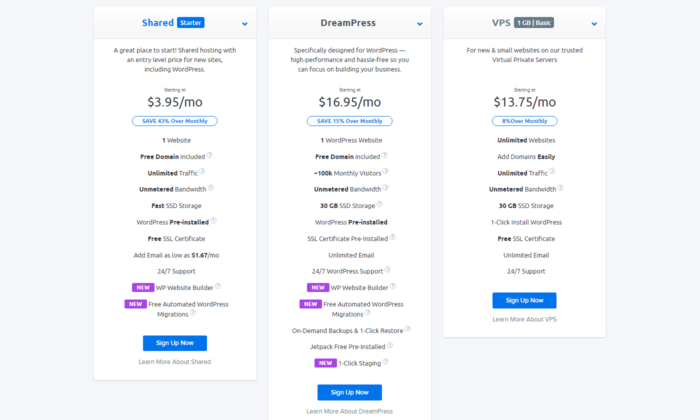
With incredibly adaptable services you can literally change your business in a matter of hours.
They know that things change as time passes.
Maybe you want to try out something new.
Maybe you’re certain that your current business model is outdated.
With their fascinating adaptable features, they will be your best friend when making major changes in your website.
#2 – Bluehost — Best for WordPress Hosting
If you’re looking to set up your website in less than a week, you’re probably considering WordPress.
After all, according to NetCraft, 35% of the Internet is powered by WordPress.
And it’s not a surprise. WordPress has been a leader in the industry for years now.
So if you’re looking for the best hosting option for your WordPress website, you can definitely trust Bluehost.
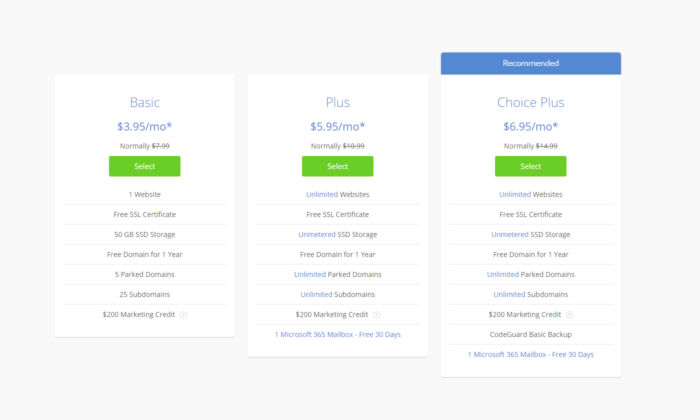
Their Pricing Options start from as low as $3.95/month and get up to $6.95/month.
Which is still not that expensive considering all the unlimited features they bring to the table.
Regarding website loading speed, as long as you don’t fill your WordPress site with plugins, you should be good.
And even if you make a crucial mistake or overload your website with different plugins, you’re in good hands.
Their Customer Support is extremely responsive. They have both an active telephone line and a live chat you can rely on at all times.
#3 – HostGator — The most affordable option for Startups
HostGator is one of the most preferred options when it comes to blogging.
They are perfect if you’re looking for the most affordable way to begin posting online.
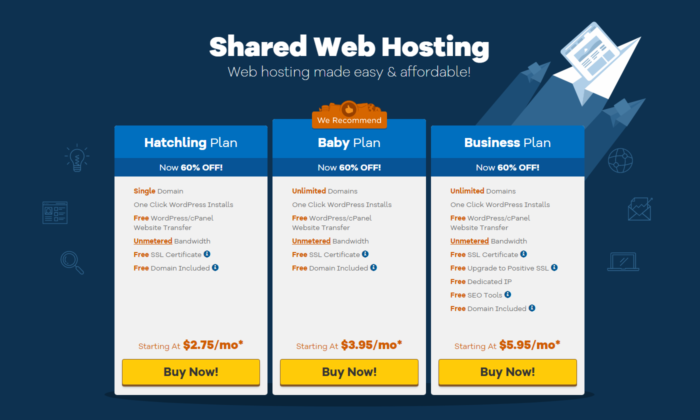
Pricing options start from the jaw-dropping $2.75/month.
Once again, you can’t expect the best features for such a low price.
But it’s a great alternative for startups that want to get their website up and running.
And just like Bluehost, they have a responsive telephone line with a live chat you can access at any moment.
You can also find a giant database with common questions beginners have, together with professional opinions and solutions to those problems.
Everything is explained and demonstrated step-by-step and if you’re still not sure that you can do it on your own.
Just shoot them a message and start chatting with their professional customer support.
#4 – WP Engine — Best option if you know your limits
We’re getting to the more advanced options now.
With WP Engine you can customize and get the exact features you need.
Of course, their services are not as cheap as some of the others on the list.
But if you’re certain what are the exact characteristics you need in a website, then WP Engine got your back.
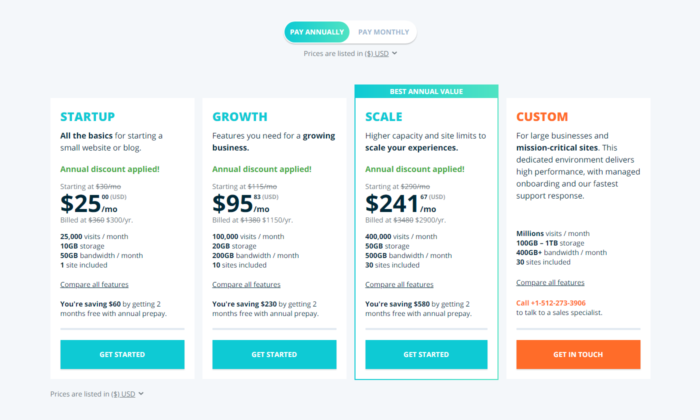
You just have to contact them and work out the best plan for your specific situation.
Of course, their experts are going to help you choose the correct option without pushing you to stuff you wouldn’t need.
It’s a great Hosting Service if you’re looking to scale big.
Don’t expect cheap services, but expect great quality and support on the way to your successful business.
#5 – Hostinger — Low-Cost Shared Hosting options for Startups
Hostinger is unique with it’s Shared Hosting Services.
Their prices literally start from $0.99/month. WOW.
Of course, you’ll be very limited with this option but it shows how much they are ready to do in order to satisfy their customers.
We personally recommend one of the higher tier options:
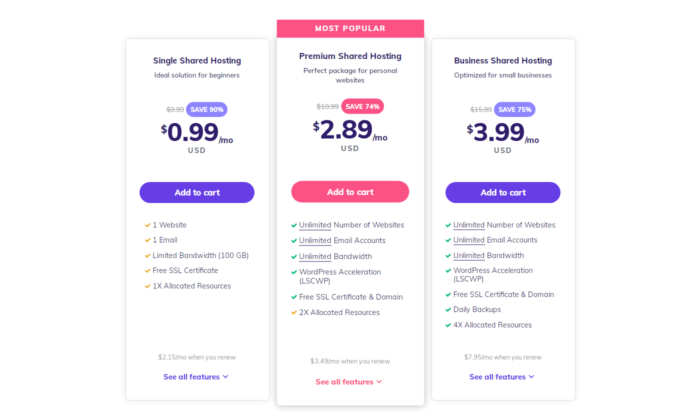
The good thing with Hostinger is that for as low as $3.99/month you can get unlimited access to everything.
With 24/7/365 support, you can expect professional assistance at any point.
For $3.99/month you get great loading speed and daily website backups.
That means even if you mess up badly, you always have access to previous versions of your website.
It is the best option if you’re searching specifically for a Shared Hosting Service that’s affordable and reliable.
#6 – InMotion — Best option for Scaling BIG
Are you positive that your website is going to dominate the online space?
If you’re 100% sure, then you should definitely take a closer look at InMotion.
Their VPS and Dedicated hosting services are far from cheap.
But with Premium prices come Premium services. We are talking fast loading speed and devoted customer support.
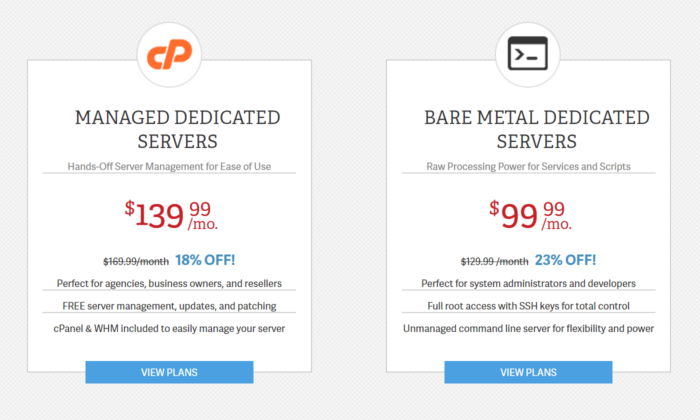
Obviously there’s also affordable WordPress Hosting and Shared Hosting options.
But if you’ve tried these before and now you’re looking for the next step.
InMotion is going to overdeliver on every promise.
Check out their plans and choose the one that fits your needs best.
#7 – Siteground — Best for WooCommerce Hosting
Do you want to sell your products online?
Then you’re probably in need of a good, reliable WooCommerce Hosting Service.
If that’s that case, then you should take a look at Siteground.
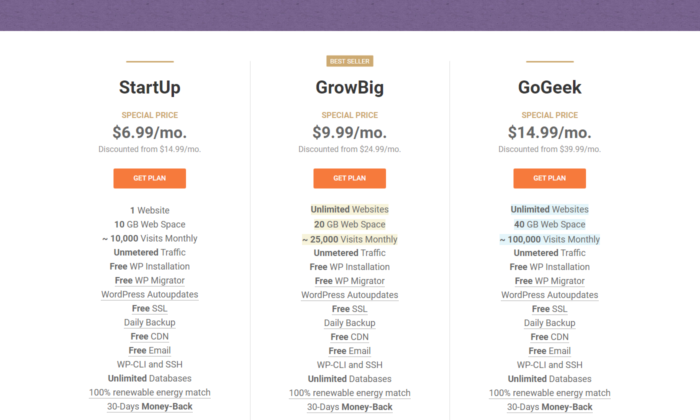
They have separated their pricing options depending on your scalability.
Most Hosting Services cut you here and there when it comes to cheaper options.
This is not the case here!
Siteground really wants to overdeliver, even if you choose their cheapest options.
Their Customer Service has a whopping 90% resolution at first contact.
That means that 90% of the time you’ll chat or speak with an expert in their team and resolve your issue in no time.
So if you’re looking for the best WooCommerce solution, Siteground is the hosting service for you.
#8 – Nexcess — Best E-Commerce Hosting
If you want a hands-off hosting solution for your online store, Nexcess is an incredibly smart choice.
They offer a wide range of hosting options with specialty solutions for Magento, WordPress, WooCommerce, BigCommerce, Drupal, and more.
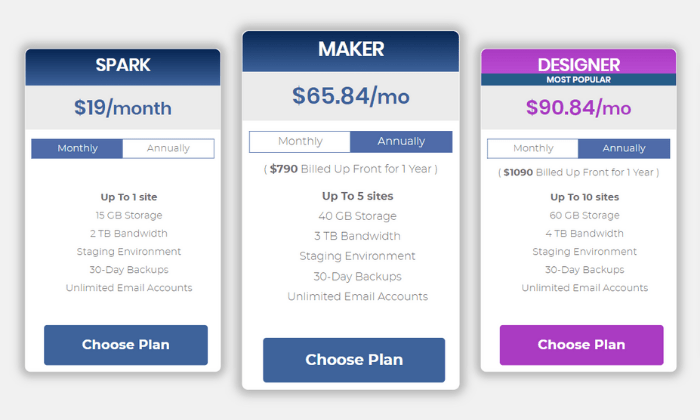
Plus, you get one-click auto-scaling to handle unexpected traffic spikes, 24/7 monitoring and customer support, and premium SSL certificates to keep your site and visitors safe.
So, you get everything you need to start, manage, and scale your online store.
On top of the amazing features, Nexcess has been around for 20 years with more than 500,000+ websites under their belt.
As such, they know a thing or two about how to help make your life easier.
With that said, it’s not the cheapest option on this list. But you do get more features, better support, and improved performance with the higher price tag.
So, if you need advanced security or expect to grow quickly, Nexcess is an excellent e-commerce hosting solution.
WordPress hosting plans start at $19 per month for one store, 15 GB of space, and two TB of bandwidth.
However, pricing varies based on the platform you choose.
Your Hosting Service Is Your Best Friend
Make sure you make a well-thought-out decision.
You’re most likely going to have a long-term relationship with the hosting service you choose.
So carefully look into every option that caught your eye today and choose the one that fits your needs best.
So, whether you choose one of my top recommendations or scout out your own, use the tips and best practices we talked about to make an educated decision… like the future of your business depends on it.
Because it does!
Have you worked with any website hosting companies in the past? How did it go and did you get the results you hoped for?
The post The Best Web Hosting Services (In-Depth Review) appeared first on Neil Patel.
source https://neilpatel.com/blog/best-web-hosting-services/
15 Powerful SEO Chrome Extensions

We’re expected to perform so many tasks daily, from organizing our content buckets to ensuring a website’s usability to link building to much, much more. It’s a lot — but there is good news. There are a variety of Google Chrome extensions that can make these tasks a lot easier.
Google Chrome has gobbled up a substantial market share. As per Stats Counter, Google Chrome has more than 66% of the total market share.
I assume many of you are also Google Chrome fans. But, have you explored the powerful extensions and Chrome shortcuts the browser has to offer?
At the click of a mouse button, you can install an SEO plugin and open doors to higher productivity levels. Some Chrome extensions are pure gold with value-adding functionality that can save you hours of tedious tasks every week. Ultimately, the goal is improving ranks, including Quantcast Rank, specializing in audience measurement.
In this post, I’ll share 15 Chrome extensions that are useful for marketers. I’ve organized the post into three sections – content organizing, on-page SEO metadata and usability analysis, and link building and outreach management.
Let’s dive into the first section and look at the first tool.
Content Organizing
Information overload can be really stressful. Wading through truckloads of web pages to find relevant and high-quality pieces is daunting.
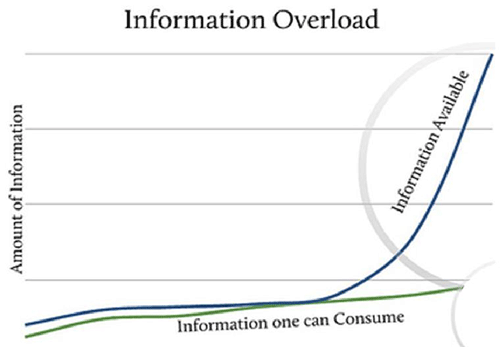
But it need not be that way. These two Chrome extensions will help you organize your content and save it for reading later.
1. Evernote Web Clipper
Evernote has powerful note-taking functionalities. Search Engine Land describes it as a “business-to-individual” media tool.
But if you are particularly interested in saving articles for reading later, the web clipper is a handy tool (located in the upper right side of Chrome).

While surfing the internet, you can take specific search results and use the clipper to save articles in three ways – entirely, in a simplified version, or even specific parts of an article.
This is great because a site’s Quantcast rank may change, making the content more difficult to find later.
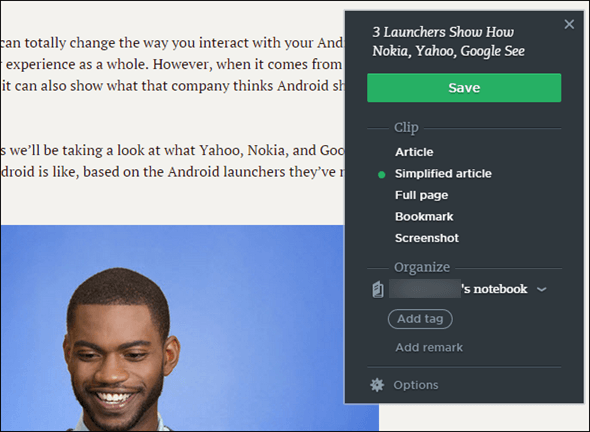
The webpages are added to your Evernote account, so you don’t have to go back to the search engine.
You can further organize them into notebooks and also assign tags (or remarks so that searching later will be easier). You can even highlight particular information if you want to. Evernote is a very popular browser extension.

You can also right-click on a page and use the clipper’s menu in the toolbar.

By using the options menu, you can also customize the keyboard shortcuts for its prominent functionalities.

The tool has a specialized saving feature for clipping from Gmail, LinkedIn, Amazon, and YouTube. You can selectively clip the portions you want.
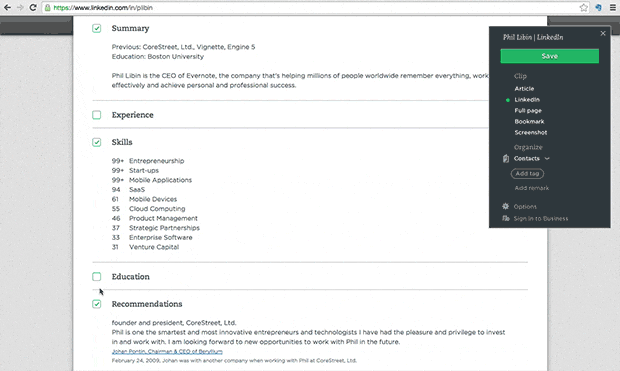
Here is a video walkthrough of saving Gmail messages using the web clipper. The tool even includes the attachments while clipping.
All of your saved articles will be synced across all your devices and can be accessed through your Evernote account.
The most useful feature I find in the clipper is its powerful image editing and annotating software Skitch.
It’s handy for creating images for your blog posts. You can use it to take screenshots, pixelate a certain area in them, and add custom text.

You can also mark up using different colors and visual callouts to draw attention to specific elements on a page.
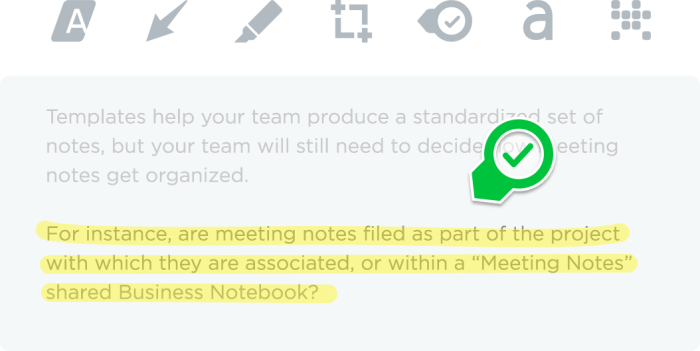
2. Pocket
This is another useful tool for saving articles and videos to read later.
Once installed, you’ll see the pocket icon in the Chrome toolbar located at top-right.

Like web clipper, Pocket also has the functionality to add tags to help easily explore and retrieve stories once pulled out of search engine land.
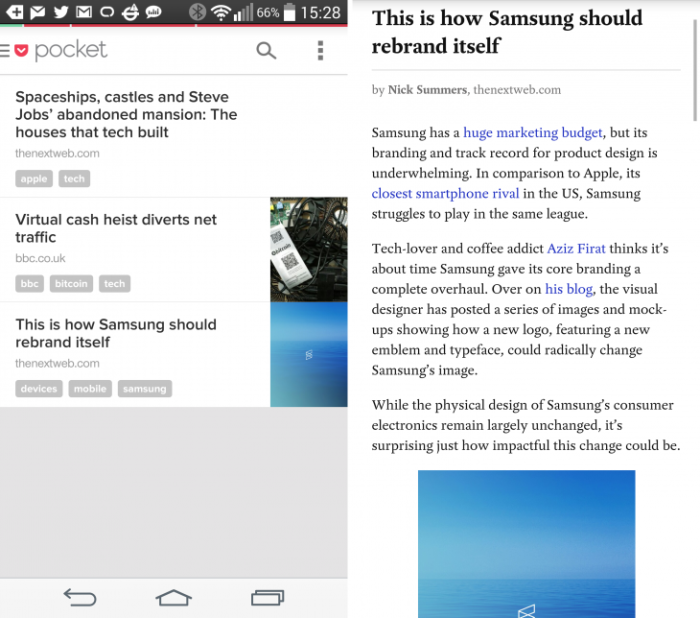
The best part is that your articles and videos will be available on all devices for reading later. So you can read articles in your leisure time, even on its mobile app.
When you open a story for reading, you’ll see a stripped-down basic version (distraction-free) of articles. This reformation makes the reading experience clutter-free and pleasant compared to the ad-bogged search engine view.
The service recently launched a recommended feature (refreshed throughout the day) that shows articles based on your saved article sources and reading habits.
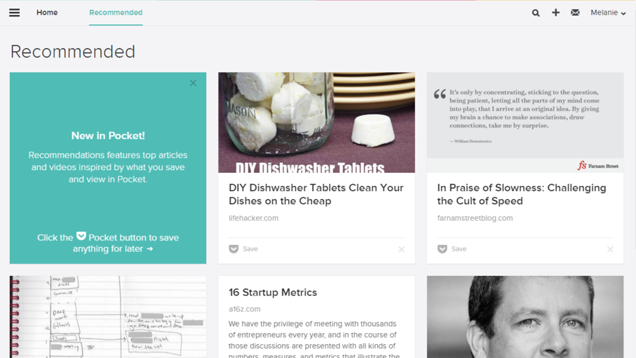
You can save the recommended articles you like to your reading list by clicking on the save button.

On Pocket’s iOS and Android mobile apps, you can even listen to your saved articles using Text-To-Speech (TTS).
You can start reading anywhere, skip paragraphs, and even change the reading speed.
You can also add stories from RSS feeds directly into your pocket account by integrating it with Feedhuddler.
And if you’re a fan of marketing automation, then you’ll also like Pocket’s integration with tools like IFTTT, Twitter, Feedly, and Buffer.
Your productivity levels will shoot through the roof. With just five minutes of casual browsing, you can use an IFTTT recipe to schedule articles on your social media accounts for a week.
Here is the IFTTT recipe for integrating Buffer with Pocket.
And if you’re the super-organized geek type, you may like combining pocket with Evernote to create an organized system.
You can save any interesting article you find around on the web (from feeds and social media) to pocket.
Once you scan these articles, only store the most valuable ones permanently in an Evernote. This way, your Evernote account will remain a long-term clutter-free place to hang out.

For sending articles from Pocket to Evernote, you can either use the “Send To” button or this IFTTT recipe.
On-page SEO and Usability Analysis
Sometimes you need to perform a quick analysis of your (or a competitor’s) website pages without logging into a tool’s website. This provides useful metrics in how you compare in search engine land.
A Chrome browser extension can help you achieve this goal without any hassles.
Let’s look at a few useful ones.
3. Google’s PageSpeed Insights Extension
A one-second delay in your website loading time decreases your conversions by 7%, page views by 16%, and customer satisfaction by 23%.
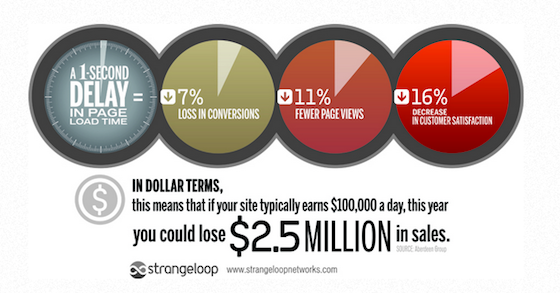
Google included site speed as one of the 200 signals in its search ranking algorithm back in 2010.
Monitoring your server’s response time is important for your business.
It’s even more critical if you get a major chunk of mobile traffic. Being a more distracted medium, 40% of mobile users will abandon a page that takes longer than three seconds to load.
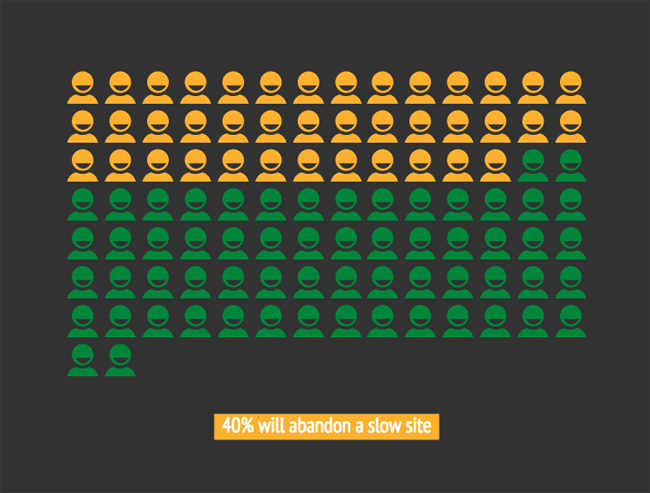
Google PageSpeed Insights is a great tool to explore your website’s usability. It identifies elements that are leading to slow loading time and a poor mobile user experience.
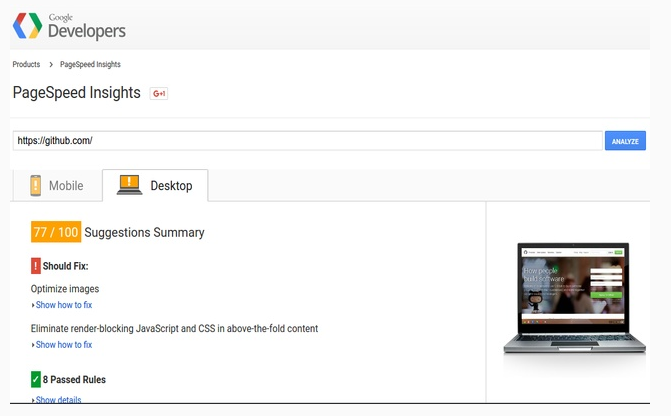
To get started, you need to install the plugin.
After your website’s analysis, you are presented with recommendations to fix issues and lower your website’s loading time on desktops and mobiles.
Brenda Barron, a WordPress enthusiast, rigorously tested her website with different WordPress plugins and manual optimizations to boost her PageSpeed Insights score. Her goal was to get a 100/100 score (or the highest possible) using Divi.
Look at her initial score on her new WordPress installation (Twenty Fifteen theme) on a shared server. It also shows recommendations to fix the slowing issues. The loading speed will also help redirect duplicate content to a canonical URL of preference.
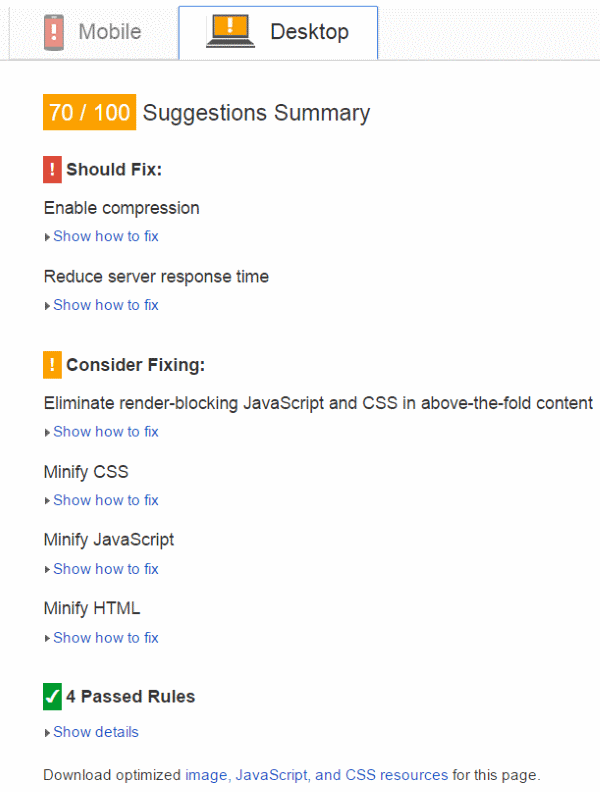
After numerous plugin changes, including installation of speed booster pack, WP Performance Score Booster, WP Super Minify, and others:
She managed to boost her score to 93.
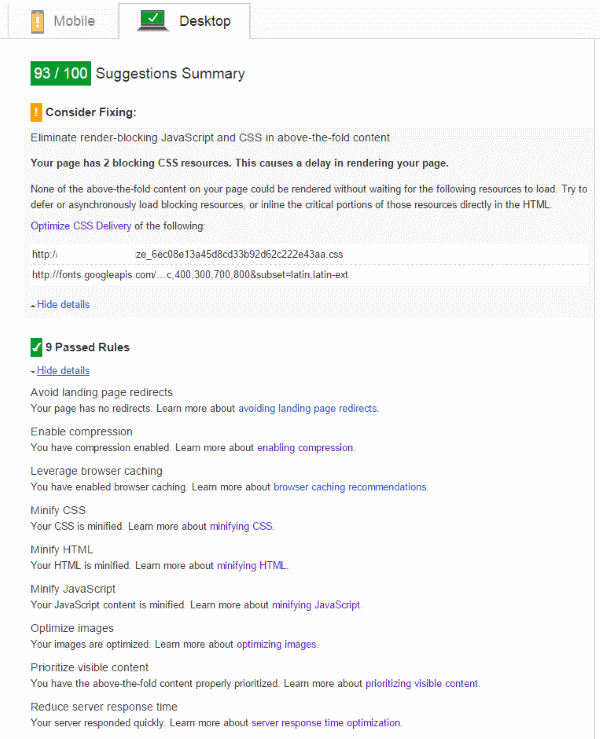
Here is the combination that worked for her.
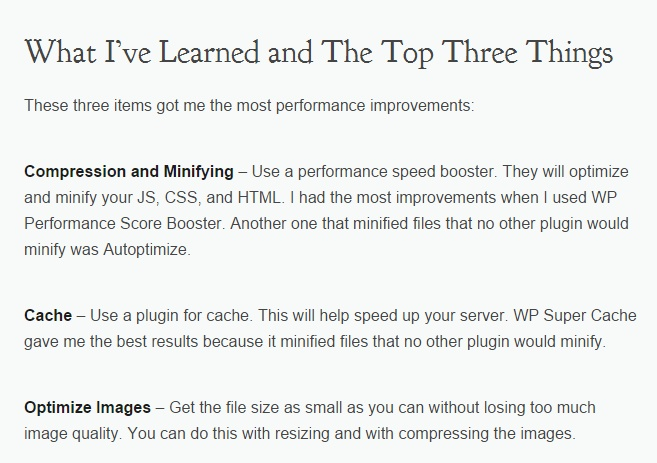
If you don’t want to go on a manual plugin installation and fixing issues spree, you can automatically use PageSpeed modules that automatically optimize your website.
Let me show you how with a live case study.
Matthew was initially using a non-responsive WordPress theme that led to poor mobile search results performance.
Google PageSpeed Insights showed a score of only 56, along with elements that needed fixing.
So he switched to the native twenty fourteen WordPress theme. It is responsive and performs well on most platforms.
Look at his score post-changes.

As you would expect, even Matthew’s pagespeed score was just 64.
![]()
But instead of fixing issues individually, he used the PageSpeed Module for nginx.
He shares the technical details of how he re-compiled nginx with the PageSpeed module in this article.
After this installation, he achieved a PageSpeed score of 100 (on both mobile and desktop).
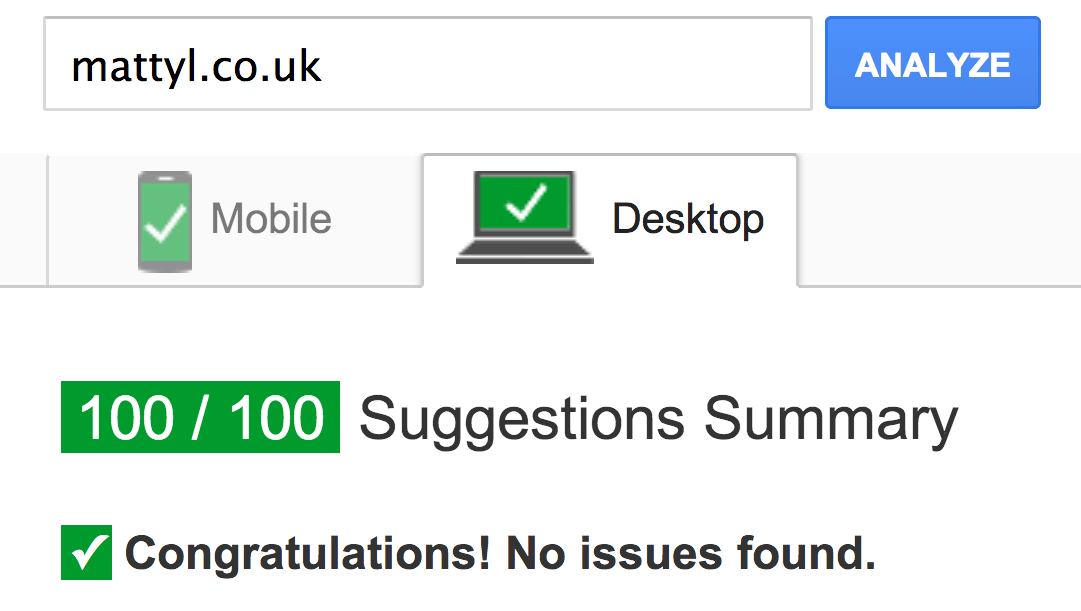
4. Redirect Path
I know that many of you might be afraid of technical terms.
But even if you’re not a coding geek, you need to understand the basics of website redirecting. It will help in the overall Quantcast rank of your web pages.
Redirecting is important because web pages keep moving to new locations and deleted during website migrations, redesigning, etc.
And a simple redirect determines if link juice is passed from a removed URL to a new page.
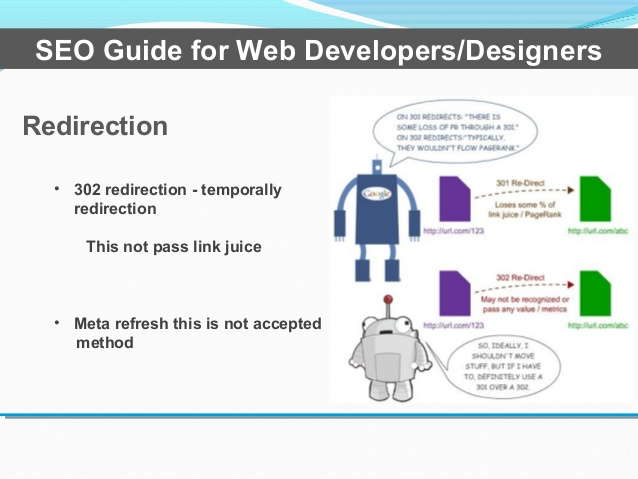
Redirect Path is a redirect checker that flags URLs with their HTTP status codes – 301, 302, 304, 404, and 500. You don’t need to check them manually.
The tool shows you all the redirects from the URL you entered to the final URL.
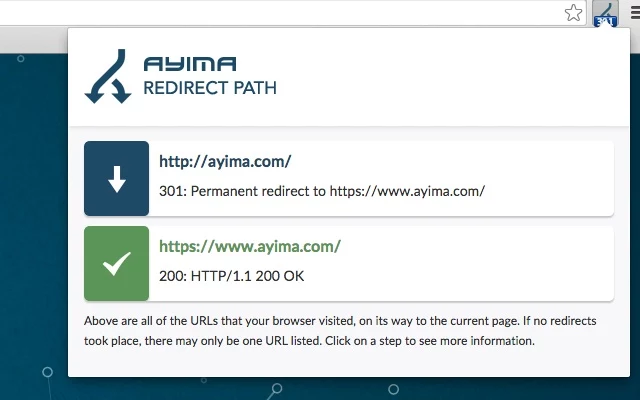
Once you install the extension from the Chrome store, it’ll start appearing next to the address bar at the top.
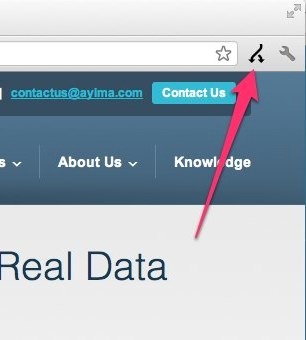
And if the extension finds any redirect errors, the icon will change (as visible below).

On clicking the icon, you can get full details about the redirect chain.
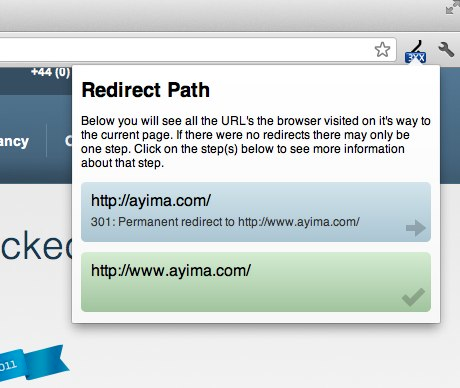
Want more details about a particular item in the path?
Then click on it to see additional HTTP headers sent (like server types, cookies, caching, etc.) and the server’s IP address.

A great way to discover backlink opportunities using the tool is to follow the redirect chain and find the backlinks to individual pages.
You can also use the tool for auditing your redirects after a site migration to review how you fare in search engine land.
5. Mozbar
It is one of the oldest and most popular marketing software programs on the internet.
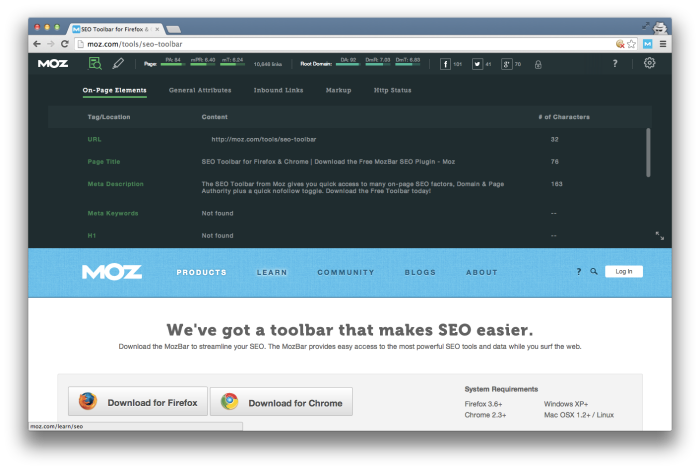
It instantly hit chords with marketers because it streamlines your SEO efforts while surfing web pages.
At the click of a button, you can access important metrics about a webpage like its Page Authority, Domain Authority, Link Profile, Keyword Highlights, etc.

The tool works in two environments – in SERP as an overlay and as a toolbar when visiting a website. There are different features in both modes. Let’s explore them both.
When you’re in a search mode and Google a keyword, the bar will give detailed statistics for all the SERP ranking websites.
Here are the results for the keyword “content marketing tips.”
Look at the metrics like domain authority and page authority (metrics below each result). They help you determine the difficulty in ranking for the particular keyword often used in SEO meta tags.
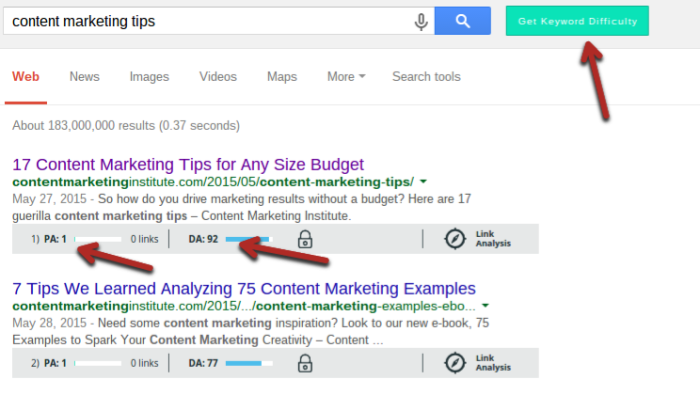
You can also export the SERP results in a CSV file.

If you visit a website, you can use Mozbar to do a deeper analysis of the webpage, including its pagespeed, alt text, SEO meta tags, headings, markup, etc.

If you buy a premium subscription, you’ll also be able to see a keyword difficulty score in SERP at the click of a button.

6. Page Analytics by Google
Would you care to understand the user behavior on your website?
Then page analytics is a great tool to delve into how your customers are interacting with your website.
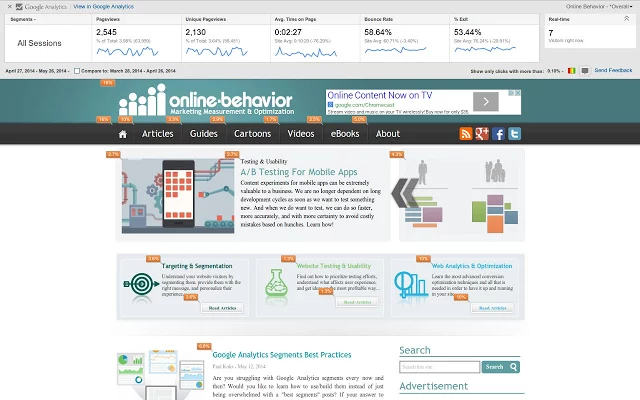
The tool gives you useful data like where your users click and the number of active visitors in real-time.

For the clickable areas on your page (like links and buttons), you can even see bubbles showing the percentage of visitors who clicked in that particular place.

The bubbles are of different colors (red, green, blue, or orange) based on their relative percentage of clicks.
And you can filter the page to show only bubbles above your set click threshold.
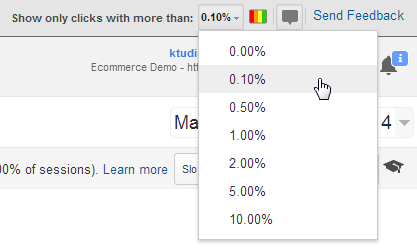
The tool also shows your usual Google Analytics metrics like Pageviews, Unique Pageviews, Average time on page, and Bounce Rate (you need to login to your analytics account before accessing information).
You can also analyze up to four segments with different scorecards for each and compare time ranges.
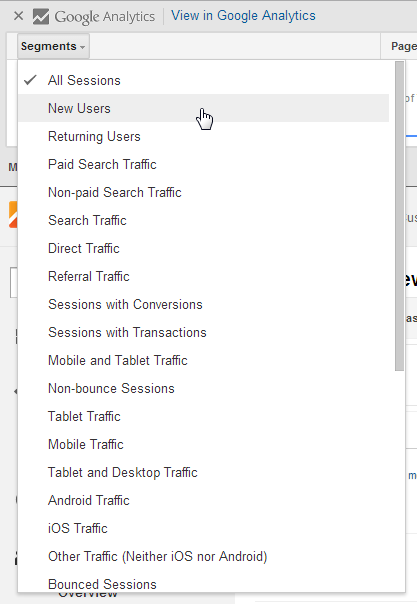
By analyzing the places where your users are clicking and engaging the most, you can optimize your design accordingly.
7. SEO Quake
Touted as a Mozbar competitor, this is another popular SEO browser extension tool that shows important metrics in SERPs.
Instead of launching and using its own metrics, the bar shows the standard Alexa Rank, Page Rank (PR), and some other important SEO parameters.

Here is a look at the SEO Quake bar in search mode.
The results show varied info about SERP pages, including info on backlinks, whois info, PR, traffic info, number of pages indexed, domain age, and Alexa rank.
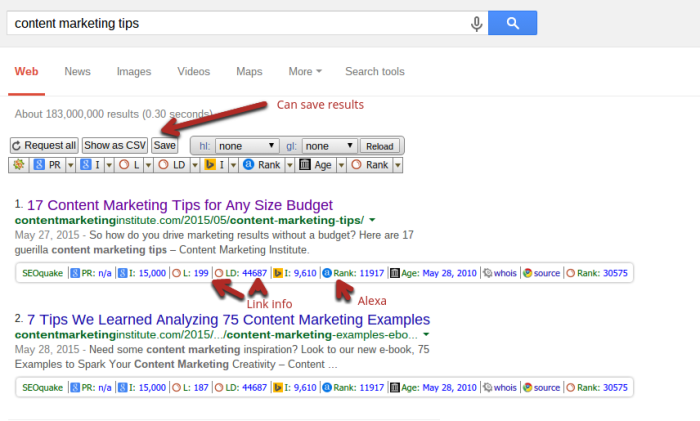
You can export the SERP data from SEO Quake in a CSV file too.
You can also use the extension to perform a deeper analysis of the webpage you visit. You’ll get information on the keyword density, links, social shares, and SEO meta info.
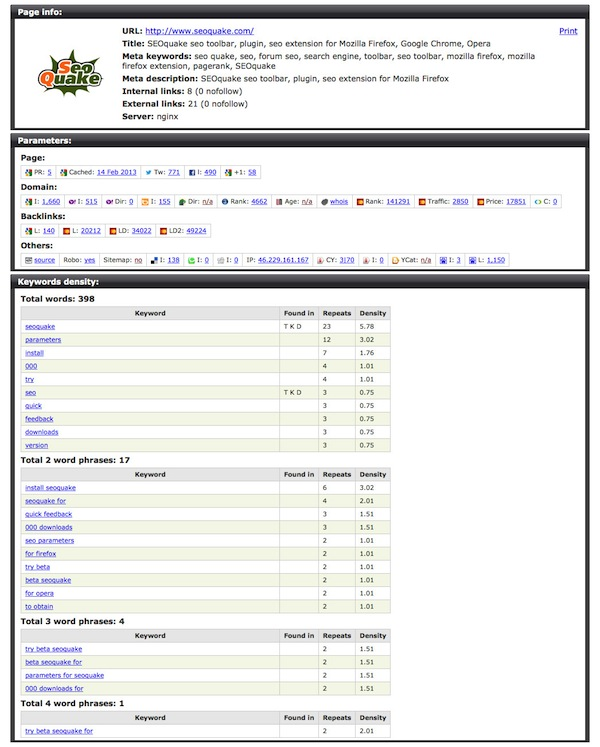
A word of warning:
Google hasn’t updated page Rank since December 2013, and as per John Mueller, Google probably won’t update Toolbar PageRank in the future.
Even the tool’s backlinks data is from publicly reported Google and Bing/Yahoo links (which aren’t updated frequently either).
So you shouldn’t rely exclusively on SEO Quake data for devising your SEO strategy.
8. SEOInfo
This is an all-inclusive SEO powerhouse with a wealth of data.
It’s invaluable to understand performance data, AMP status, errors for HTML pages, invalid canonical, hreflang, AMP version, and structured data.
After installing the extension, you’ll start seeing a camera icon like this:

If you want to perform a deeper analysis of a website, you need to click on this icon. You’ll see the main dashboard:
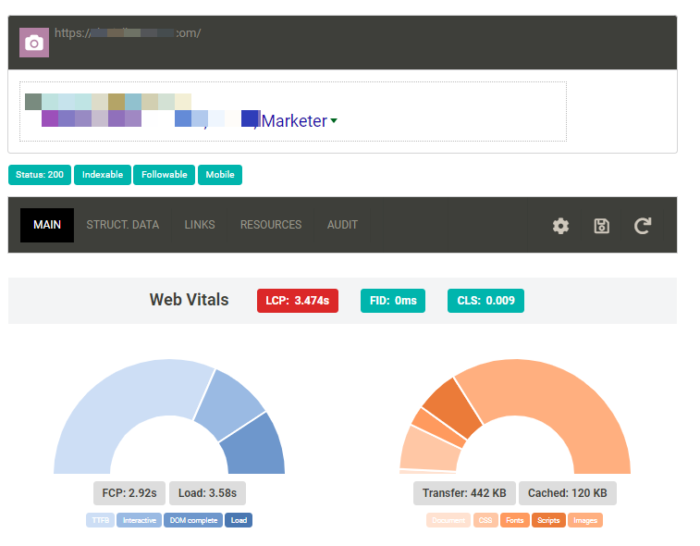
It will show you important website vitals, such as speed, whether your page is indexable, mobile compatibility, AMP status, language, and more.
Four other pages dig into structured data, links (internal and external), resources, and an overall audit.
This provides a wealth of information about the overall health of your website. You will need to connect to PageSpeed Insights to run the audit.
9. Majestic Backlink Analyzer
This is another popular and powerful link intelligence tool.
The tool creates a quick way to see important backlinks info about your webpage (or a competitor’s webpage).
It does not rely on third parties for data. It uses Majestic’s very own trust metrics: trust flow and citation flow.
Haven’t heard of Majestic’s trust metrics?
Here is an explanation of the trust ratio (= Trust Flow / Citation Flow) by Majestic.
The tool has three important metrics tabs – Summary, Backlinks, and Anchor text. But a free account will only allow you to use the summary tab.
The summary tab gives an overall strength picture of the webpage.
It shows the following metrics: citation flow, trust flow, external backlinks, referring domains, backlink history chart, referring domains chart, and link profile.
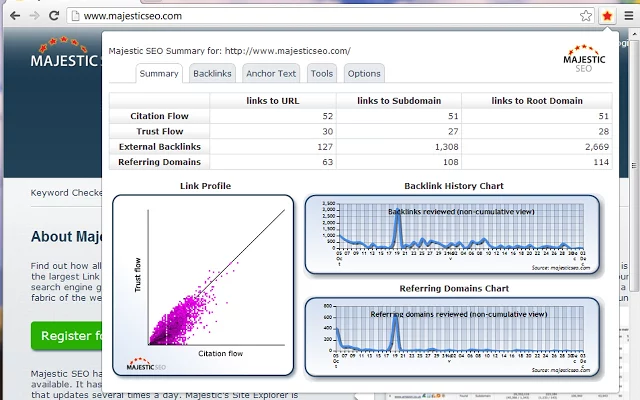
The backlinks tab shows citation flow, trust flow, anchor text, and source URL of the 10 strongest backlinks to the page.

And the anchor text tab shows detailed information on the number of referring domains and other parameters for the 10 strongest anchor texts.

The tools tab is for switching to other Majestic SEO tools like the site explorer, backlinks history, and more.
The last is the options tab. You can go there to connect your Majestic account to the browser extension.
You’ll also see a battery near the options tab. This shows the resources depleted from your main Majestic account.

10. Ubersuggest
Ubersuggest is our keyword research tool that provides a wealth of information about keywords, including new keyword ideas, content suggestions, and other insights to help you gain a competitive edge.
And, now there’s a Chrome extension that makes this tool even easier to use.
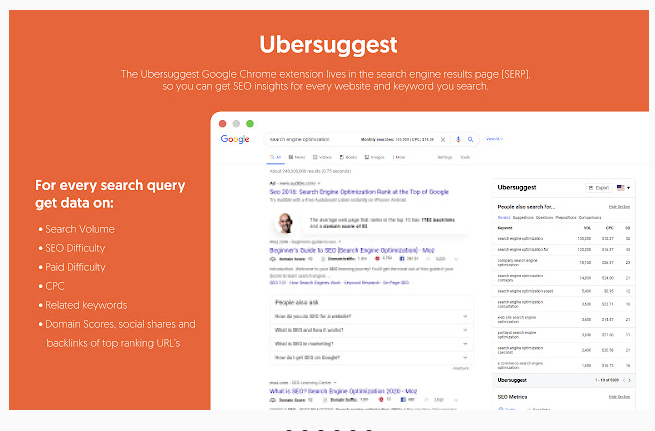
Simple download the extensions, and you’ll see an orange “U” in your Chrome bar. Perform a search in Google, and Ubersuggest will provide a ton of information, including organic monthly traffic, backlinks, related questions, and more.
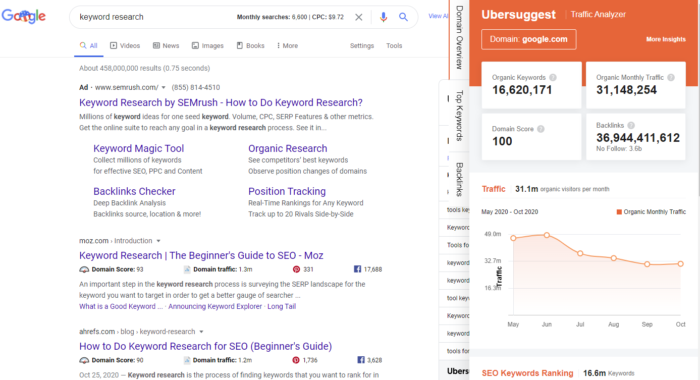
It also provides the average CPC and total monthly searches for that key term. This information can generate content ideas, plan PPC campaigns, and guide your SEO strategy.
If the sidebar doesn’t provide enough info, click “Get more insights” to be taken to the main tool website.
You can also use the plugin to check on your competition. Go to your competitor’s website, then click on the Chrome shortcut for information about that site’s traffic, top keywords, backlinks, and SEO ranking.
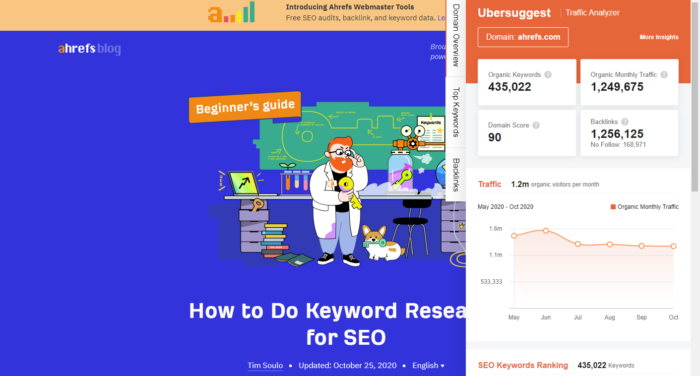
Link Building and Outreach Management
One essential, non-scalable, and probably the most value-adding task of a professional SEO is performing outreach and building relationships.
And it’s a vital part of building editorial backlinks that matter in today’s SEO landscape.
But sending 100 emails does not sound fun. So outreach is generally viewed in a tedious, boring, and uncreative light.
Here are five Chrome extensions to streamline your outreach, save you time, and make your outreach more convenient.
11. Ninja Outreach Lite
Ninja Outreach is in itself a powerful prospecting and outreach CRM with a database of over 4 million influencers.
The extension is like a freemium version of the tool to mine tremendous data. Once you install the extension, you can use the ninja icon Chrome shortcut to start finding influencers.
![]()
The information available through the tool includes full name, location, social media follower counts, email address, Alexa rank, backlinks, page authority, domain authority, and more.
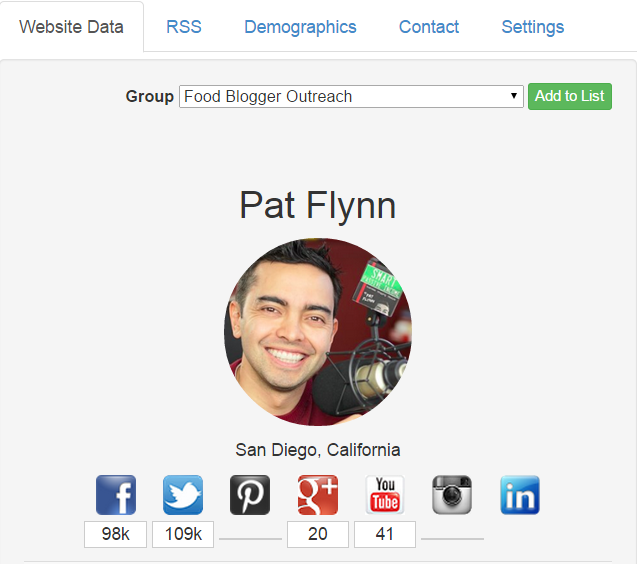
It even includes links to key pages – contact, about, resources, guest post pages. As well as the monetization method of websites.
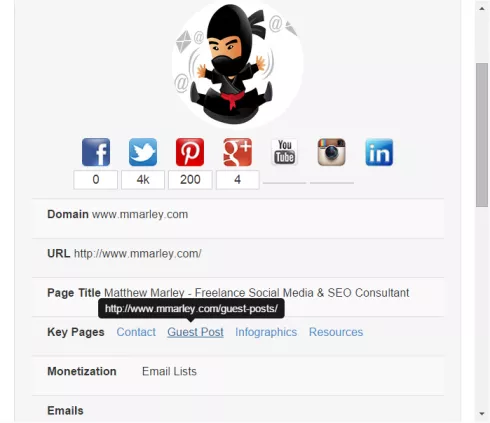
The RSS Feed tab shows the latest posts from the blog’s feed with the author’s name, date of publishing, and the number of comments on the post.
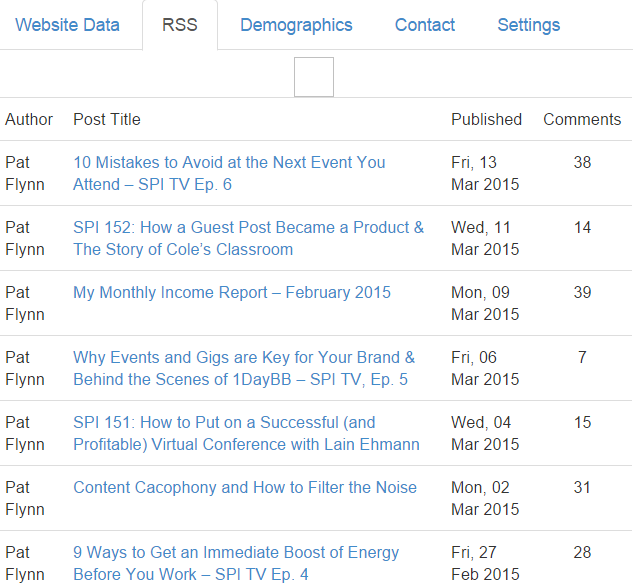
The demographic tab will show you key information on website visitors, like their locations, daily pageviews per visitor, bounce rate, and much more.
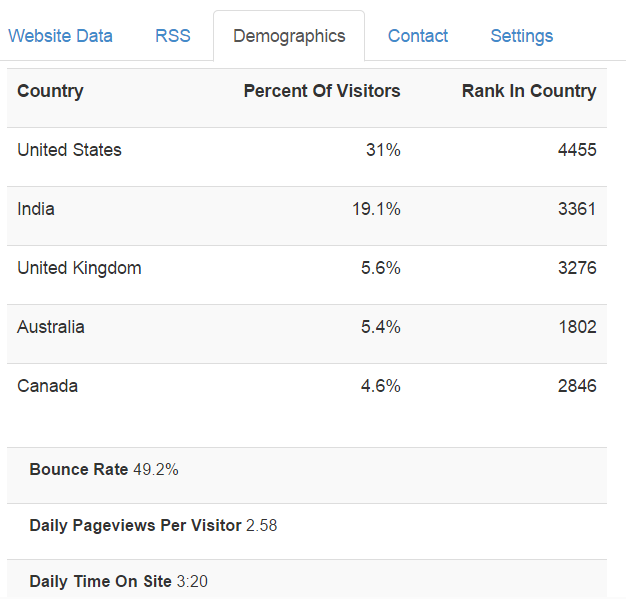
The tool’s pro version also allows you to autofill contact forms and leave notes for each website (that will be cached later).
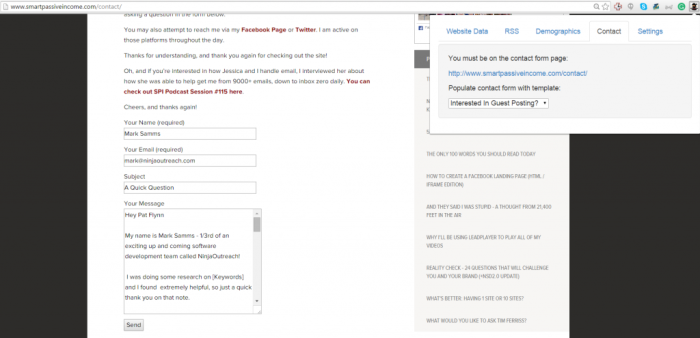
If you’re planning to launch a guest blogging campaign or build relationships with influencers soon, then the extension can be convenient.
12. Scraper
This is an effective data mining tool that can streamline your online research efforts. It copies links or similarly structured content from a webpage that you can later export to a Google document.
Here are the three steps to scrape data using the tool.
Step 1. Select some content from the table/chart you want to scrape.
Step 2. Right-click your selection and choose “scrape similar” from the drop-down menu.
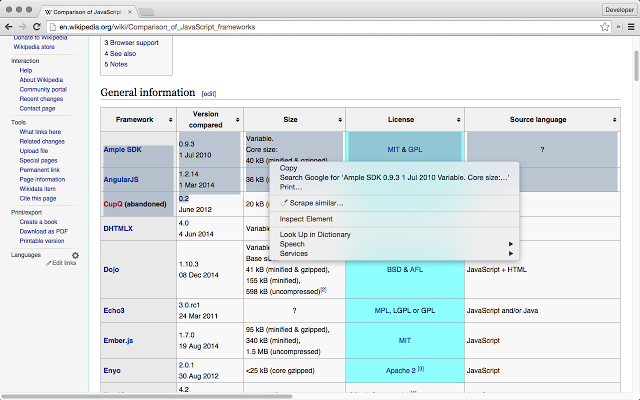
Step 3. You’ll get a list of similarly structured data in a new window (the scraper console). From the window, you can either copy the content to your clipboard, or you can export the data to a Google document.

You can use the tool to quicken your link prospecting efforts. Let me show you how.
Suppose you want to get a list of potential link opportunities in your niche. So you curate blogs from Alltop.com. Or, you perform a Google search “list of [your niche keyword] blog” (set Google search to return 100 results).
You can copy right-click on just one URL and scrape the whole list. Then you can export them to Google docs and remove duplicates. Remember that duplicate content can be used but should be redirected to a canonical URL to not anger the spiders.
Here is a breakdown of the technique by Matt Gratt.
13. Link Miner
No SEO should doubt that Broken Link Building (BLB) is an extremely effective technique to up your website’s authority.
But it’s a lot of hard work. You first need to find broken web links on a website in your niche and then send 100s of emails to website owners.
Link miner is a simple yet handy tool to conduct page analysis while executing BLB.
At the click of a button, it’ll crawl a webpage and find (mark) broken links on it.

It also pulls additional statistics about the broken link. You get details like the number of referring domains, total links, social media shares, and even the top five links.
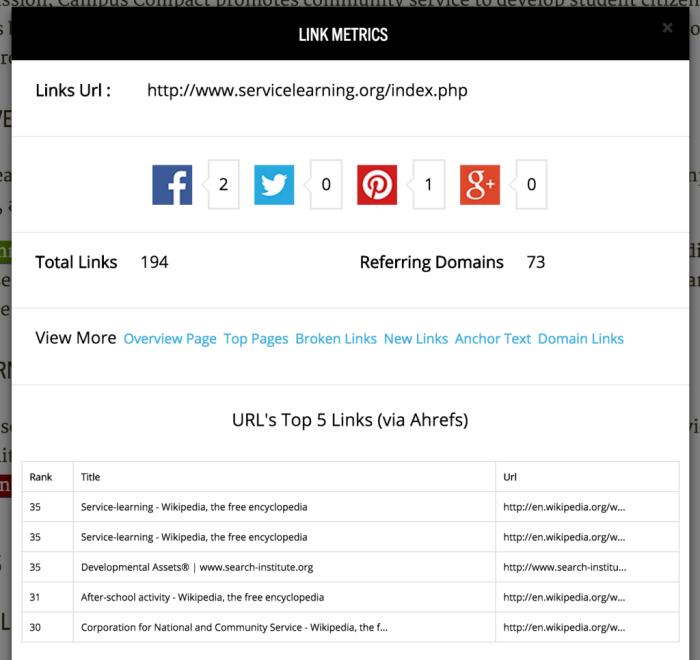
You can also get the link data right next to the status code of the link.

Want to record this data?
Then the tool can also export the information about the links in a CSV file.

While doing a Google search, the tool can also determine the number of inbound and outbound links for each result.
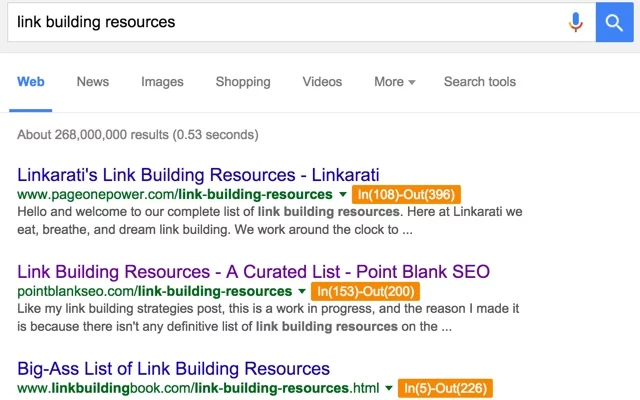
You can customize the way you want it to work under settings by clicking on the gear icon.
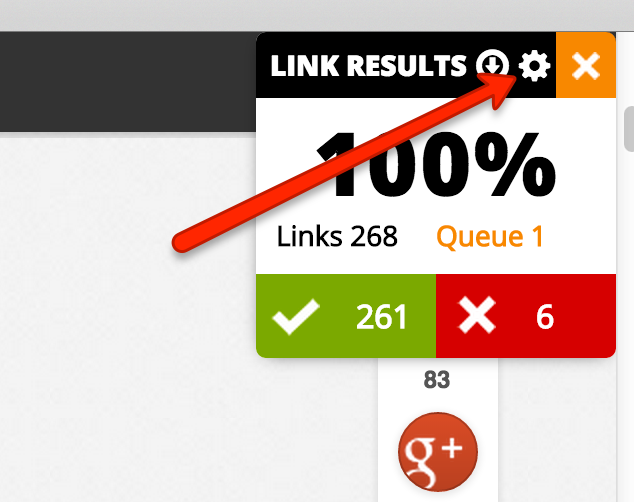
You can choose the metrics you want the tool to show: status code of working links, Ahrefs metrics like backlinks and referring domains, and more.
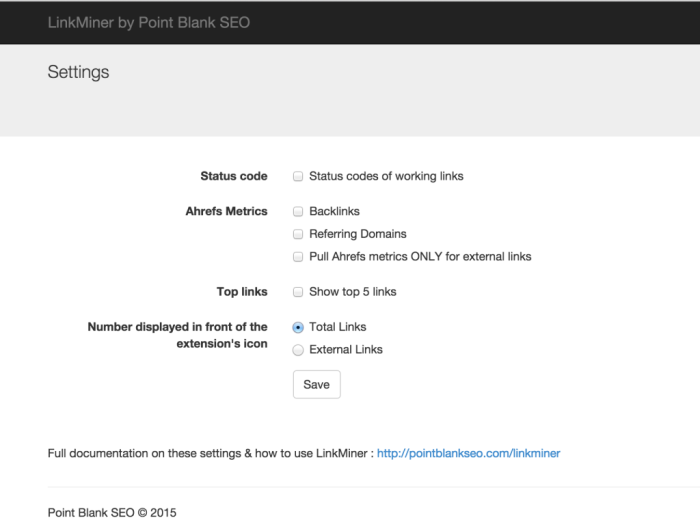
The link data in the tool is pulled from Ahrefs. So you’ll need to authenticate the extension to access Ahrefs API data.
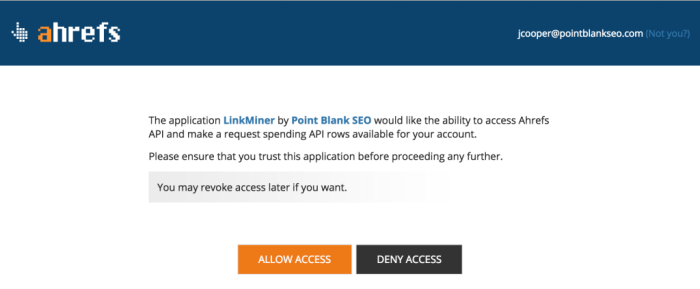
This SEO plugin is useful not just for discovering link building opportunities. It’s also useful to check broken links on your website so that you don’t hurt your website visitors’ user experience.
14. LinkClump
This is another useful tool to play with links.
You can use it to open multiple links in new tabs (or a new window), copy them to your clipboard or bookmark them.
So how do you get started?
Just by choosing a particular portion of the screen.
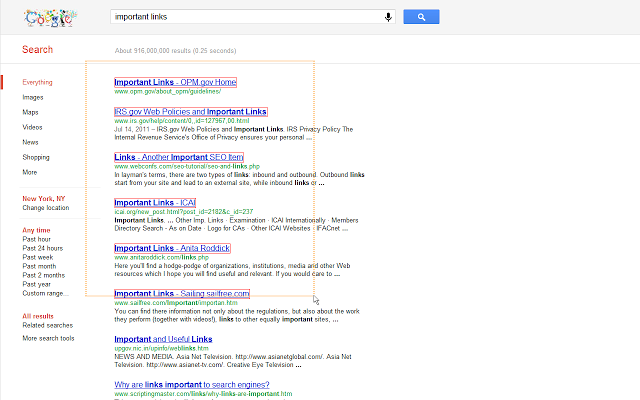
You can even customize how you want to activate the tool.
There are various possible mouse (right-click and left-click) and key combinations (alt/ctrl/shift). If you like, you can even change the selection box color.
You’ll need to head over to Chrome’s extension page at chrome://extensions. And choose “options” below linkclump to find these customization options.

You can also filter the links that contain certain keywords, block repeated links in your selection, and open links in reverse order. There is also a smart select option to open only those links from a page that the tool deems as important.
Overall the tool is glitch-free and can save you a lot time while performing link-related tasks.
15. Google Analytics URL Builder
Google Analytics (GA) is an extremely powerful tool to track your website traffic.
The URL Builder extension is a useful add-on to quickly tag the URLs you want to track in your GA campaigns.
Let me show you how to use the tool.
Once you’re on a page, click on the shopping cart icon.
The tool will automatically capture the current URL of the page. You will then need to complete a form, including fields like the source, medium, campaign, etc.
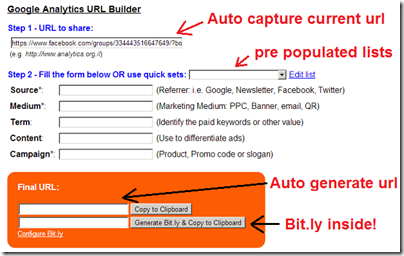
Once you’ve filled the form, it’ll auto-generate the final URL and offer an option to generate the shortened bit.ly link.
You can then share this new tagged link through your social media accounts and track them independently using GA.
The extension also allows you to add custom form fields (quick sets) by clicking on the “edit list” link.
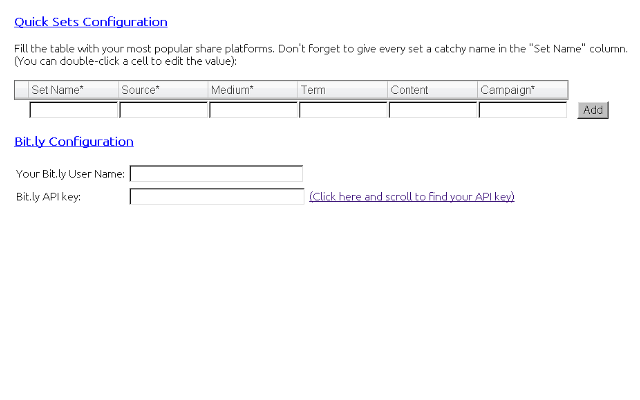
Here is a step-by-step video tutorial of the URL builder to walk you through the process of tagging your links.
Conclusion
Google Chrome remains a popular browser for web users. The reason is that it’s lightweight and has tons of value-adding extensions to enhance your browsing experience.
If you aren’t extracting the powerful functionalities of Chrome shortcuts, then you’re probably losing your time performing tedious tasks.
Start with installing a couple of Chrome extensions today. It only requires a single “Add to Chrome” click.
If you’re already using Chrome extensions, then I would love to hear from you. Have you used any of the above 15 extensions to streamline your workflow? Did I miss your favorite Chrome extension that has helped you in SEO?
The post 15 Powerful SEO Chrome Extensions appeared first on Neil Patel.
source https://neilpatel.com/blog/15-powerful-chrome-extensions-thatll-help-your-seo-efforts/
The 10 Best Apple Watch Apps for Business
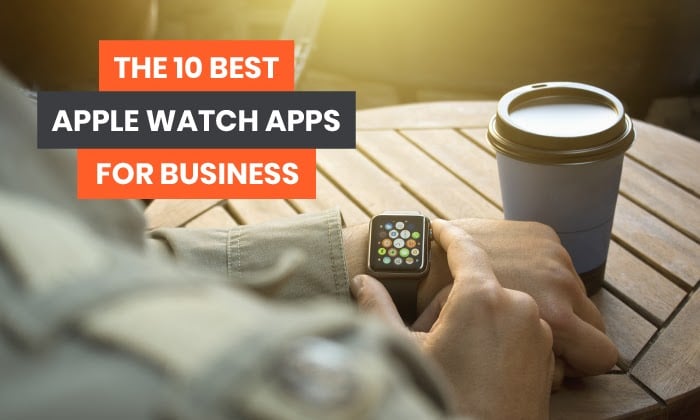
When the Apple Watch first came out in 2015, there were 3,000 apps available for download. Fast forward five years, and now there are over 20,000 apps—21 of which are built-in.
As an entrepreneur, Apple Watches can be an excellent investment, as there is a wide variety of Apple Watch apps designed with business in mind.
We’ve researched the top ten Apple Watch apps that may make it easier for you to run a company or excel at your job.
Apple Watches: The Basics
Before exploring the top ten Apple Watch apps for marketers and business, let’s go over what Apple Watches are and what they do.
The Apple Watch is a smartwatch produced by Apple. In essence, it’s a wearable, touchscreen computer you wear on your wrist.
What can you do with an Apple Watch?
- Answer calls
- Record voice memos
- Listen to podcasts
- Receive iPhone notifications
- Pay with Apple Pay
- Ask Siri questions
- Send texts
Why Should Marketers Care about Apple Watch Apps?
As a marketer, Apple Watch Apps are quite useful, and you can utilize them in a variety of ways to make your campaigns more effective. These are the three features we’ve found most helpful:
- Increased social media responsiveness
- Location-based alerts
- Email alerts
Increased Social Media Responsiveness
Apple Watch apps enable business owners to better monitor social media engagement. Social media has empowered customers to share how they feel about businesses more than ever before. However, businesses have to be listening.
The Apple Watch apps send push notifications to users when someone responds to a post or if someone sends them a direct message. Let’s say someone uses your product or service, and the customer had a great user experience. You’d want to respond quickly to that person, so the customer feels as though you care, and she didn’t waste her time sharing her thoughts.
Conversely, if a customer has a negative experience, you want to solve the problem as quickly as possible. Because your Apple Watch apps notify you immediately when someone interacts with your brand on social media, you can fix issues faster (rather than waiting until you next check your phone or computer).
Location-Based Alerts
Another benefit of Apple Watch apps is location-based alerts. Businesses, especially small ones, may be able to leverage this feature to drive more people to their brick-and-mortar locations.
Location-based alerts are the result of technology called geo-fencing. This serves up ads to mobile device users, including Apple Watch owners, based on where they are.
Geo-fencing works by setting up a virtual “fence” around a business. When someone enters the perimeter, the individual may see an ad for your company. Those ads may result in more foot traffic.
Let’s say a coffee shop has an app, and an Apple Watch user downloads it and opts in for notifications. The coffee shop uses geo-fencing. When the Apple Watch user is near the shop, they receive a notification on their wrist, offering them a discount if they come by right now.
They wouldn’t get this deal via email or anywhere else—why not pop by if they have a few minutes?
Email Alerts
This benefit has less to do with marketing to customers and more to do with staying connected to your business. With Apple Watch Apps, you can check your email wherever you are. You don’t even need to pull your phone out of your pocket to do so.
When a message comes in, raise the arm donning your Apple Watch. This gesture lets you read the full message. When you’re done reading, you can lower your arm, and the watch dismisses the notification.
You can also send emails from your Apple Watch, either by typing or by dictating a message to Siri.
Being able to use email anywhere, without having to dig out your phone and open your email app, may help you deal with pressing business issues faster.
Think Outside the Box
The three Apple Watch app capabilities we’ve mentioned are the tip of the iceberg for businesses. To maximize the value of Apple Watch apps, think outside the box.
There are so many Apple Watch apps that can be used to promote products and services. By thinking outside of the box, marketers may find creative ways to leverage Apple Watch apps to attract, engage, and retain customers. We’ll talk about some of our favorites below.
Apple Watch Apps For Other Business Areas
In addition to their benefits for marketers, Apple Watch apps may help make other areas of your business more effective. Coming up, we’ll discuss six types of Apple Watch apps that may enable you to run your company better:
- Customer relations management apps
- Organization apps
- Presentation tool apps
- Apps for sending and receiving payments
- Goal tracking apps
Customer Relations Management Apple Watch Apps
Customer Relations Management (CRM) apps gather information about interactions with customers and centralize that data.
For example, if a customer purchases from you, there’s a record of the whole process. You can see what the person bought, when they bought it, and how much the product or service cost. Did the customer have to bring in the product for repairs? There will be information about the incident in the CRM, too.
Three CRM Apple Watch apps we’ve found helpful are:
- Salesforce
- Bottomline
- Gro
Salesforce
Salesforce has over 30% of the market share in the CRM space. It was also one of the first enterprise firms to launch its Apple Watch app.
The Salesforce Apple Watch app gives users quick access to the charts and raw data they need so salespeople can close a deal and marketers can make data-driven decisions. With this app, employees can record customer interactions and use that information wherever they are, even if they’re not in the office.
Bottomline
While Salesforce works for companies of all sizes, smaller businesses might find it doesn’t quite meet their needs because it has more features than they require. Bottomline is a CRM Apple Watch app meant for smaller companies.
With Bottomline, you can track all of your sales, customers, and products in one place. There’s also a built-in expense tracker function. Bottomline creates reports intended to help answer questions like:
- Who are my top customers?
- Who are my best leads?
- Which customer personas are most valuable to my business?
Gro
Gro is another CRM app that may work well for your small business. While Bottomline has CRM functionality, Gro is a full-featured CRM. This Apple Watch app offers:
- A CRM dashboard
- Lead and contact management
- Opportunity management
- Appointment scheduling
These components may help you manage your contacts, effectively nurture leads, and cultivate new opportunities. The built-in appointment scheduling feature could also save you time and effort, as you don’t have to navigate to another app to enter a meeting into your calendar.

A screenshot of Gro CRM for the Apple Watch.
Organization Apple Watch Apps
Organization apps optimize your productivity. Apps can make tasks more efficient, such as note-taking, project management, and scheduling.
Our research determined the best Apple Watch apps to help with organizational skills are:
- Evernote
- Noted
- Cisco Webex
Evernote
Evernote has become one of the top note-taking apps for a good reason. It allows you to:
- Sync notes to all devices
- Add text, PDFs, scans, audio, and documents to your notes
- Format your notes
- Search for individual notes
Noted
Noted integrates audio recording with note-taking. What differentiates Noted from other note-taking apps is it adds a timestamp to your audio recording. You can tag specific moments from lectures and seminars to return to them quickly and easily.

A screenshot of the Noted app for the Apple Watch.
Cisco Webex
You may hold a meeting anytime, anywhere, by using the Cisco Webex app for Apple Watch.
The Webex Apple Watch app lets you:
- Join meetings
- Present to others
- Schedule meetings
- Share content or your screen
Presentation Tool Apple Watch Apps
Your Apple Watch may even help you deliver killer presentations. Here are two Apple Watch apps for presentations:
Keynote
Keynote allows you to create audiovisual presentations on another Apple device, then use your Apple Watch to control the presentations—keeping your hands free while you speak.
PowerPoint
If you’re a PowerPoint fan, you can use the popular presentation software on your Apple Watch. As with Keynote, you can control the presentation from your watch.
Apple Watch Apps for Sending and Receiving Payments
When the Apple Watch first came out, there was an app enabling users to receive and send money. That app is no longer available for the Apple Watch—but you aren’t left out in the cold, thanks to Invoice & Time Tracking from Zoho.
With Invoice & Time Tracking, you can invoice customers and accept payments on the go. However, there’s no function to pay invoices with the app, so be sure to build that into your schedule.

A screenshot of the Invoice & Tracking app for the Apple Watch.
Goal Tracking Apple Watch Apps
There are several goal tracking apps for individuals which may help you keep tabs on your business benchmarks, including:
- Forest
- Strides
- Productive
- Tally
- Streaks
Forest
Want to avoid distractions while you work? Forest keeps you focused by rewarding you with an increasingly lush backdrop of plants when you ignore your devices to get stuff done. Making things even better, the app developers plant real trees to reward users and help the planet.

A screenshot from the Forest App for the Apple Watch.
Strides
The best goals are often SMART: specific, measurable, achievable, relevant, and time-based. Strides may assist you in reaching your goals by:
- Tracking good and bad habits
- Setting dates by which to reach targets
- Providing daily, weekly, monthly, yearly, or rolling averages of goals met
- Creating milestones to benchmark progress
Productive
Part of being successful is having good habits. The Apple Watch app Productive is here to help you try to get into a better groove.
The app sets reminders throughout the day and tracks the progress you’ve made toward your goals. When you complete tasks that may lead to the creation of good habits, the app shows you the chain of positive actions that may keep you motivated. There’s even a Siri shortcut, making it easy to access Productive with just your voice.
Tally
Like Strides and Productive, Tally tracks habits. However, Tally may give you insight into patterns you didn’t realize existed.
Let’s say you’re not meeting your goal of writing a weekly blog post. Tally’s tracker shows you this goal has been set for Wednesdays—the same day as your exhausting weekly staff meeting. By moving your blog writing day to Thursday, may be better able to meet your goals.
Another benefit of using Tally is being able to export your data as a CSV file, making it easier to save or share what you’re doing.
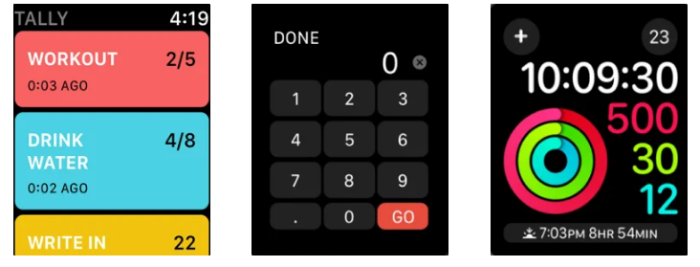
A screenshot from the Tally app for the Apple Watch.
Streaks
Want to form good habits? Streaks may help you do that by:
- Tracking up to 12 daily tasks
- Syncing across all devices
- Automatically completing tasks you’ve linked to the Health app
- Reminding you to complete a task
- Allowing you to create “negative” tasks so you can try to break bad habits
- Adding timed tasks
A screenshot of the Streaks app for the Apple Watch.
Conclusion
Apple Watch apps aren’t just for your personal life—there are plenty of apps you may want to use at work as well. You might find these apps help you reach your customers better, keep yourself organized and accountable, and take care of everyday and big picture tasks more smoothly.
Which Apple Watch apps will you use for your business?
The post The 10 Best Apple Watch Apps for Business appeared first on Neil Patel.
How Core Web Vitals Affect Google’s Algorithms
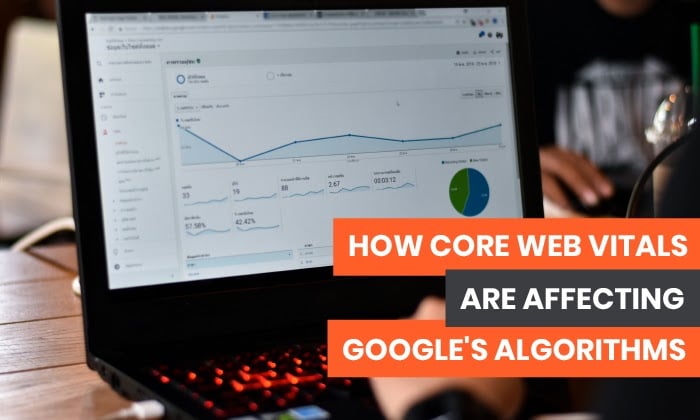
While we spend a lot of time focusing on keyword optimization, mobile-experience, and backlinks, Google pays a lot of attention to the on-page experience. That’s why they’ve rolled out a new set of signals called Core Web Vitals.
These signals will take into account a website’s page loading speed, responsiveness, and visual stability.
In this guide, I’ll explain what Core Web Vitals are and help you figure out how it could impact your rankings.
Core Web Vitals: What Are They and Why Should You Care?
Is this simply another scare tactic by Google to make us revamp everything and get all nervous for a few months?
I don’t think it is; I think this will become a serious ranking factor in the coming years — and for a good reason.
The good news is you may not even have to do anything differently because you’re already providing a high-quality on-page experience for your visitors.
This is essentially what Core Web Vitals are. It’s a page experience metric from Google to determine what type of experience visitors get when they land on your page.
For example, Google will determine if your page is loading fast enough to prevent people from bouncing. If it’s not, you could face a penalty in ranking and be replaced by a website that’s loading correctly.
So, now we have the following factors determining the quality of a “page experience” on Google:
- Mobile-friendly: The page is optimized for mobile browsing.
- Safe-browsing: The page doesn’t contain any misleading content or malicious software.
- HTTPS: You’re serving the page in HTTPS.
- No intrusives: The page doesn’t contain any issues that cover the primary content.
- Core Web Vitals: The page loads quickly and focuses on elements of interactivity and visual stability.
Many websites are providing these factors already, and if you’re one of them, you have nothing to worry about.
Google’s Announcement about Core Web Vitals becoming a Ranking Factor
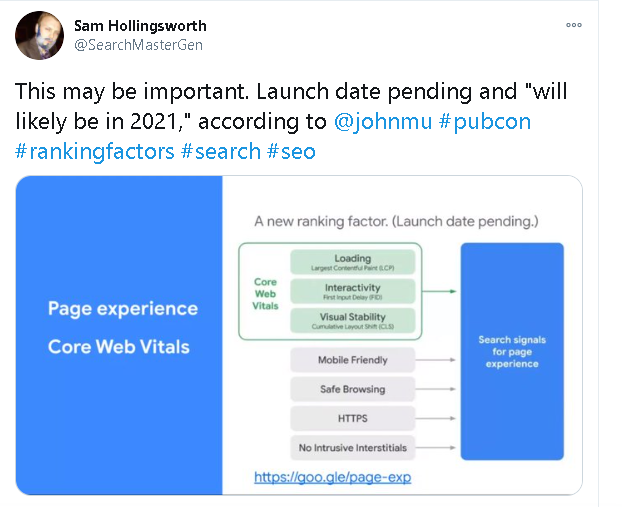
I took a look at Google’s press release to see if there was anything that stood out. Google announced that over time, they’d added factors such as page loading speed and mobile-friendliness, but they want to drive home the importance of on-page experience.
They’re looking at upcoming search ranking changes that factor in-page experience. Google says they’ll incorporate these page experience metrics for the “Top Stories” feature on mobile and remove the AMP requirement.
Google also says they’ll provide a full six months notice before rolling this out, so it does look like we have some time to think about it and get ourselves on track.
Core Web Vitals Metrics
As a website owner, developer, or builder, you consider a million different factors when putting together your website.
If you’re currently working on new sites or making updates to existing ones, you’ll want to keep these three factors in mind going forward.
Loading: Largest Contentful Paint (LCP)
Largest Contentful Paint or LCP refers to your page loading performance. It covers the perceived loading speed, which means:
How long does it take for your website to start displaying elements that are important to the user?
Do you see how this differs from regular page loading speed now?
There’s a huge difference here.
For example, it’s common practice to keep the most important information and eye-catching content above the fold, right?
Well, that’s no use to anyone if it takes all the interesting “above the fold” six seconds to load.
We see this all the time when sites have images or videos above the fold. They generally take up a lot of space and contain important pieces of context for the rest of the content, but they’re the last to load, so it leaves a large white space at the top of the screen.
Google is paying attention to this because they realize it’s causing a lot of people to bounce.
The general benchmark for Google is 2.5 seconds. This means that your website should display everything in the first frame (above the fold) in 2.5 seconds.
Keep in mind that webpages are displayed in stages. So when the final elements of the top of your page loads, that would be your LCP. A slow LCP = lower rankings and penalties and a fast LCP = higher rankings; it’s as simple as that.
Interactivity: First Input Delay (FID)
The First Input Delay or FID is the responsiveness of your webpage. This metric measures the time between a user’s first interaction with the page and when the browser can respond to that interaction.
This web vital might sound a little complex, so let’s break it down.
Let’s say you’re filling out a form on a website to request more information about a product. You fill out the form and click submit. How long does it take for the website to begin processing that request?
That’s your First Input Delay. It’s the delay in between a user taking action and the website actually moving on that action.
It’s essentially a measure of frustration for the user. How many times have angrily hit a submit button over and over because it’s taking forever?
This is a huge UX metric because it can also be the difference between capturing a lead or a sale.
Chances are, someone is taking action because they’re interested in whatever it is you’re offering. The last thing you want to do is lose them at the finish line.
Visual Stability: Cumulative Layout Shift (CLS)
Cumulative Layout Shift refers to the frequency of unexpected layout changes and a web page’s overall visual stability.
This one is straightforward, and I have a perfect example.
Have you ever scrolled through a website, saw something interesting, went to click on it, but right at the last second, a button loads, and you end up clicking that instead?
Now you have to go back and find what you were looking for again and (hopefully) click the right link.
Or, where you’re reading a paragraph, and buttons, ads, and videos keep loading as you’re reading, which keeps bumping the paragraph down the page, so you have to keep scrolling to read it.
These are signs of a poor on-page experience, and Google is factoring these issues as they strive to provide the best experience for users.
Going forward, the focus is on mimicking an “in-person” experience online. As more and more stores shut down and e-commerce continues to boom, it’s up to store/site owners to provide that in-store experience to their users.
For CLS, the goal is to have a score as close to zero as possible. The less intrusive and frustrating page changes, the better.
The Effects of Core Web Vitals on Content Strategy and Web Development
Now let’s talk about how to improve core web vitals and where you can get this information.
Head to your Google Search Console, where you’ll see the speed test was replaced with “Core Web Vitals.”
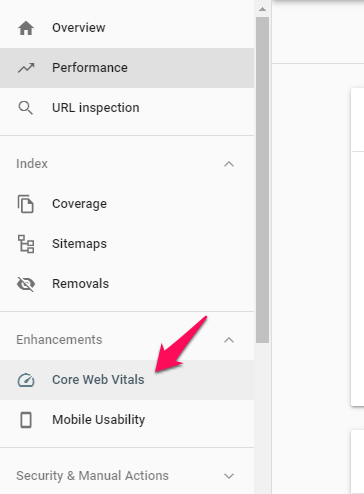
When you click it, it’ll bring up a report for mobile and one for desktop.
You’ll see a list of poor URLs, URLs that need improvement, and good URLs.
Remember that Google is factoring in the three things we discussed previously to determine the URL’s quality.
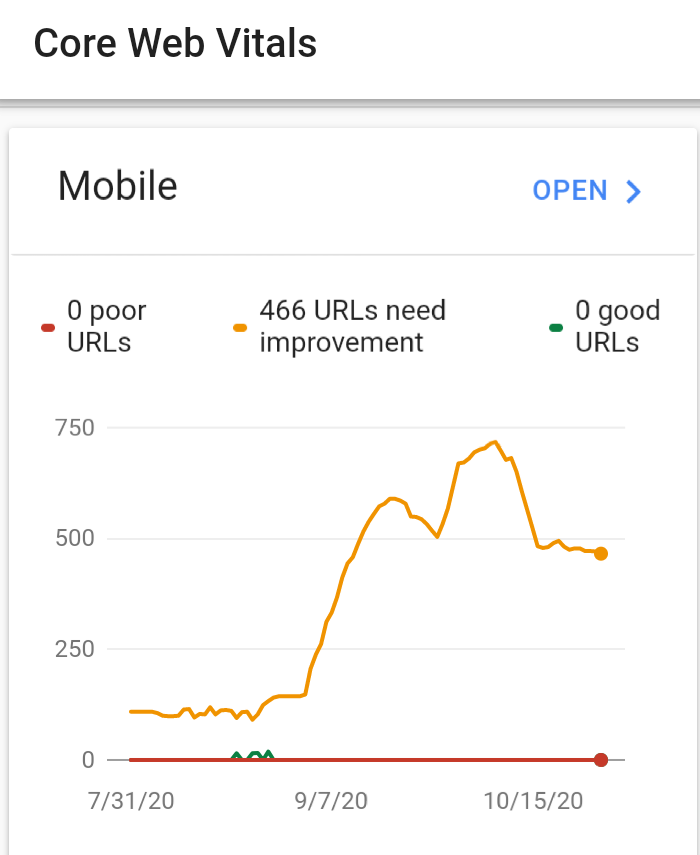
So, if you have many poor URLs, it means that they’re slow to display the most critical content, slow to process actions, and continually offer a poor experience by shifting layout too frequently.
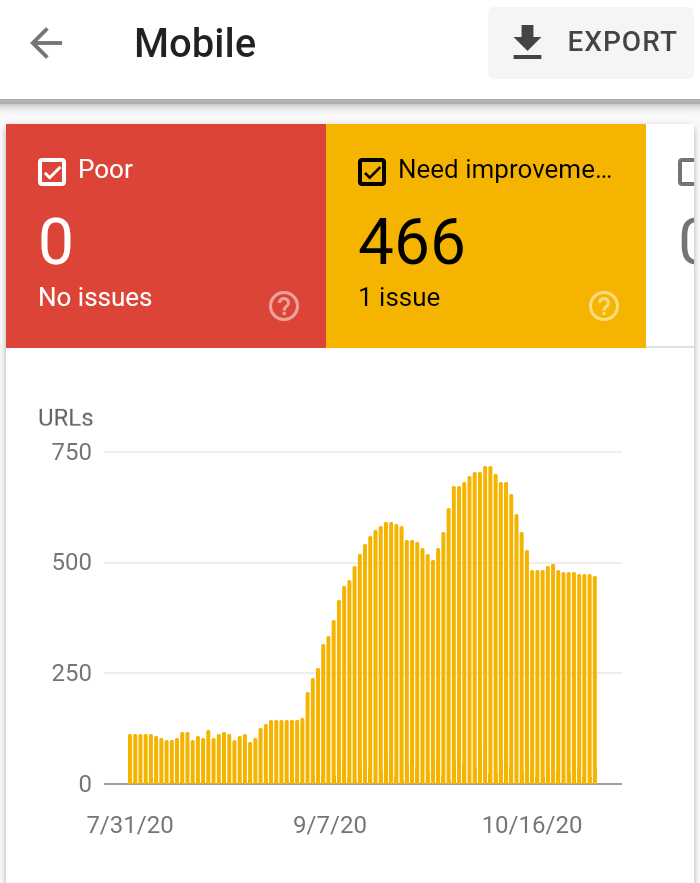
If the URL “needs improvement,” it may have a slight combination of two or three of these. A good URL checks out clean.
If you open the report on mobile, for example, you’ll see a page that might look like this.
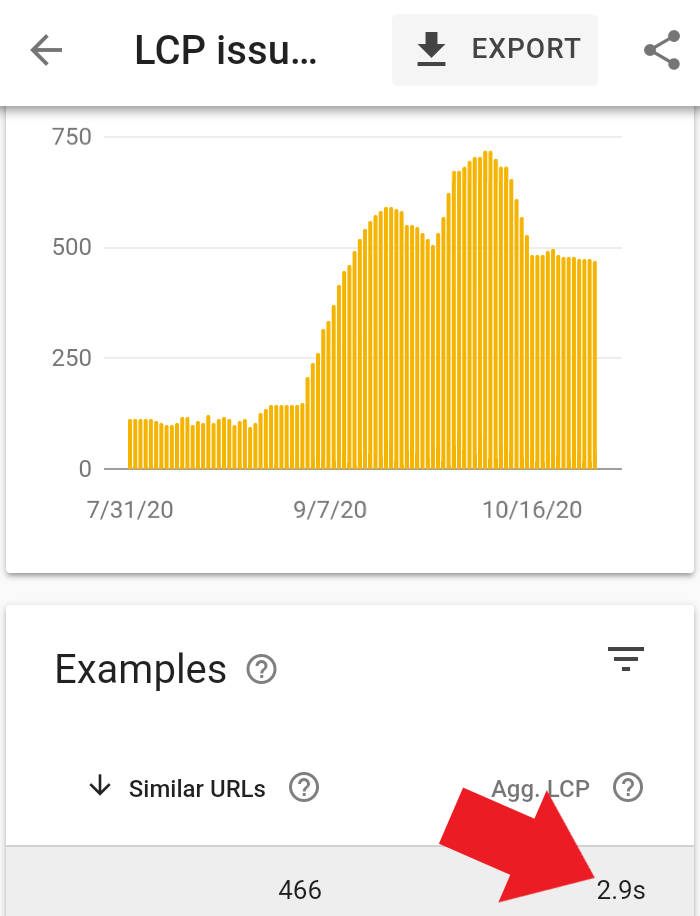
It’s an example of a website that needs improvement, and the issue here is LCP or page loading performance.
The goal is 2.5 seconds on mobile, and this URL has an average LCP of 2.9 seconds, so this shows clear room for improvement.
If we hop over to the desktop report, here are some examples of poor URLs.
This one has a CLS issue, which means that the website is loading in a way that changes the site’s physical structure too often.
The goal for this is 0.25, and this webpage has a CLS of 0.55. It also says that 472 URLs are affected by this same issue, so this website owner has a lot of work ahead of them to get this fixed.
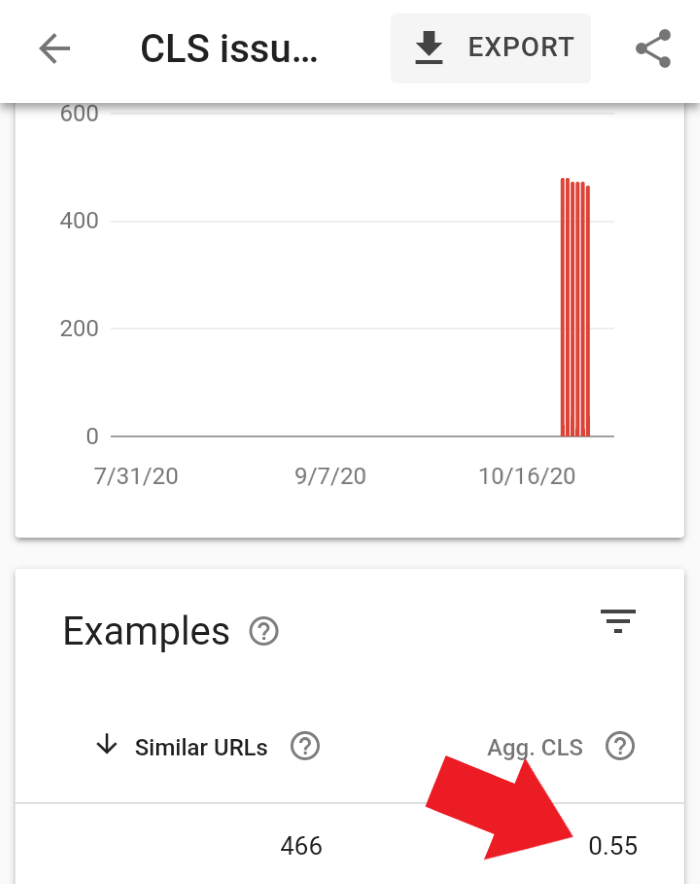
I’m a big fan of these reports’ transparency because Google makes it easy to locate the problem and fix it.
You can even click the “validate” button when you think you’ve fixed the problem, and Google will verify your progress and update the report.
How to Track Your Website’s Core Web Vitals
Tracking your Core Vitals is as simple as going into the search console and looking at each web property on a case-to-case basis. You’ll want to go in and play around with this to see where you stand.
How to Improve Core Web Vitals
Once you’ve pulled your report, it’s time to make some changes.
You’ll be able to improve the LCP by limiting the amount of content you display at the top of the web page to the most critical information. If it’s not critically important to a problem that the visitor is trying to solve, move it down the page.
Improving FID is simple, and there are four primary issues you’ll want to address:
- Reduce third-party code impact: If you have a bunch of different processes happening simultaneously, it will take longer for the action to start working.
- Reduce JavaScript execution time: Only send the code your users need and remove anything unnecessary.
- Minimize main thread work: The main thread does most of the work, so you need to cut the complexity of your style and layouts if you have this issue.
- Keep request counts low, and transfer sizes small: Make sure you’re not trying to transfer huge files.
Improving CLS requires paying attention to size attributes and video elements on all media. When you allow the correct amount of space for a piece of content before it loads, you shouldn’t experience any page shifts during the process.
It also helps to limit transform animations because many of them will trigger layout changes, whether you want them to or not.
Conclusion
Core Web Vitals and SEO go hand-in-hand, and we all know that we can’t ignore any single ranking factor if we want to beat out our competition and keep our rankings.
Do we know exactly how much of an impact core web vitals have on our ranks? No, we don’t. But Google is paying a lot more attention to the on-page experience.
Is your website following best practices for Core Web Vitals? Let us know!
The post How Core Web Vitals Affect Google’s Algorithms appeared first on Neil Patel.
32 Free WordPress Themes For Effective Content Marketing
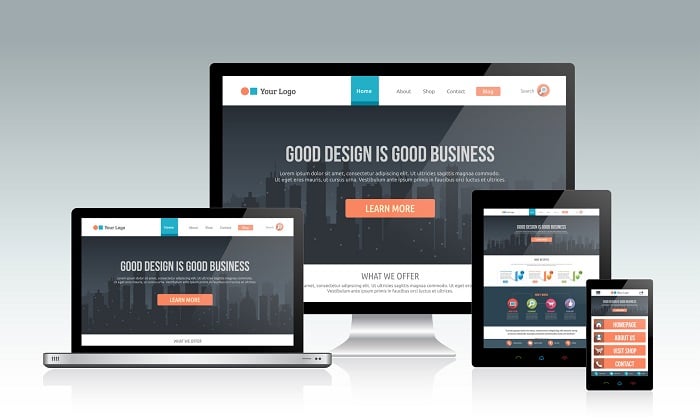
You already know that WordPress is a popular CMS and that most content marketers love it for their business or personal blog. But there’s a question lingering: How do you choose the right free WordPress theme when there are so many out there?
Trust me; it’s not as easy as you think.
When I started blogging, one of the crazy activities that killed my productivity was checking out new personal blog themes. I just couldn’t find the right one for me. But I know better now.
The reality is you need to find one of the responsive WordPress themes for your personal blog launch’s success.
Did you know that your success as a content marketer goes beyond writing great content?
There are so many factors that will ensure that you’re always at the top of your game and getting the juice from any given search engine.
Your attitude to work, the way you market your content, and, most importantly, your blog’s look all play a key role. It must have a responsive design, not just be pretty.
Investing in a professionally-looking theme is important, but what if you’re just a beginner and you want a free WordPress theme that still looks gorgeous? Can you find one?
Sure you can. I decided to write this article because I get a lot of emails from readers who want to find the right WordPress themes that will aid in effective content marketing.
A free WordPress theme is great, but don’t forgo a responsive design for your personal blog when many themes have a very cost-effective, one-time fee.
Trust me, I’ve got you covered. Without much ado, here is a list of 32 professional, free WordPress themes that you can download:
1. Sparkling [Preview – Download]
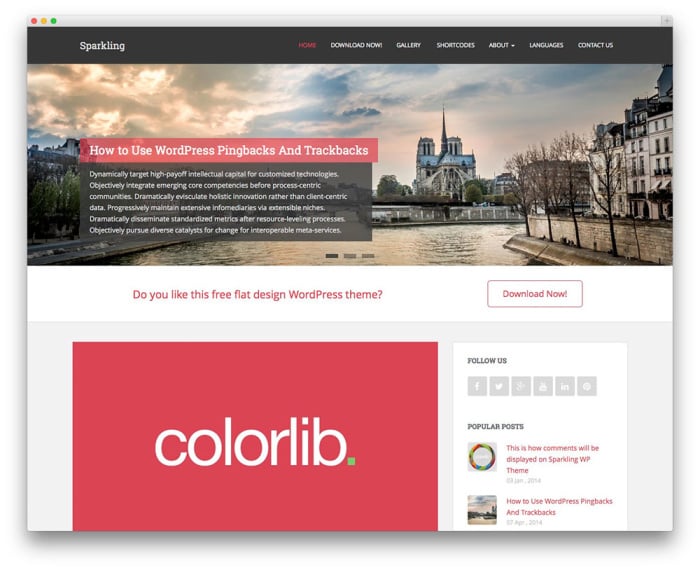
It’s time to sparkle your personal blog. If you’re looking for a flat, clean, and professional-looking theme, Sparkling may just be the right one. It was developed using Bootstrap 3.
This modern theme has a front-end framework feature that optimizes it to display smartphones, desktops, tablets, and other devices well. This WordPress theme is unique from the millions out there because of its pixel-perfect design, full-screen slider, and widgets that you’ll fall in love with.
‘Sparkling’ is built to have a premium layout, and every content marketer who prides content above everything else will benefit from it. If you’re looking for one of the SEO-friendly responsive WordPress themes, you’re in luck.
It’s Schema compatible — which is great for SEO. Most of the free and paid plugins out there are supported, such as SEO by Yoast, W3 Total Cache, Quick AdSense, Akismet, Contact Form 7, Gravity Forms, and more.
For effective content marketing, you need a WordPress theme that hands control over to you so that you can add, modify, or delete any plugin, section, or even modify the layout as you see fit.
Whether you’re interested in using the Sparkling WordPress theme for your personal use or business, you’ve won the jackpot. This theme cuts across different industries such as education, business, web design, marketing, health and fitness, and many more.
2. Dazzling Free WordPress Theme[Preview – Download]
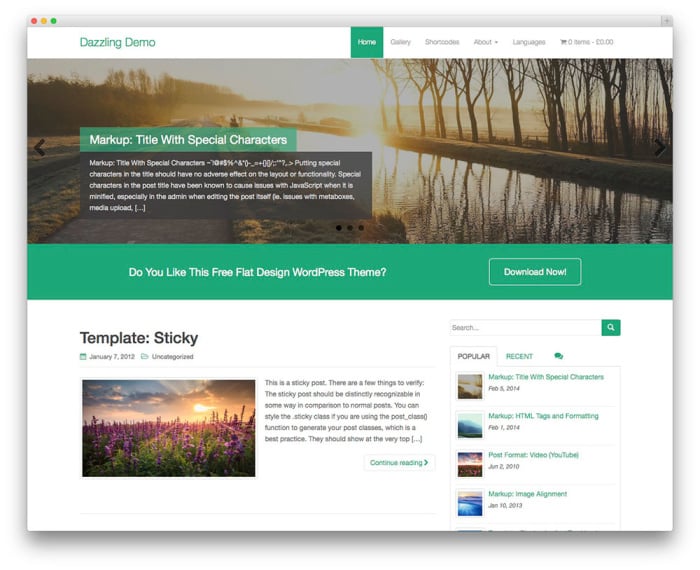
Dazzling is an unrivaled responsive theme. It’s developed using Bootstrap 3 and comes with an optional full-screen slider. This is useful when you’re building your first corporate or portfolio site.
This flat theme has mint green accent colors and will inspire you to embrace the best side of content marketing. I’m fond of this theme because it’s clean, unbeatable, and will enhance your personal brand. What more could you want?
Startup entrepreneurs, CEOs, and public speakers will benefit from the full-screen slider because they’ll use it to showcase their keynote speeches or other key presentations.
Dazzling WordPress theme includes added optimization for a lot of the essential plugins and custom widget designs out there, such as All-in-one-SEO Pack, JetPack, Contact Form 7, and more.
3. OceanWP [Preview — Download]
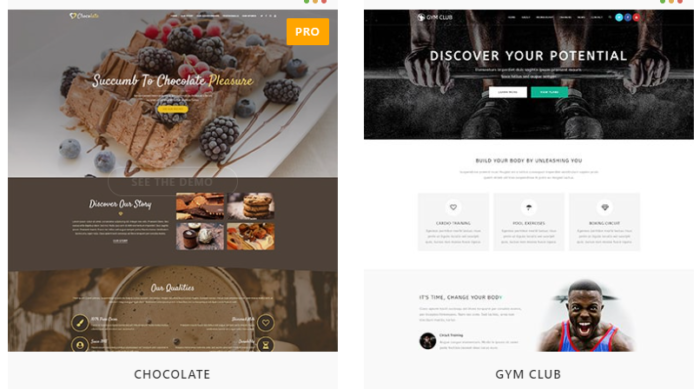
OceanWP is a single theme, but it’s so customizable that it feels like getting multiple themes all at once. With more than 3 million downloads, there’s a good chance you’ve come across a few websites using this ultra-flexible theme.
What really stands out about OceanWP is its demos — these are essentially fully-build websites you can copy and then customize. The theme is fully responsive, offers fast load times, built-in SEO features, and is translation ready.
If your business sells physical or digital products, OceanWP has you covered with built-in WooCommerce functionality.
4. Travelify [Preview – Download]
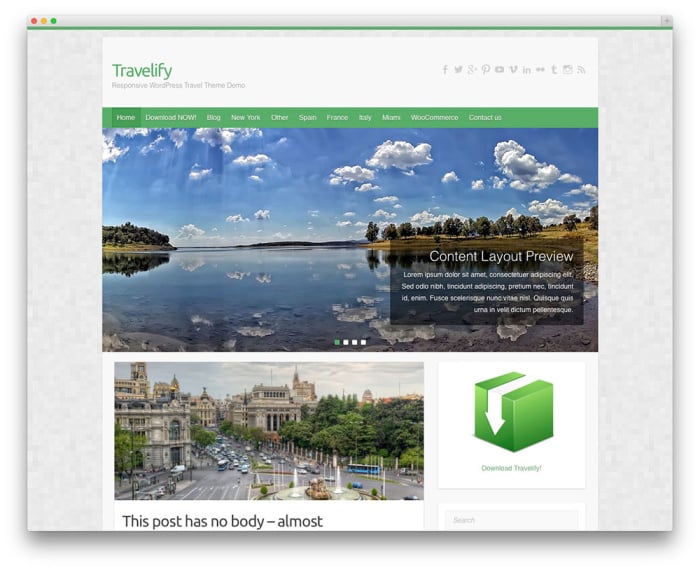
Travelify is another free WordPress theme. It has some premium functionalities that allow you to change the theme layout (full, no sidebar, or wide, for example).
This responsive WordPress theme is mobile responsive, modern, and can be used for virtually any subject or business objective. For example, if you’re a content marketer, Travelify puts value on your content and highlights your best work for your readers to enjoy.
It’s a pixel perfect design, with a featured slider which you can turn off with a single click. The flexibility that the theme offers enables you to alter its layout until it suits your objective. You can also use a background image to customize the theme to your brand.
5. Ascent Free WordPress Theme[Preview – Download]
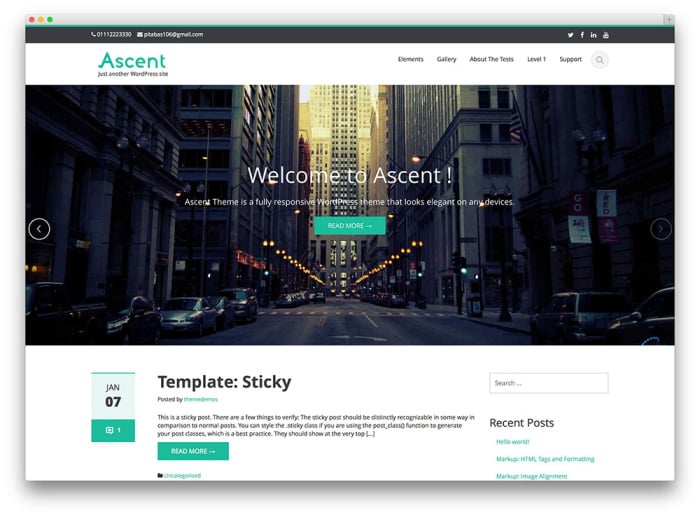
Ascent WordPress theme is designed with responsiveness in mind. This means that it’ll appear well on tablets, smartphones, laptops, and desktop of all sizes. The innovative technology used is based on CSS3 and HTML5.
What I like about Ascent is the richness of the slider that appears above the header. It’s more than just a personal blog; it’s a visual blogger’s dream.
In other words, your pictures get an added optimization that would make them stand out from the rest. If you’re a photographer, digital marketer, or content marketer, you can use Ascent to improve user experience.
This theme has been downloaded over 30,000 times, making it one of the most popular responsive WordPress themes of both professional and free.
A right and left sidebar gives you added flexibility, and this theme is translation-ready. This is essential if you’ll be serving a wider audience in different languages.
6. Auberge [Preview – Download]
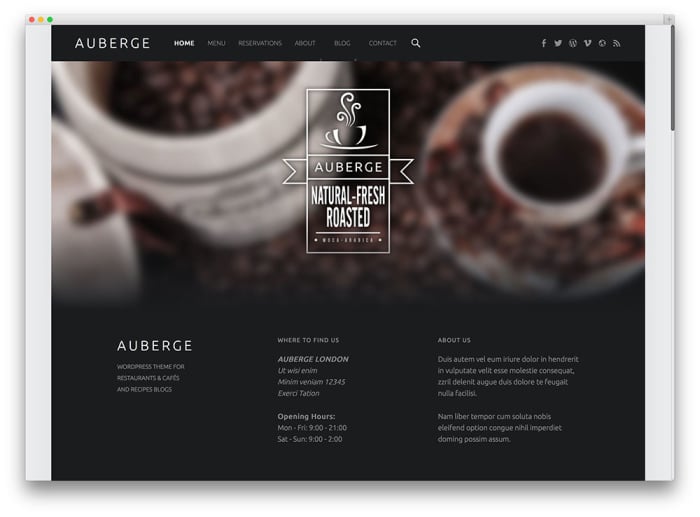
Do you struggle to create the right content for your customers? You’re not alone. If you want to attract and nurture an audience with your personal blog, you need various content.
But, let’s assume that you’ve created a variety of content; how do you showcase all of them in the right manner? You need the right WordPress theme and Auberge may just be the right one.
This impressive WordPress theme is free, professionally-designed and it’s currently used by over 30,000 blogs. Auberge’s overwhelming quality and usefulness make it a one-stop theme for those who want to expand their content marketing reach.
Auberge is built around a mobile-first design concept, which makes it 100% mobile responsive. One vital reason why you probably should consider this theme is because the content can be easily showcased on retina displays that have high resolutions.
A challenge that most site owners face when showcasing their best content, is resizing and compatibility issues, which severely drops the value of the content.
The theme would suit every niche, but it’ll probably best serve restaurants and cafe pages. When constructing your pages, you can use the Beaver page builder plugin. You can download and use the lite version at no cost.
7. Hestia Free WordPress Theme [Preview – Download]
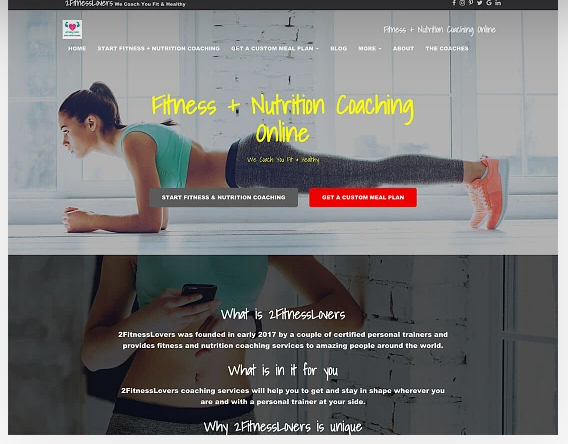
Hestia is a website builder that features a slick, fully customizable design. Don’t let their branding as a”one-page theme” make you think it will limit you — you can build a fully functional, multi-page site with this theme.
Top features include easy to use customizer, WooCommerce ready, page builder compatibility, and fast load times. It is also SEO friendly and provides clean, optimized code for fast loading times.
If you are looking for a highly flexible theme with e-commerce capabilities, Hestia is a solid choice.
8. Awaken [Preview – Download]
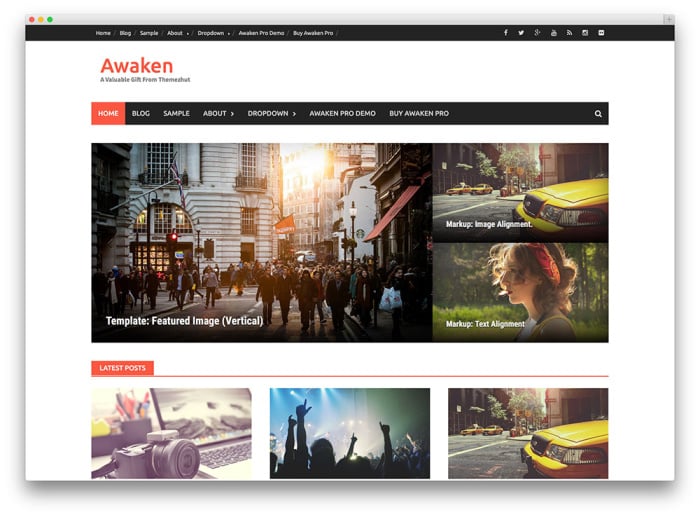
Awaken WordPress theme is free and has a 4 out of 5-star rating. If you’re fond of a minimalist design, this theme is for you. It’s extra white spaces push your content to the forefront and eliminate distractions.
Awaken is a magazine theme that includes two widget areas. The posts are also showcased, using three distinct widgets.
The layout of this theme is constructed using the Bootstrap framework, with mobile responsiveness in mind. In particular, mobile users will benefit from your blog, if you use this theme.
Another essential feature of Awaken is the nifty slider. The theme options panel gives you added flexibility, which enables you to change the theme color, font attributes, and links.
9. Neve Free WordPress Theme [Preview – Download]
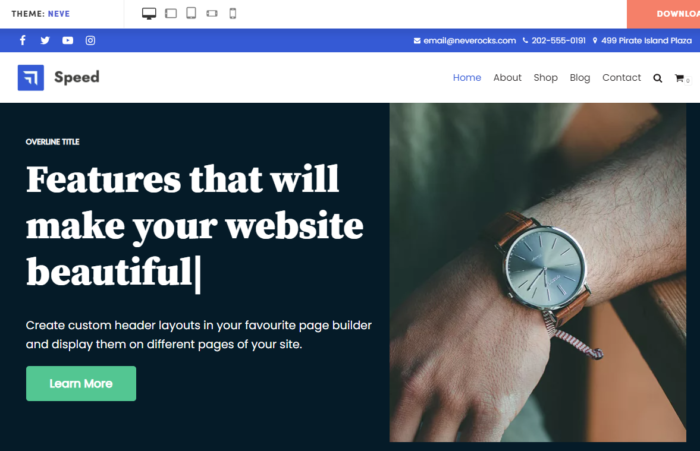
Neve is a light, modern WordPress theme that will serve your content marketing needs because it has clean and validated code.
This means that no matter how minimal your technical skills, you can edit and structure your theme to display your content well.
With basic HTML/PHP knowledge, you can structure your content display area. If you’re not a skilled developer, you don’t have to worry, because the theme options panel enables you to update your settings, including custom header and footer designs and layout.
One other feature of Neve WordPress theme offers easy setup, reliable updates, fast load times, and it is compatible with AMP.
Neve is focused on being lightweight, fast, and easy to use, making it an ideal free WordPress theme for beginners or anyone who wants an easy-to-build site.
10. The SSMAG [Download]
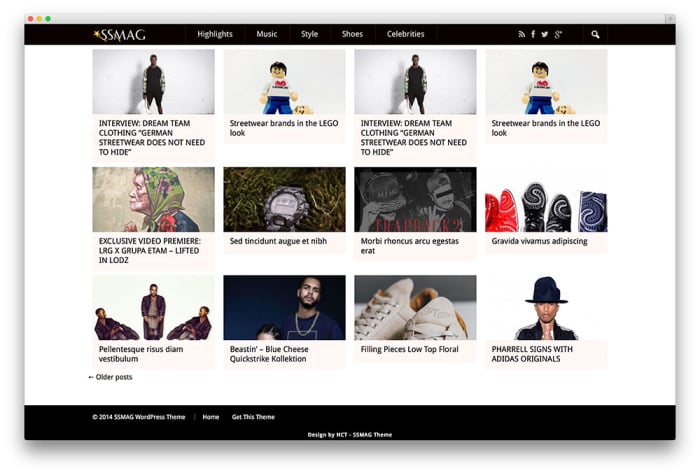
SSMAG is a mobile responsive, plug and play free WordPress theme that has a grid-based layout. Content creators will find this theme useful, because of its feature that positions your content to go viral– well-designed social share buttons.
The design layout is optimized to engage readers and to cause them to explore your site further. SSMAG was created in 2015. It has custom widgets, to display text and HTML elements.
Apart from being browser compatible, the SSMAG theme supports embedded video, which will play a vital role in explaining what your blog is all about, instead of using your featured image on a post page.
11. Albar Free WordPress Theme [Preview – Download]
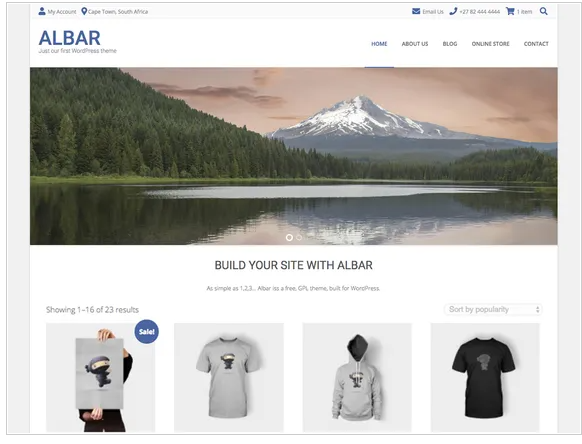
Albar is a multipurpose WordPress theme that can be used to build a business website, portfolio, e-commerce store, or blogging site. It is responsive, which means it easily adapts to all types of devices including tablets, mobile phones, and desktop computers.
The theme features minimal settings to make it easier to use, but enough customizations to let you build exactly the site you need. It is lightweight, scalable, and offers security features so your site will be fast and secure.
12. Esteem Free WordPress Theme[Preview – Download]
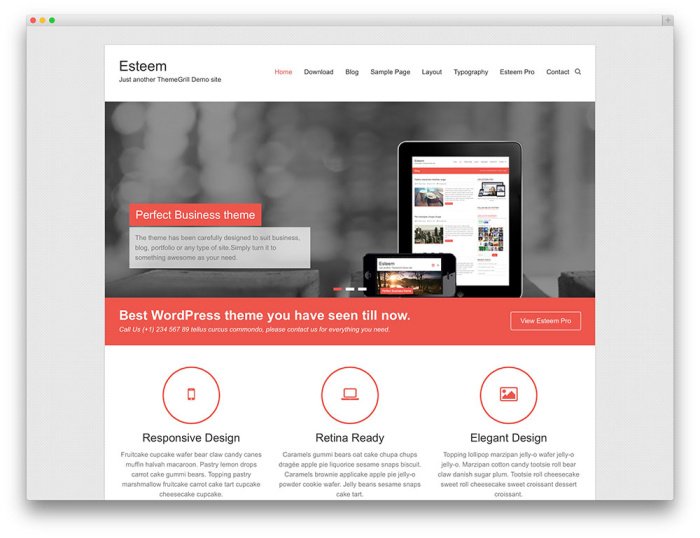
Most beginners to blogging are looking for a WordPress theme that will showcase their portfolio or samples so that potential clients can find them easily. If that’s what you’re after, Esteem will be the right personal blog theme for you.
Esteem is a simple theme that offers unlimited theme color options so that you can change the feel and look of your site to stand out from the competition. The Esteem theme comes with two custom themes.
One of the themes is custom-built to display your products, portfolio or services. You can upload and set your custom logo and site title from the theme options panel.
If you want to gain traction, nurture a loyal audience, and establish your brand online, you should leverage the Esteem theme customizable header image.
13. Accelerate Free WordPress Theme [Preview – Download]
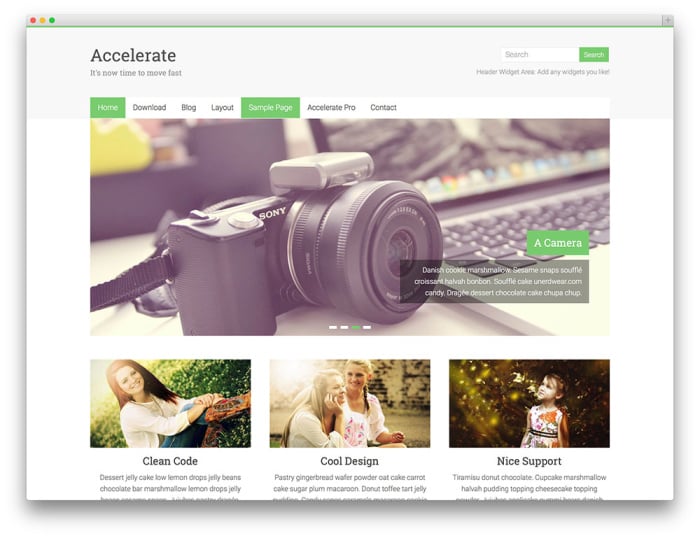
Who says that you can’t find a modern WordPress theme with a premium look for your site?
Well, Accelerate is right here to fill that spot. Accelerate is a super flexible theme that’s suitable for portfolio, personal, travel, corporate, or business services sites.
If you’re an artist, like a photographer or illustrator, you can use the fullscreen slider to showcase your best work.
Accelerate theme sends a strong, clear message to your target audience, through its flat and straight-forward design that blends perfectly with your content (video, blog posts, audio, etc).
Accelerate is fully responsive and displays well on any type of mobile device. Moreover, the theme is retina-ready, to enhance your audience viewing experience and lower bounce rate.
14. Ample [Preview – Download]
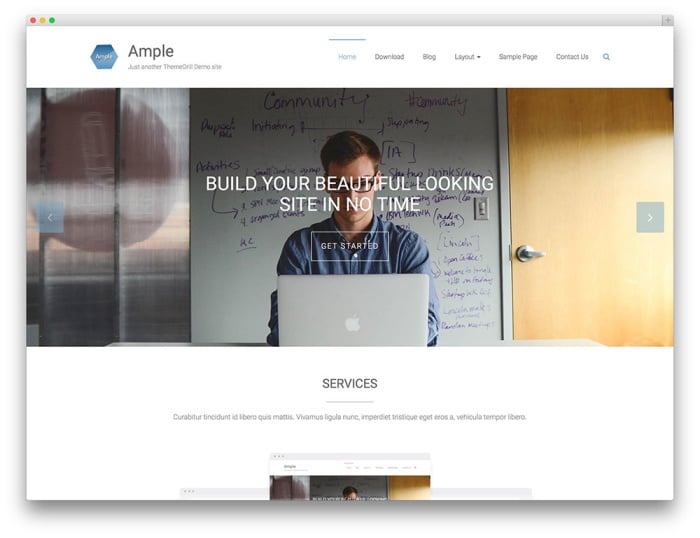
It’s time to personalize your blog with this eye-catching and professional theme. Ample is a free minimalist and multipurpose WordPress theme that comes with feature-rich options for customizing your layout and setting the right metrics for your site. Mobile device responsiveness helps your search engine results.
Building your personal brand is an essential part of running a successful online business. So, it’s necessary to customize your site, by adding a professional logo and relevant header text that will appeal to your target audience.
Ample multipurpose WordPress theme is suitable for business or personal blog use and will play well in any industry, but it’s particularly useful for authors, freelance writers, and book review writers.
15. WP-Premium Free WordPress Theme[Preview – Download]
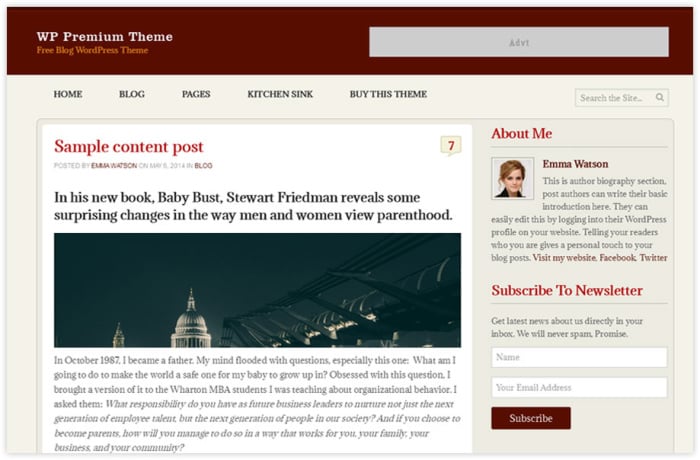
If you’re familiar with Copyblogger, you’ll agree with me that their first theme looked similar to this theme. I also know a few bloggers who started out with this theme, but later changed when their business grew.
Why am I saying this?
Well, it’s to let you know that WP Premium free WordPress theme provides a rich experience for the end-user, as well as premium functionality and a trendy look.
If you’re looking to start a serious blog, you should consider using WP Premium. It’s 100% responsive, which means that your texts and images will display smoothly on any device.
This theme is powered by Foundation – a front end framework that’s flexible, user-friendly, and professional.
WP Premium takes a content-first approach. The homepage widget areas let you manage your sidebar, header, navigation menu, and footer. Other functionalities are a wide selection of widgets, such as the author widget that displays relevant information about the author or blog owner.
You also have the advertisement widget, for monetizing your blog content with AdSense, ClickBank, CJ, and any third-party affiliate network that supports HTML code and CSS.
16. Quickstart [Preview – Download]
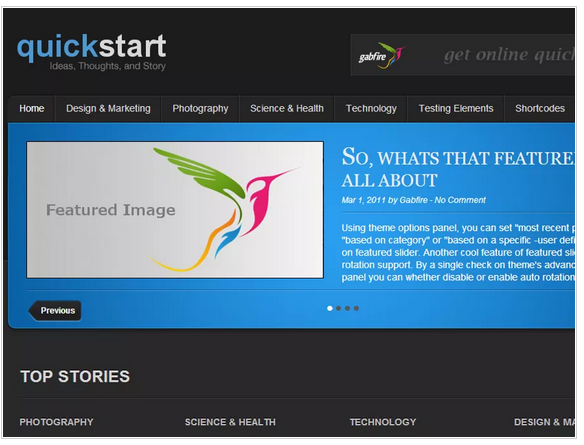
This is a free and professional theme from Gabfirethemes.com. What differentiates this theme from others is the fact that you can structure your personal blog layout as you want it to be.
Your category page doesn’t have to be a bland list of articles; you can now put the right content there and re-engage your audience. From the themes control panel, you can select alternative header templates quickly. No coding experience is required to effect this change in a highly responsive design.
Localization support is also enabled, because Quickstart was designed to appeal to international and local site owners. It supports multiple languages and it’s compatible with WPML’s multilingual plugin.
There is also another feature that makes this theme unique. The Gabfire module. This is an extended functionality that enables users to embed videos and default post images, so that the difficulty associated with embedding YouTube videos, for example, is eliminated.
Quickstart free WordPress theme is equipped with a single post image slider, category templates, page templates, and an advanced control panel. It’s search engine optimized and mobile one of the mobile responsive WordPress themes we like.
17. Astra Free WordPress Theme[Preview – Download]
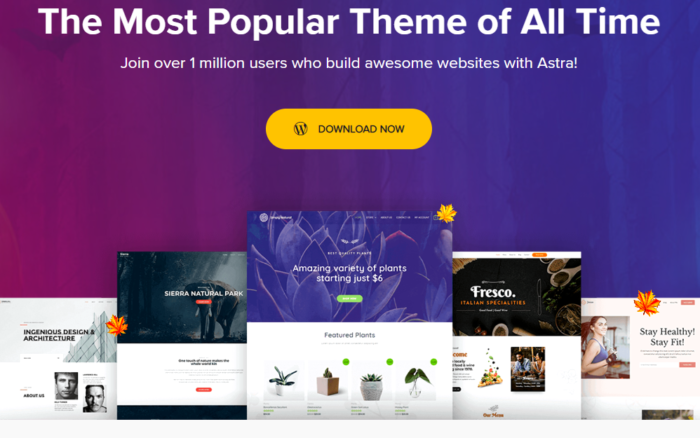
Astra has some amazing functionalities that you’ll love. This is a professional-looking theme that would have sold for $39 or more, but you can download and use it as a free WordPress design.
It has a clever ‘above-the-fold’ slider that displays your best and latest works. If you’re an author, you can use this to showcase your book. If you’re an artist, such as a photographer, illustrator, or web designer, this sleek slider will be very helpful for you.
Astra free WordPress theme displays your content using the default font face that’s clear and professional. If you’re an intermediate blogger or online entrepreneur and need a sophisticated theme that has all the modern functionalities intact, Astra may just be the right one for you.
18. Onesie [Preview – Download]
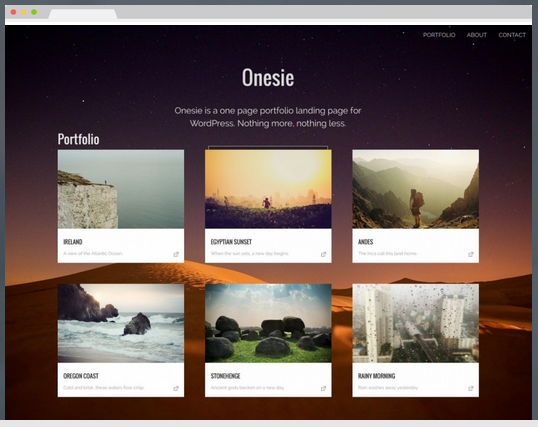
As the name implies, Onesie is a flat and free WordPress theme. It’s a one page, responsive theme and can be used for business or personal blog purposes.
It adapts to different screen sizes, making it possible for your texts and images to display perfectly on iPads, iPhones, tablets, and other mobile devices, including smartwatches.
Onesie is easy to customize. You can change the background image to whatever you want. The header images can be customized to your taste. You can also create custom navigation menus, choose the right font, and alter the layout design for optimal user experience.
Onesie is browser compatible, which means that it displays perfectly on popular search engine platforms that your target audience will most likely be using, such as Mozilla Firefox, Opera, Google Chrome, Internet Explorer and more.
It also contains standard theme features, such as the theme options, automatic updates, and translation-reader functionality.
19. Path [Preview — Download]
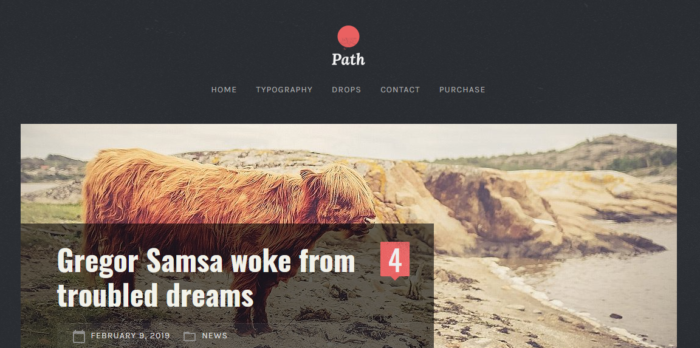
Note: Path is no longer free, but at just $14, it’s still incredibly affordable and may be worth the cost if you love the features!
You can use Path, a stylish WordPress theme, if you’re working on a multi-author or magazine-related site.
One powerful functionality of Path is that you can use the built-in WordPress custom header to manage your site’s feel, control the logo and other branding aspects of your site, as long as it’s in agreement with WordPress and Hybrid Core.
Several plugins, such as Gravity Forms, Social Path, SEO by Yoast, and more, are fully supported. No matter your industry, as long as you’re passionate about building a community, creating viral content, and generating leads for your business, you can use the Path theme.
20. Sinatra Free WordPress Theme [Preview – Download]
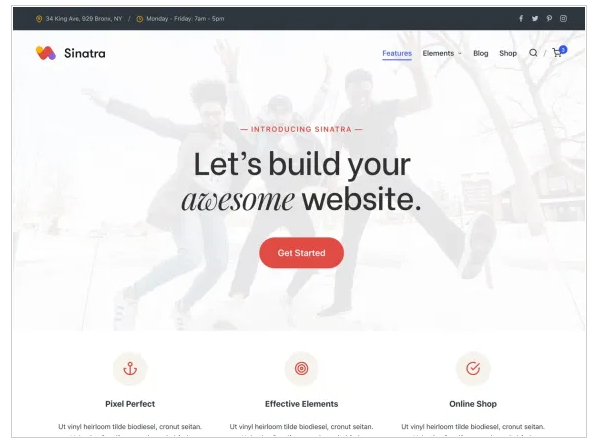
If your theme looks professional, it’s going to give you a mindset that makes you think as if you’re on top of the world. You might be a personal blog beginner, but it wouldn’t make any difference – because you’re already on the right foot.
Sinatra is one of the most lightweight and easily customizable WordPress themes that you can download for free. It’s designed by sinatrateam.
This is one of those themes that could have been sold for $39 or more, but the company decided to give it away. While it’s still free, you can download it for your next blog.
It’s mobile responsive, SEO-friendly, and contains multiple layouts for customizing your blog so that your content gets attention. It’s also translatable and built with SEO best practices in mind.
21. Calenotis Magazine [Preview]

Calenotis Magazine WordPress theme comes free of charge. It’s ideal for any type of project.
If you’ve just launched your book (whether ebook or hardcopy), or you want to create in-depth content that will generate organic traffic for you, this magazine theme will do the job right, from the very beginning.
Calenotis is a popular theme used in the health and fitness industry. The majority of the internet marketers out there aren’t aware of this theme. If they were, why would they not be using it?
The good news is that you’ve got the chance to use it while it’s free. The fullscreen slider will house your best works, latest pictures, upcoming programs, and more. This theme was designed using the minimalist principle – “omit needless things!”
The default font size for the body text may not be perfectly legible, but with HTML and CSS experience, you can always change your text’s size to suit your users.
22.Portum Free WordPress Theme[Preview – Download]
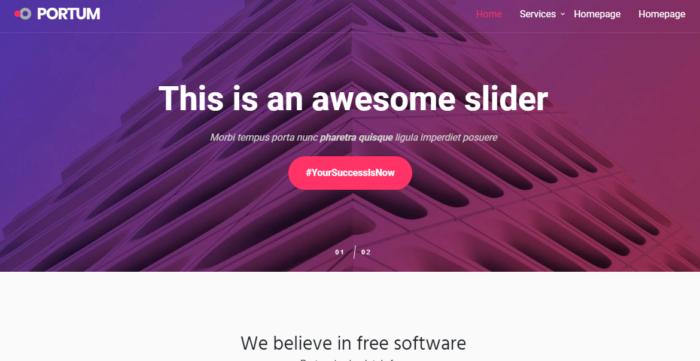
Portum WordPress is free, responsive, and has a stylish front page slider where you can showcase your best work. This theme also supports modern web tools and plugins.
Site speed is one of the Google ranking factors that you’ve got to always consider. This theme is super fast. Your users will thank you for it.
The single post area is professionally designed, and the font style and size are carefully set to make maximum impact. This is a true, modern free WordPress theme that’s responsive, used by thousands of sites, and is absolutely free.
23. Typepress [Download]

Typepress is a free and colorful WordPress theme. Colors drive people. In fact, in the psychology of colors, certain colors have proven to improve click rate on call-to-action as well as increase sales.
If you’re looking for a free theme that will be colorful, agile, and has all the powerful functionalities to build your business, Typepress could be your answer. It was developed by Arm Studio and released for free to the world.
Browser compatibility is one feature that makes this theme a resourceful one. No matter what browser that you or your visitors are using, they’ll not have issues reading your content, watching videos, or downloading your report. Even on mobile devices, mobile users will enjoy navigating your site because of it’s mobile-friendliness.
24. Foodica Lite Free WordPress Theme [Download]
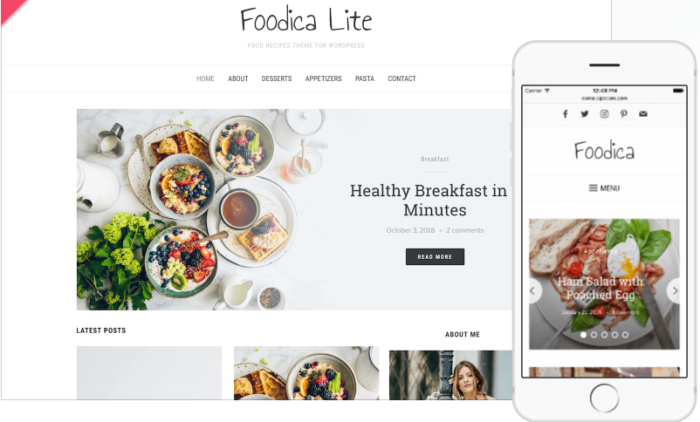
Not all content marketing sites are business blogs or news sites. If you’re looking to build a food or recipe-based website, consider Foodica.
Foodica fills the food-blog gap by providing a beautiful, easy to use theme for food or recipe-based websites. It features a beautiful slider, responsive layout, and featured slider support for posts.
Note that there are two versions of Foodica — the Lite version is free, while the Pro version costs $69 and comes with additional customizations, support, and a recipe index.
25. Business Free WordPress Theme [Preview – Download]
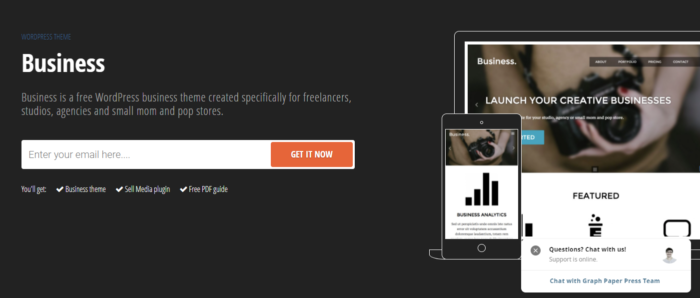
When you mean business (a site that will make you money), you’ve got to consider a theme that was designed for that. There are several ways to monetize and make money from a blog.
That said, do you know that the manner by which you place your affiliate links, promotional banners, and other calls-to-action plays a vital role in your conversion rate?
Absolutely. It does!
Business WordPress theme may be free, but it comes with premium functionalities that make it easier to advertise on your blog like a pro. Apart from the monetization aspect, the single post is given top priority, as well.
You can customize your logo, header image, background color, or other images. Its responsive design with the drag-and-drop slideshow interface gives you an added experience, and your site visitors will fall in love with it.
26. GreatMag [Preview – Download]
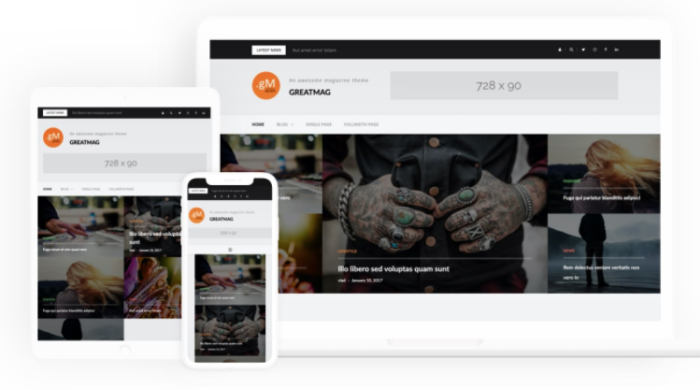
GreatMag is 100% free to use. It’s a magazine theme and has features that enable you to optimize your homepage and add important sections such as about us, our portfolio, products, and careers.
The front page image slider is ideal for showcasing your latest completed projects, clients you’ve worked with, testimonials, or some of the works you’re proud of.
When it comes to branding, GreatMag is flexible. You can upload your logo in the header section, and it’ll be seen clearly because the space provided is large. You can also use different themes to customize your site to your liking.
It also offers bundled widgets so you can easily (and quickly) get your site up and running, works with Google Fonts, features a page builder, and is 100% translation ready.
27. Basic Free WordPress Theme [Preview – Download]

At some point in your blogging business, you’ll need to focus on getting the right content out, attracting a loyal audience, and answering their questions. You may not need a fancy theme at such points, except if you don’t have enough money to buy a premium theme. But, you can use this Basic theme.
You may think that there is nothing special about ‘Basic’ free WordPress theme, but that’s not true. Most successful marketing blogs are built on minimalist personal blog designs, with the primary focus on the content and user.
If you’re just starting out with WordPress, you need to start with a theme that you can learn from, not a sophisticated one that requires a high level of coding experience.
The layout of the Basic free WordPress theme is super simple, giving you the freedom to customize your site’s look and feel. You can achieve this through the Themify options panel.
This theme was designed with features that will take you from where you are in your content marketing career to a new level. The lightbox gallery, RSS, footer menu, 5 theme skins, social icons, child theme support, and more will enhance your blogging experience and that of your users.
28. Parallax [Preview – Download]
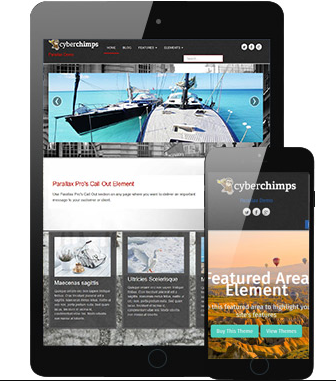
Parallax is a free WordPress theme, and I’ve seen it at work on several industry blogs. It’s well designed and has modern features to bring your content to life. It features parallax scrolling to present beautiful images in an easy-to-navigate format.
One of the challenges of content marketing is producing engaging content. Even if you succeed at creating the right type of content, how do you present it to your audience? What format will be best for you? Parallax is one of the responsive WordPress themes that can help here.
What if you can cut through the chase, use the different widgets for the header, sidebar, footer, and single post to showcase different content types such as videos, slide presentations, blog posts, e-books, and continue to evolve your site based on real metrics?
Parallax offers a drag-and-drop editor, meets SEO best practices, and helps increases time on page with 3D animation effects. Just remember that these images are heavy, so they can slow page speed down.
29. Airi Free WordPress Theme[Preview – Download]
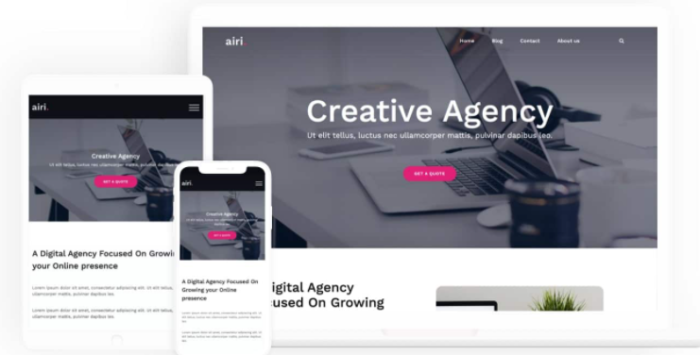
Airi is the right WordPress theme to use for pretty much any type of business site. For example, if you run a digital camera reviews blog, you can use this theme to display your best shots, edited works, and more.
This theme is highly customizable, as it was built with the Elementor plugin that allows you to easily move all the elements around. It also supports Ecommerce if your business sells physical or digital products.
Airi also offers a bunch of demos you can import, edit, and publish. If you want a professional website done fast, this is an ideal theme to consider.
30. Live Wire [Preview]

I like Live Wire WordPress theme because of two things: it’s free, and it’s clean. Any search engine will love its responsive design. It’s primarily designed with mobile in mind and includes an advanced options panel for structuring your layout. It supports Hybrid Tabs, post formats, Gravity Forms, and much more.
Live Wire has features that make it possible for you to customize several elements, such as your navigation menus, layouts, CSS, and even your background.
The theme also includes breadcrumbs, sticky posts, translation-ready capability, featured images, and more.
Note: LiveWire hasn’t been updated recently, but it still gets great reviews. Just keep in mind you could have issues with newer WP features and plugins.
31. Hemingway Free WordPress Theme[Preview – Download]
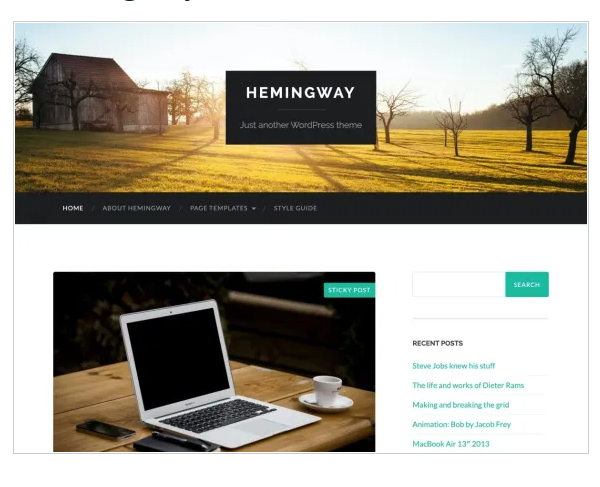
Hemingway’s free WordPress theme is specifically made for bloggers who want to improve their blogs. This theme was designed to conform with the latest version of WordPress, it’s streamlined, and it has the parallax scrolling effect.
It features a two-column layout that was designed specifically with bloggers in mind. Other features include retina-ready assets, block-editor supports, and customizable styles.
As a high-quality theme, Hemingway is sleek, but the developers kept it minimalist design style that always puts content first compared to some other highly responsive WordPress themes. It’s mobile responsive, which means that any device can display this theme perfectly.
32. Fullby [Preview – Download]

Fullby was inspired by Twenty Fourteen, one of the world’s most popular themes, with over 1 million downloads. At first glance, Fullby gives you that feeling of a professional site, because of its layout design.
The framework for this free WordPress theme is based on the latest Bootstrap framework. This is a grid style, lightweight, and fully responsive (displays well on any mobile or desktop device) theme.
You’ll also like the lightweight theme, which includes two customizable images, and the featured option for the posts can be structured exactly as you want it.
This is a good platform for your content, and the galleries and videos that are supported make this theme a favorite for most celebrities. If you’re a blogger, you’re a celebrity, too.
This Fullby free WordPress theme is fully optimized for search engines and has functionalities for your single post page and custom sidebar.
Conclusion
There, you’ve got it, the 32 professional, free WordPress themes to help make your content marketing more effective. Remember that it doesn’t matter which industry your working in because as much as content is king, design is the prime minister.
Getting one of the most responsive WordPress themes is important, even when starting. And there are so many to choose from.
When you give ample time to choosing the best theme for your blog, especially at the beginning, you’re establishing your foot in your industry. Your brand becomes noticeable to your target audience, and, trust me, that is priceless.
What is your favorite free WordPress theme, and why do you love it?
The post 32 Free WordPress Themes For Effective Content Marketing appeared first on Neil Patel.
source https://neilpatel.com/blog/32-free-wordpress-themes-for-effective-content-marketing/
How to Find and Fix 404 Errors

Do you know what sucks when browsing a website?
Getting a 404 page.
It doesn’t matter if they mistyped the URL or the page no longer exists. 404 errors can seriously harm your brand and negatively impact your SEO by making it harder for search engines to crawl your site.
That means finding and fixing 404 errors needs to be a priority.
In this post, I’ll cover everything you need to know about 404s, why they are bad for business, how to find them, and how to fix them.
What Is a 404 Error?
A 404 error is a code that indicates a requested page cannot be found.
Whenever a page loads in a browser, it has a response status code in the HTTP header that usually isn’t visible to viewers. These responses are grouped into five categories:
- 100-199 are informational responses
- 200-299 are success responses
- 300-399 denote redirects
- 400-499 denote client errors
- 500-599 denote server errors
So what exactly does a 404 error mean?
A 404 error (also known as an HTTP 404 or 404 code) is a very specific type of client error. It means the page the viewer is trying to reach can’t be found on the server.
Hard 404 vs. Soft 404 Errors
There are actually two types of 404 errors you need to watch out for.
While you’ll have probably come across a hard 404 request when browsing a website at some point, you’re unlikely to see a soft 404 error unless you get notified by Google Search Console.
A soft 404 happens when a non-existent page on your site displays a “not found” message to users but returns a 200 OK status to search engines.
This tells Google and other search engines there’s a page at that URL. As a result, crawlers waste time trying to crawl and rank the URL.
Here’s the thing: Google is pretty good at identifying these false pages.
When it finds a page returning a 200 OK status with all the attributes of a page that should return a 404 code, it slaps a soft 404 error on it and notifies the site owner in Google Search Console.
What You Need to Know About Your Site’s 404 Errors
Okay, so you know what these errors are. Now you need to understand what causes 404 errors.
There could be many reasons why your site is returning 404 errors.
You’ll get 404 errors if you’ve deleted or removed pages from your site recently without redirecting their URLs.
404 errors can also occur if you’ve relaunched or transferred your domain and failed to redirect all your old URLs to the new site.
Sometimes 404 errors can be the result of changing a page’s URL. Altering any part of the URL, whether that’s a category name or the page’s slug, will result in a 404 error.
Even mistyping a URL in an internal link can result in a 404 page and a broken link.
Why Are 404 Errors Bad for Websites?
A large number of 404 errors could spell big trouble for your website.
Let’s start with the user’s viewpoint. Continually running into 404 errors when browsing your site will result in a terrible user experience.
Even finding one 404 error can be enough to send a visitor packing.
Read that again: just one 404 error could cost you a customer.
It gets worse, because 404 errors can also damage your rankings.
404 errors aren’t a ranking factor per se, and Google won’t penalize you directly for having lots of them.
But they can harm your SEO.
The more broken links your site has, the harder it will be for Google and other search engines to crawl your site. Link equity won’t be passed around your site well, either.
Both of these can cause a drop in rankings.
You may also suffer from high bounce rates if users leave your site after landing on a 404 page. Unlike 404 errors, bounce rates are a ranking factor, and Google could penalize your site if its bounce rate is too high.
How to Find and Fix 404 Errors on Your Site
Now you know how bad 404 errors are, let’s look at how we can find them and fix them.
Finding 404 Errors
Site crawlers like Screaming Frog are a great way to find broken links that lead to 404 errors quickly. Screaming Frog is also free if your site has 500 URLs or less.
Start by running a site audit.
Then click on Response Codes in the top menu.

Filter for Client Error 4XX to get a list of every page returning a 404 error.
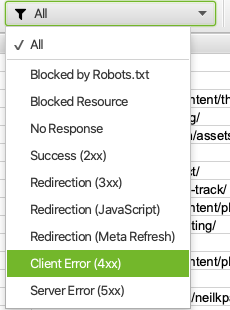
Site crawlers won’t give you a complete list of 404 errors, however, as they only show broken links.
But you can find every 404 error on Google Search Console.
Google Search Console provides a list of every 404 error Googlebot finds on your site. This includes both hard 404s and soft 404s.
Login to the Search Console, click Coverage, and select the Excluded tab.

You’ll see a list of hard 404 errors marked Not found (404) and soft 404 errors marked Soft 404.
Click on each to see a full list of pages returning 404 errors.
You can also find 404 errors in Bing Webmaster Tools by clicking Reports & Data and then Crawl Information.
Finally, you can find 404 errors using my SEO tool, Ubersuggest.
Head to the site audit tab in the left-hand sidebar.
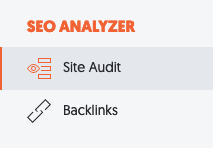
Run a Site Audit and then click Critical Errors.
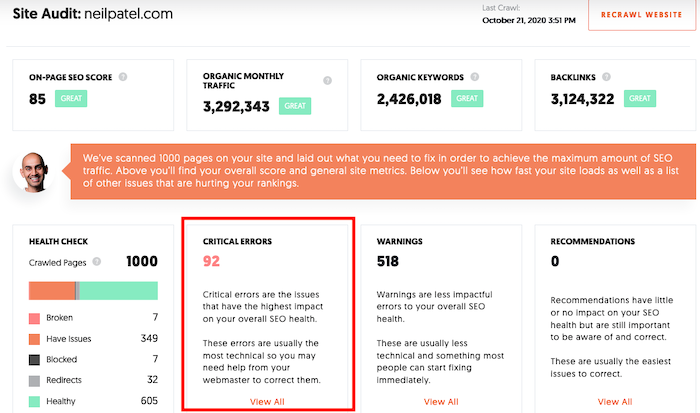
Then click on the Warnings tab at the top of the page.
If any pages return 404 error codes, they’ll be listed here. Click on the issue to see a full list of the pages.
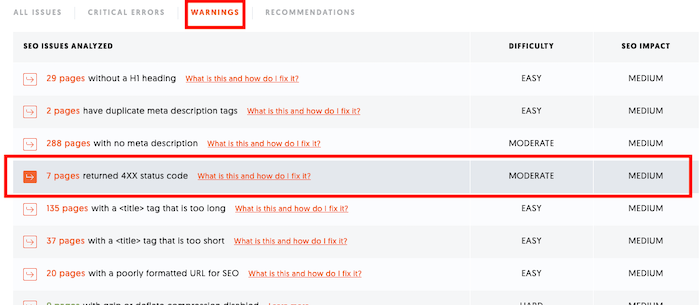
Fix 404 Errors
Now it’s time to fix all the errors you’ve found.
Here are four ways to do it:
- Redirect the 404 error: Redirecting users to another relevant page is the easiest way to fix 404 errors on your site. Just make sure you redirect them to something relevant — don’t just send them back to your homepage.
- Restore the page: If you find there’s still a lot of demand for a page you’ve deleted and there’s no suitable page to redirect users to, consider restoring the original page.
- Correct the link: If broken links exist on your site, you can simply edit the link to point to the correct URL. You won’t be able to fix links on websites you don’t control, however.
- Create a 404 page: By creating a custom 404 error page, you can make sure no visit is wasted—more on this below.
If you have a lot of 404 errors, you’ll need to prioritize your efforts. If you have 404 errors on any major pages, fix these first. Product pages, contact pages, and service pages with 404 errors should be fixed first.
Other pages may not be so pressing. Google Search Console may uncover 404 errors on pages that a human user would never be able to navigate to. You’ll want to fix them eventually, but these errors shouldn’t impact your rankings too much.
Find and Fixing 404 Errors on Your WordPress Site
If you have a WordPress site, you can use the same steps above to find 404 errors.
Found them? Great, now let’s fix 404 errors in WordPress.
If you’re getting site-wide errors, it’s probably an issue with your permalinks. Head to “Settings → Permalinks to update your settings.
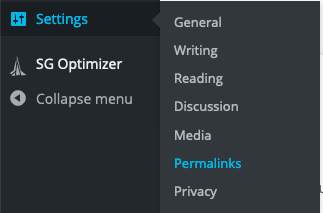
Click “Save Changes” at the bottom of the page once you’re done.
If specific pages are returning 404 errors, you’ll want to set up a 301 redirect for them. WordPress will try to do this automatically, but sometimes it doesn’t work.
The easiest way to do it yourself is by getting Yoast Premium or installing the Redirection plugin.
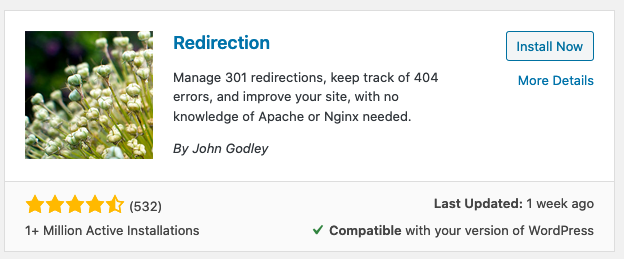
Once it’s installed and activated, head to Tools → Redirection.
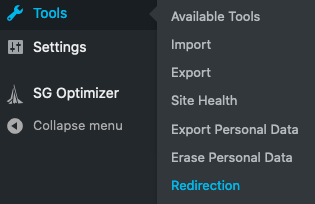
You’ll need to answer a few quick questions to set up the tool.
Then you’ll be able to redirect any URL on your WordPress site. Just enter the URL you want to redirect in the Source URL field and the URL you want to redirect the page to in the Target URL field.
Then click Add Redirect.
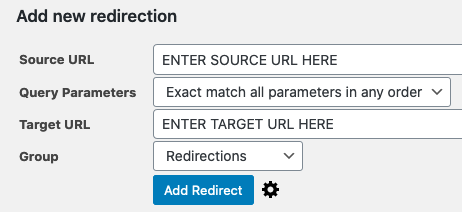
If this seems confusing or complicated, it might be best to have a website developer or your website hosting support team help you with this to make sure all 404s are redirected properly.
How Often Should You Check for 404 Errors?
How often you should check for 404 errors depends on the size of your site.
Smaller sites with less than 50 pages can probably check for 404 errors every month or so. Larger sites may want to run checks for 404 errors every week or every other day.
Other Top Tools to Find and Fix 404 Errors
The methods I’ve mentioned above aren’t the only ways to find and fix 404 errors. Here are some of the other leading tools you can use.
Dead Link Checker
Dead Link Checker is similar to Screaming Frog. You can use it to check up to 2000 links on your site to see if any are broken.

Google Analytics
Google Analytics doesn’t track 404 errors out of the box, but you can use it to find 404 errors if you have a custom 404 page.
Start by finding the name of your 404 page.

Mine is Page not found – Neil Patel.
Then open Google Analytics and head to Behavior → Site Content → All Pages
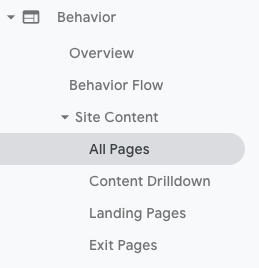
Now add Page Title as a Secondary Dimension.

Click Advanced next to the search bar, then change the rule from Page to Page Title and type your 404 page title into the Containing box.

You’ll now have a report of how many people landed on your 404 page, and where they came from.
MonsterInsights
If you have a WordPress site, MonsterInsights can do all of the hard work for you. Rather than creating a manual report in Google Analytics, simply install the MonsterInsights plug-in.
It automatically tracks your 404 errors as soon as you connect your Google Analytics.

Crafting a Unique 404 Error Code Page
I highly recommend creating a unique 404 error code page for your site.
Most standard 404 error messages are way too technical for the average user to understand, and they don’t help them find another relevant page.
With a unique 404 page, you can provide more value to your users and even help them find the information they are looking for.
You can also boost your branding and marketing efforts.
Many companies use a custom 404 error page to reinforce their brand image and inject a bit of humor. Creating a custom URL page also makes it easier to track 404 errors in Google Analytics.
Don’t go overboard, however. A clean and straightforward 404 page is much more effective than an overly elaborate one.
Make sure you include a 404 header status on your custom page, too.
If you don’t, search engines won’t recognize the page correctly. Google will keep displaying the page in search results and send you a deluge of soft 404 error messages in the Search Console.
If you need some inspiration, here are some of my favorite unique 404 page examples:
Airbnb

Airbnb makes the most of a 404 error by showing users a fun GIF and offering links to their site’s main pages.
Southwest
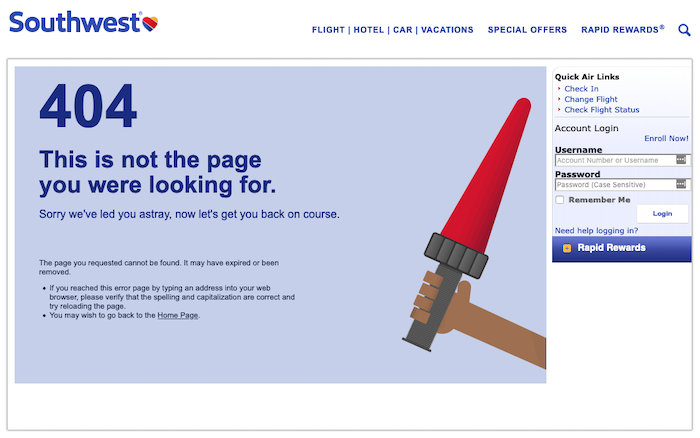
Southwest takes full responsibility for the mistake and explains how it may have happened if users want to try to find the page again.
Wendys

Wendys goes above and beyond with their 404 page. There are no links to other parts of their site here; just a free game users can play to pass the time.
Conclusion
If you have a website, 404 errors are inevitable. But there’s no reason to let them damage your site’s user experience and hurt your rankings.
Use the strategies and tools above to regularly run checks to find 404 errors and fix them quickly. The faster you fix them, the less damage they can do.
How many 404 errors have you been able to fix on your site? Let me know in the comments.
The post How to Find and Fix 404 Errors appeared first on Neil Patel.
How to Improve Your SEO Using FAQpage Schema
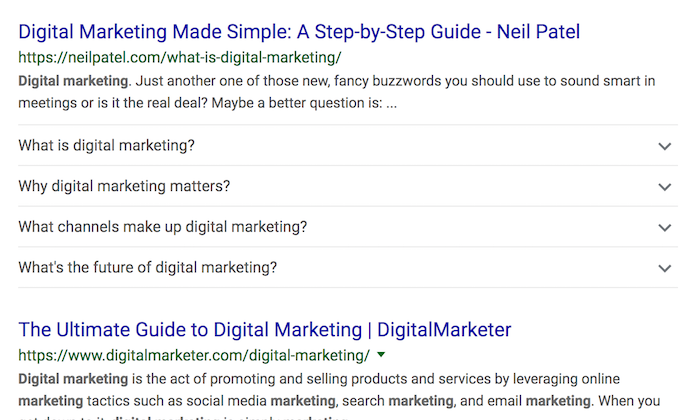
I’ve been testing a new SEO hack and it works no matter how old or how new your site is. What is it? It’s the FAQpage schema.
Even if you have almost no links, this strategy can help.
Best of all, unlike most SEO changes, it doesn’t take months or years to see results from this — you can literally see results in less than 30 minutes.
Even crazier is this: I had my team crawl 10,000 sites to see how many people are leveraging this SEO technique and only 17 sites were using FAQpage schema.
In other words, your competition might not know about this SEO strategy yet!
Google’s Ever-Changing Search Results
Before we dive into talking about FAQpage schema, I want to talk about Google’s ever-changing search results.
Not only does Google changing its algorithm on a regular basis, but they also test out new design elements.
For example, if you search for “food near me”, you’ll see a list of local restaurants and also see their ratings.
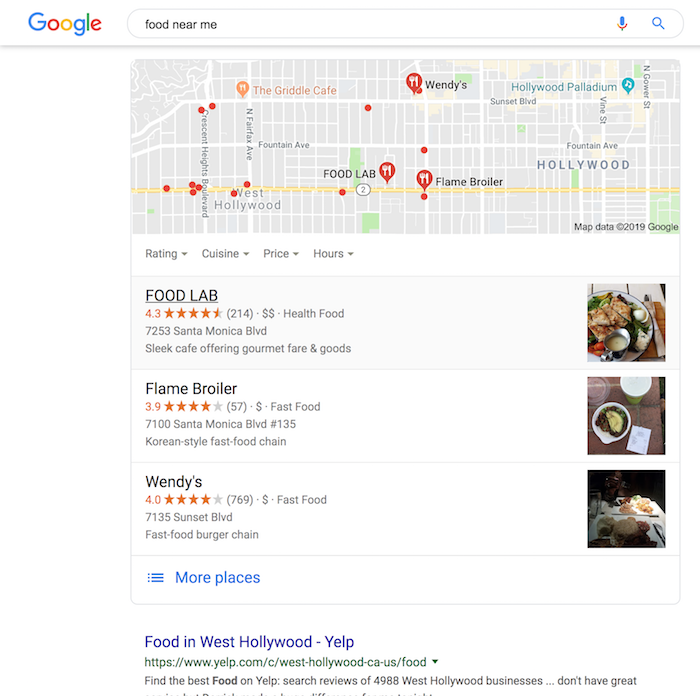
And if you look up a person, Google may show you a picture of that person and a quick overview.
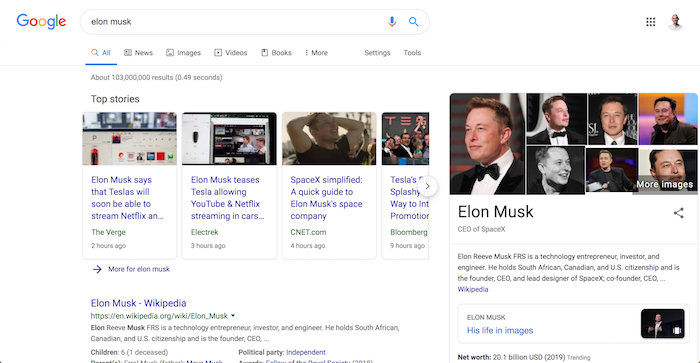
Over the years, Google has adapted its search results to give you the best experience.
For example, if you search “2+2” Google will show you the answer of “4,” so you don’t have to click through and head over to a webpage.

But you already know this.
Now, what’s new that no one is really using are FAQpage schema markups.
Here’s what I mean: if you search “digital marketing” you’ll see that I rank on Google. But my listing doesn’t look like most people’s:
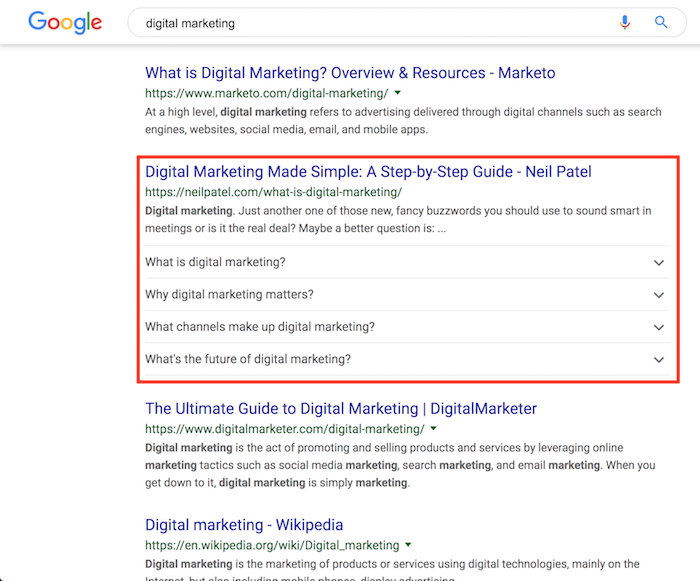
As you can above, Google has pulled FAQ-rich results from my site.
And best of all, I was able to pull it off in less than 30 minutes. That’s how quickly Google picked up the FAQpage schema addition and adjusted their SERP listing.
Literally all within 30 minutes.
You can do the same thing through Answer Cards anytime you have pages related to questions and answers.

So how can you do this?
Picking The Right Schema Markup: QA vs FAQpage Schema
Before we get this going with your site, you have to pick the right schema markup. There are two types: QA and FAQpage schema.
FAQpage schema is used when you offer a Frequently Asked Question page or have a product page that contains frequently asked questions about the product itself.
This will let you be eligible for a collapsible menu under your SERP with the question, that when clicked on, reveals the answer.
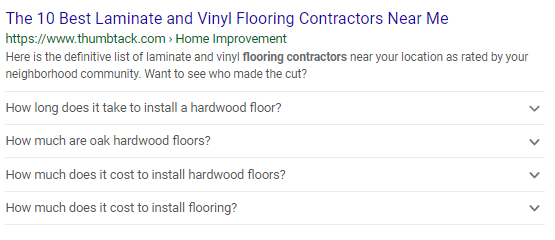
It can also let you be eligible for FAQ Action that is shown on Google Assistant. This can potentially help get you noticed by people using voice search to find out an answer!
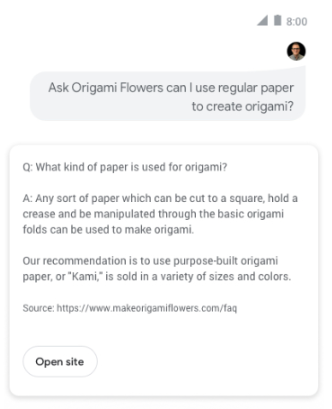
Q&A schema is used when people are contributing different types of answers and can vote for which answer they think is the best. This will provide the rich result cards under your SERP and shows all the answers, with the top answer highlighted.
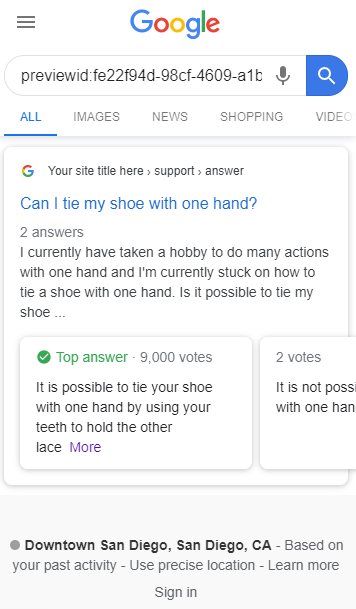
After making sure you understand what these are used for, Google also has additional guidelines on when you can and can’t use these schema’s for:
Google’s FAQpage Schema Guidelines
Google has a list of FAQpage schema guidelines.
Only use FAQPage if your page has a list of questions with answers. If your page has a single question and users can submit alternative answers, use QAPage instead. Here are some examples:
Valid use cases:
- An FAQ page was written by the site itself with no way for users to submit alternative answers
- A product support page that lists FAQs with no way for users to submit alternative answers
Invalid use cases:
- A forum page where users can submit answers to a single question
- A product support page where users can submit answers to a single question
- A product page where users can submit multiple questions and answers on a single page
- Don’t use FAQPagefor advertising purposes
- Make sure each Question includes the entire text of the question and make sure each answer includes the entire text of the answer. The entire question text and answer text may be displayed.
- Question and answer content may not be displayed as a rich result if it contains any of the following types of content: obscene, profane, sexually explicit, graphically violent, promotion of dangerous or illegal activities, or hateful or harassing language.
- All FAQcontent must be visible to the user on the source page.
And here are the guidelines for Q&A schema:
Only use the QAPage markup if your page has information in a question and answer format, which is one question followed by its answers.
Users must be able to submit answers to the question. Don’t use QAPage markup for content that has only one answer for a given question with no way for users to add alternative answers; instead, use FAQPage. Here are some examples:
Valid use cases:
- A forum page where users can submit answers to a single question
- A product support page where users can submit answers to a single question
Invalid use cases:
- An FAQ page was written by the site itself with no way for users to submit alternative answers
- A product page where users can submit multiple questions and answers on a single page
- A how-to guide that answers a question
- A blog post that answers a question
- An essay that answers a question
- Don’t apply QAPagemarkup to all pages on a site or forum if not all the content is eligible. For example, a forum may have lots of questions posted, which are individually eligible for the markup. However, if the forum also has pages that are not questions, those pages are not eligible.
- Don’t use QAPagemarkup for FAQ pages or pages where there are multiple questions per page. QAPagemarkup is for pages where the focus of the page is a single question and its answers.
- Don’t use QAPagemarkup for advertising purposes.
- Make sure each Questionincludes the entire text of the question and make sure each Answer includes the entire text of the answer.
- Answermarkup is for answers to the question, not for comments on the question or comments on other answers. Don’t mark up non-answer comments as an answer.
- Question and answer content may not be displayed as a rich result if it contains any of the following types of content: obscene, profane, sexually explicit, graphically violent, promotion of dangerous or illegal activities, or hateful or harassing language.
If your content meets these guidelines, the next step is to figure out how to implement the schema onto your website and which type to use.
How Do I Implement QA and FAQpage Schema?
There are two ways to implement schema either through JSON-LD or Microdata.
I recommend choosing one style and sticking to it throughout your webpage, and I also recommend not using both types on the same page.
JSON-LD is what Google recommends wherever possible and Google has been in the process of adding support for markup-powered features. JSON-LD can be implemented into the header of your content and can take very little time to implement.
The other option is Microdata, which involves coding elements into your website. This can be a challenging process for some odd reason, I prefer it. Below are examples of how each work.
FAQpage Schema JSON-LD:
<html>
<head>
<title>Digital Marketing Frequently Asked Questions (FAQ) – Neil Patel</title>
</head>
<body>
<script type=”application/ld+json”>
{
“@context”: “https://ift.tt/2NfgAO9;,
“@type”: “FAQPage”,
“mainEntity”: [
{
“@type”: “Question”,
“name”: “What is digital marketing?”,
“acceptedAnswer”: {
“@type”: “Answer”,
“text”:”Digital marketing is any form of marketing products or services that involves electronic device”}
}]
}
</script>
</body>
</html>
FAQpage Schema Microdata:
<html itemscope itemtype=”https://ift.tt/2YqfNdK;>
<head>
<title>Digital Marketing Frequently Asked Questions (FAQ) – Neil Patel</title>
</head>
<body>
<div itemscope itemprop=”mainEntity” itemtype=”https://ift.tt/2K38SmB;>
<h3 itemprop=”name”>What is digital marketing?</h3>
<div itemscope itemprop=”acceptedAnswer” itemtype=”https://ift.tt/2YrIirz;>
<div itemprop=”text”>
<p>Digital marketing is any form of marketing products or services that involves electronic device.</p>
</div>
</div>
</div>
</body>
</html>
Q&A Schema JSON-LD:
{
“@context”: “https://ift.tt/2NfgAO9;,
“@type”: “QAPage”,
“mainEntity”: {
“@type”: “Question”,
“name”: “Can I tie my shoe with one hand?”,
“text”: “I currently have taken a hobby to do many actions with one hand and I’m currently stuck on how to tie a shoe with one hand. Is it possible to tie my shoe with one hand?”,
“answerCount”: 2,
“upvoteCount”: 20,
“dateCreated”: “2019-07-23T21:11Z”,
“author”: {
“@type”: “Person”,
“name”: “Expert at Shoes”
},
“acceptedAnswer”: {
“@type”: “Answer”,
“text”: “It is possible to tie your shoe with one hand by using your teeth to hold the other lace”,
“dateCreated”: “2019-11-02T21:11Z”,
“upvoteCount”: 9000,
“url”: “https://example.com/question1#acceptedAnswer”,
“author”: {
“@type”: “Person”,
“name”: “AnotherShoeMan”
}
},
“suggestedAnswer”: [
{
“@type”: “Answer”,
“text”: “It is not possible to tie your shoe with one hand”,
“dateCreated”: “2019-11-02T21:11Z”,
“upvoteCount”: 2,
“url”: “https://example.com/question1#suggestedAnswer1”,
“author”: {
“@type”: “Person”,
“name”: “Best Shoe Man”
}
}
]
}
}
Q&A Schema Microdata:
<div itemprop=”mainEntity” itemscope itemtype=”https://ift.tt/2K38SmB;>
<h2 itemprop=”name”>Can I tie my shoe with one hand?</h2>
<div itemprop=”upvoteCount”>20</div>
<div itemprop=”text”>I currently have taken a hobby to do many actions with one hand and I’m currently stuck on how to tie a shoe with one hand. Is it possible to tie my shoe with one hand?</div>
<div>asked <time itemprop=”dateCreated” datetime=”2019-07-23T21:11Z”>July 23’19 at 21:11</time></div>
<div itemprop=”author” itemscope itemtype=”https://ift.tt/2K75yY1
itemprop=”name”>Expert at Shoes</span></div>
<div>
<div><span itemprop=”answerCount”>2</span> answers</div>
<div><span itemprop=”upvoteCount”>20</span> votes</div>
<div itemprop=”acceptedAnswer” itemscope itemtype=”https://ift.tt/2YrIirz;>
<div itemprop=”upvoteCount”>9000</div>
<div itemprop=”text”>
It is possible to tie your shoe with one hand by using your teeth to hold the other lace.
</div>
<a itemprop=”url” href=”https://example.com/question1#acceptedAnswer”>Answer Link</a>
<div>answered <time itemprop=”dateCreated” datetime=”2019-11-02T22:01Z”>Nov 2 ’19 at 22:01</time></div>
<div itemprop=”author” itemscope itemtype=”https://ift.tt/2K75yY1 itemprop=”name”>AnotherShoeMan</span></div>
</div>
<div itemprop=”suggestedAnswer” itemscope itemtype=”https://ift.tt/2YrIirz;>
<div itemprop=”upvoteCount”>2</div>
<div itemprop=”text”>
It is not possible to tie your shoe with one hand
</div>
<a itemprop=”url” href=”https://example.com/question1#suggestedAnswer1″>Answer Link</a>
<div>answered <time itemprop=”dateCreated”datetime=”2019-11-02T21:11Z”>Nov 2 ’19 at 21:11</time></div>
<div itemprop=”author” itemscope itemtype=”https://ift.tt/2K75yY1
itemprop=”name”>Best Shoe Man</span></div>
</div>
</div>
</div>
When you are implementing it on your website, feel free and just use the templates above and modify them with your content.
If you are unsure if your code is correctly implemented or not, use Google’s Structured Data Testing Tool and you can add your code snippet or the page that you implemented the schema on and it will tell you if you did it right or wrong.
Plus it will give you feedback on if there are any errors or issues with your code.
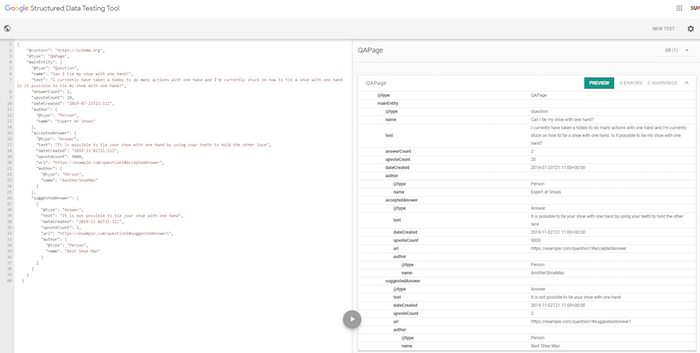
You can also try Google’s Rich Result Tester. This will give you a brief look at how your structured data will look like in the results!
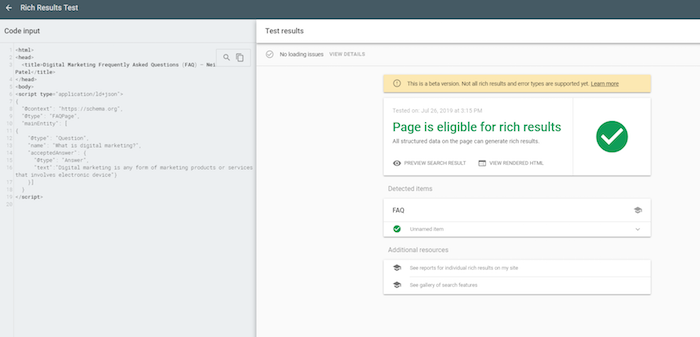
Getting Results With FAQpage Schema in Less Than 30 Minutes
Once you make the changes to any page that you think is a good fit, you’ll want to log into Google Search Console and enter the URL of the page you modified in the top search bar.
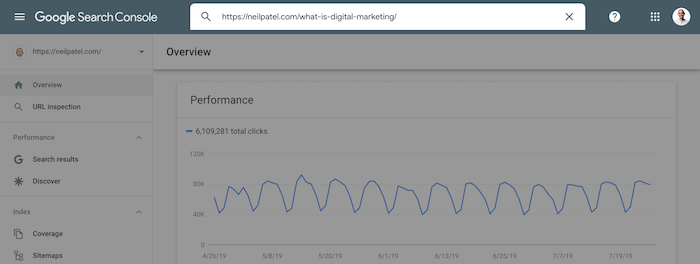
You’ll then want to have Google crawl that page so they can index the results. All you have to do is click “request indexing”.
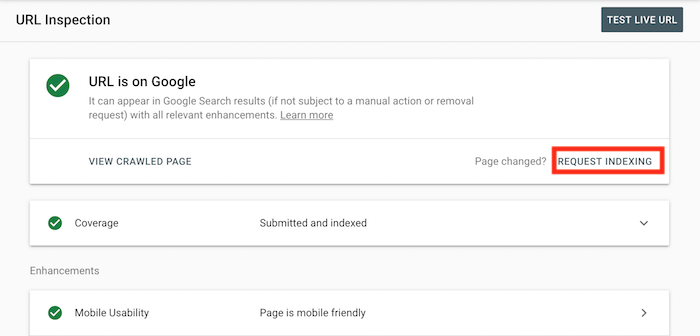
And typically within 10 minutes, you’ll notice it kick in and when you perform a Google search you’ll see your updated listing.
Now the key to making this work is to do this with pages and terms that already rank on page 1. That’s where I’ve seen the biggest improvement.
Will FAQpage Schema Help Me Rank for People Also Ask and Featured Snippets?
Will this help with People Also Ask and Featured Snippets? So far, there has been no correlation between schema markup and People Also Ask or Featured Snippets and you do not need them to be featured in them.
Optimizing your content for this will not hurt you though and can potentially improve your chances to be on here.
Google has been testing out how they can show these types of Q&A, FAQ, and How-To results and looking at structured data to help understand them.
It’s better to be early to the game and help Google understand your pages, as well as possibly participating in any of Google’s experiments.
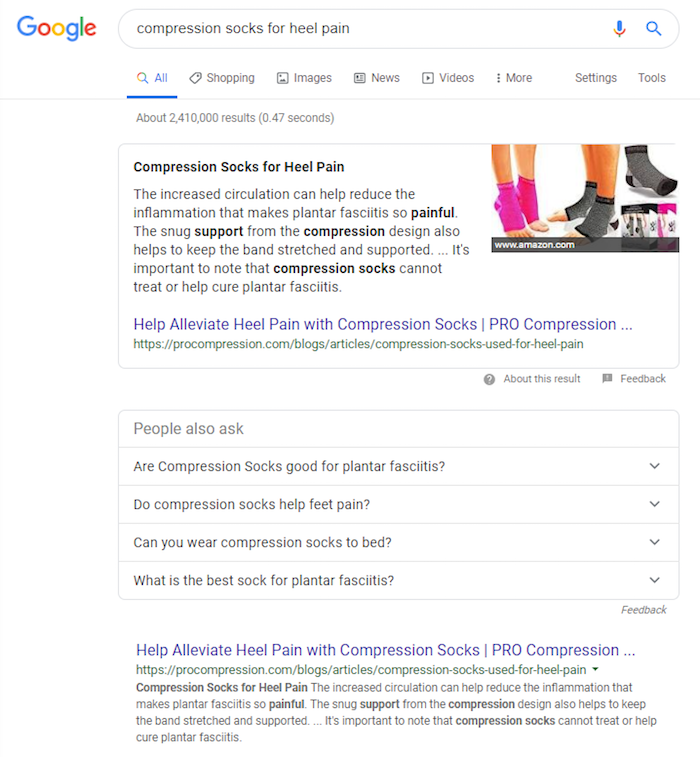
Will FAQpage Schema Help Me Rank for Voice Search?
With more and more people using mobile devices to find answers to questions, this is a very relevant question!
Especially considering that over half of the searches on Google will be from voice search in the near future.
Questions from voice search get most of their answers from featured snippets.
And adding structured data on your website increases the chances of getting you into featured snippets, which increases the chance of you getting featured on voice search.
I also suggest checking out these tips on voice search SEO for more strategies for ranking for voice search.
Conclusion
This simple hack can potentially increase the visibility of your brand and help improve the authority of your website. It’s a simple solution that can take a single day to implement across your main question, product, or FAQ page.
I’ve been using it heavily for the last week or so and as long as I pick keywords that I already rank on page 1 for, I am seeing great results.
And as I mentioned above, when my team analyzed 10,000 sites we only found 17 to be using QA and FAQpage schema. In other words, less than 1% of the sites are using this, which means you if you take advantage now, you’ll have the leg up on your competition.
So what do you think about FAQpage schema tactic? Are you going to use it?
The post How to Improve Your SEO Using FAQpage Schema appeared first on Neil Patel.
How to Use AI SEO to Improve Your Website

The internet has become the go-to source for everything from trivia about celebrities to fixing our kitchen sinks. But AI SEO may be changing the way marketers help their sites rank high on search engine results pages (SERPs).
Failure to rank may result in your business missing out on valuable search traffic. Which means far less revenue for your business.
For a long time, you could get by with basic SEO strategies.
But not anymore.
With artificial intelligence (AI) taking over the world, you need to up your game.
What does that mean for your SEO strategy?
What is AI?
Artificial intelligence (AI) is an umbrella term that covers several different technologies, including machine learning (ML), computer vision, natural language processing (NLP), deep learning, and other, still emerging technologies.
What’s the point of AI?
AI has one principal goal – to perform (often laborious and mundane) cognitive tasks better and faster than humans. It is a technology designed to make our work and life easier.
In business, AI has already proven to be effective in increasing revenue.
In sales and marketing, 30% of AI adopters cited a 6-10% increase in revenue after implementing the technology.
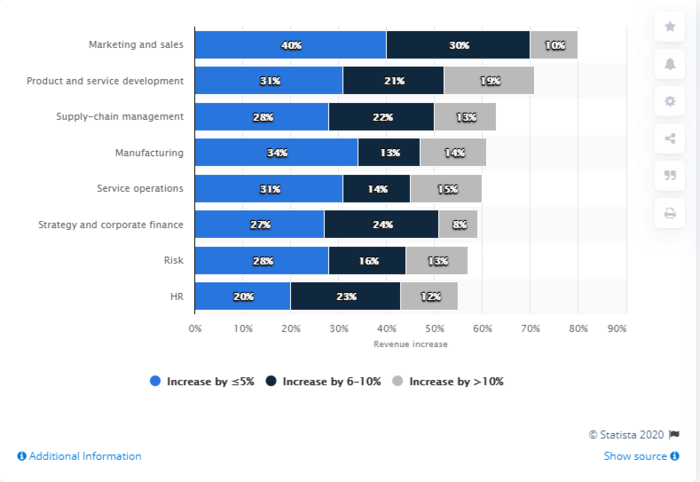
These are pretty impressive results.
And yes, AI can also be beneficial to your SEO.
But, will AI replace SEO?
Emphatically – no!
Let’s talk about how AI is impacting SEO and why it won’t be taking over.
What is AI SEO?
AI has become a core component of major search engine algorithms, including Google’s Rankbrain and BERT.
This factor means if you understand AI and how it impacts search engines, you can boost your SEO using AI.
But that’s not all.
AI is also an excellent tool for data analysis, which is a significant part of designing an effective SEO strategy.
From helping you spot trending topics to discovering content gaps, you can do tasks faster and more efficiently with AI-powered SEO software.
AI and SEO are a match made in digital heaven.
Why is AI SEO Important?
Although both AI and SEO are complex disciplines, used together, they make it easier for you to boost your website’s rankings.
One thing to keep in mind about search engines is they always put the user first. They aim to deliver content that’s as relevant as possible.
Because of this, SEO is not just about keywords anymore. It’s about:
- Concepts: What is the idea behind the searchers’ query?
- Context: What is the intent behind the searchers’ query?
- Customer satisfaction: What are the most relevant answers to the user’s query?
So, keyword stuffing doesn’t work anymore (and hasn’t since Hummingbird). For your content to rank, you need a great link building strategy and to optimize for AI-powered search engines.
Today (and in the future), one of the main factors that impact ranking is user experience. And AI is one of the best ways to provide website visitors with a positive experience.
Let’s quickly look at six ways it can help boost your SEO.
AI SEO: 6 Ways to Use AI to Improve Your Website
Now that you understand what AI is and how AI SEO can impact your site, let’s look at a few ways you can use AI SEO to keep up with modern SEO tactics.
Opportunity Discovery With AI SEO
One of the most important aspects of SEO is discovering hidden ranking opportunities that haven’t been exploited.
That’s one of the areas artificial intelligence SEO is proving to be effective in helping boost your website’s rankings. Powerful AI-powered SEO tools have emerged in the last couple of years, giving you more in-depth insight into:
- Keywords you should be targeting
- Link building opportunities
These and other insights that you can get from AI-powered SEO software are crucial to crafting a content strategy that will exponentially boost your website’s SEO.
With the competition to rank becoming fiercer by the day, you need to find keywords, topic ideas, and other SEO opportunities that aren’t too common.
Find opportunities that your competition is not exploiting, and you’ll have a much better chance at ranking.
Granted, finding these opportunities manually takes a lot of creativity, time, and hard work.
However, with the help of AI-powered SEO software, like BrightEdge, you can uncover golden SEO opportunities faster.
This is one of the main reasons AI must be a part of your SEO strategy.
Content Creation With AI SEO
Discovering content opportunities is only a small part of the battle to dominate the SERPs.
You also have to create content that hits the mark.
This is where AI can help improve your SEO.
How?
Once you’ve used a tool like BrightEdge to find keywords, you can use AI to help you know what kind of content you should create.
Once fed with your target keyword, AI-powered tools scour the web for content created around that keyword. In a few seconds, you’ll find:
- Content gaps to exploit
- Trending topics
- The average number of sections to include
With insights like these, it becomes easier to create content tailored to solve specific problems for your audience, in short, personalized content that satisfies user intent.
Not only that, but AI can help you ensure that the content you create is relevant for each stage of your funnel.
Content creation is no longer just about creating poor quality content that ranks. It’s about creating content that users will find helpful.
And that’s exactly what AI will help you do.
Content Optimization With AI SEO
For a long time, content optimization has been about keywords, internal links, backlinks, and other on-page SEO tactics.
Those things still matter.
But search engines now look at more than just those indicators. Search engines are getting better at figuring out precisely what searcher’s intent is while searching.
How can you optimize your content for user intent?
You guessed it – with the help of AI.
AI SEO tools help you:
- Create topic clusters that answer user questions and rank
- Know the optimum length of content on your given topic
- Use keywords and LSI keywords correctly
With AI, you can optimize your content to meet Google’s E.A.T standards found in their search quality raters, guidelines. You can create content that expertly answers user queries authoritatively. And that’s the kind of content Google loves to serve its users.
But AI doesn’t end at helping optimize content for search engines. AI-powered writing tools like Atomic Reach and Grammarly (among a slew of others) also help ensure your writing makes for a pleasant read.
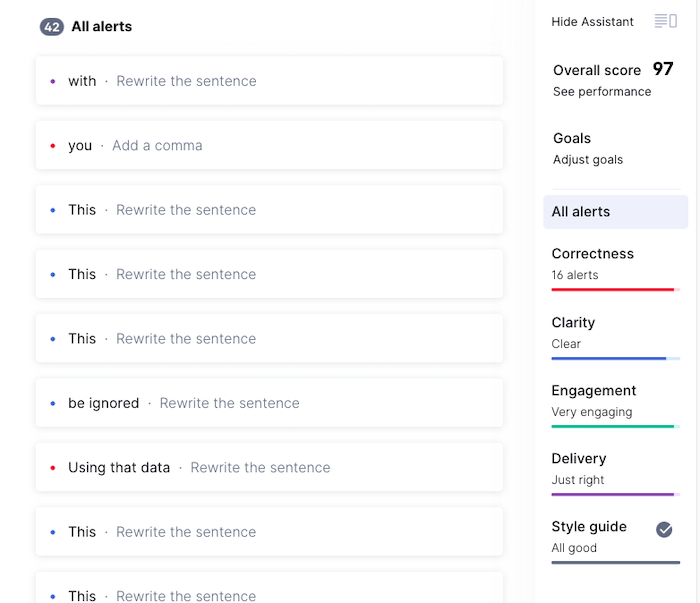
This also helps increase dwell time, another factor that indicates to search engines that your content is useful.
The bottom line is AI can help you create better optimized content that your readers will love and engage with.
Optimizing for Voice Search
One of the fastest evolving areas of search is voice search.
With more people relying on their voice-activated devices to search the internet, voice SEO (VSEO) has become an aspect of SEO you can’t ignore anymore.
Just take a look at how fast the number of voice-activated assistants is rising:

Statista forecasts that the number of voice assistants globally will reach 8.4 billion in the next few years — which is more than the world’s population.
Most voice searches are in the form of questions, so one of the main ways to optimize for VSEO is by answering the questions people are asking.
This is where AI tools come into play.
For example, tools like Frase help you create VSEO optimized content by showing you the questions searchers are asking. You can then create content around these questions.
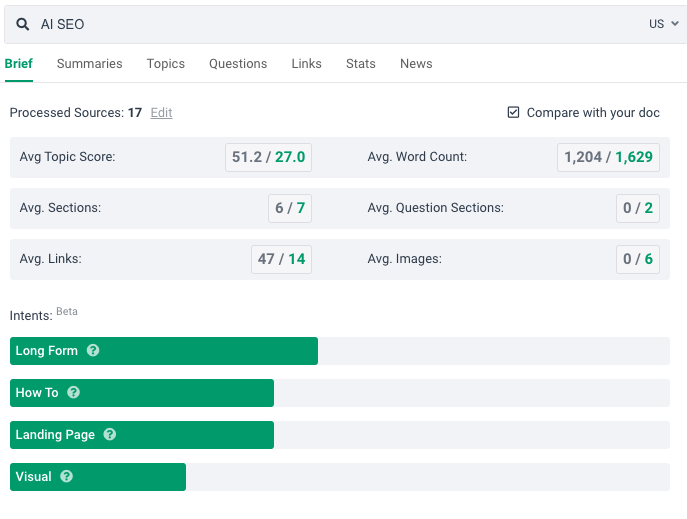
Another aspect of voice search is that it’s conversational. This is where AI principles like NLP come into play.
AI-powered content tools like Grammarly and Hemmingway can help you create more conversational content by recommending tone changes and highlighting hard to read passages.
One thing to note about VSEO is that it is hyper-competitive. That’s because voice assistants only give one answer – the one right at the top of the SERPs.
This means you have to pull out all the stops to ensure you rank well for VSEO.
Scale Your SEO
A significant part of SEO is tedious manual labor that has made it difficult for marketers to achieve results quickly.
AI has changed that.
AI-powered tools have taken a lot of the grunt work out of SEO by gathering data, analyzing it, and translating it into actionable steps,
More than that, however, you’ll find that artificial intelligence SEO software, like Alli AI, can help with your technical SEO as well. For example, it can help you:
- Conduct website audits
- Automatically optimize content
- Fix duplicate content issues
On the on-page SEO front, AI SEO software can help you scale your content creation by analyzing top-performing content. The software can then help you create content strategies and briefs for optimized content.
As a result, you can quickly scale your SEO efforts — without overworking your team.
AI can take over the laborious, mundane, and time-consuming (and sometimes soul-sucking) aspects of SEO. This will free up your team to do other things that need human attention.
User Experience
Remember – Google’s (and other search engines) primary focus is the user.
This means user experience (UX) is a crucial element of SEO.
That’s probably why, in a rare announcement, Google let people know that page experience will be a significant ranking factor starting from the year 2021.
But what is page experience?
According to Google, page experience is a set of signals that measure a user’s satisfaction (or lack of it) when interacting with a web page. This goes beyond the page’s informational value.
It takes into account the overall UX the page provides.
Of course, pages with negative user experience won’t rank and those that offer users a positive user experience.
Where does AI come into play here?
With search engines thinking more like real human users, they can determine whether your page will provide users a positive UX or not.
This means when a user inputs a search query, search engines want to make sure they serve up:
- Relevant and authoritative content
- Pages with proper structure
- Pages with easy navigation
- Pages that load fast
- Mobile-friendly websites
If users can enjoy a personalized experience on your website, this will increase dwell time and encourage sharing your content. Both are signals to search engines that your content is worth ranking higher on SERPs.
Today’s AI-powered SEO tools, like Market Brew, can mimic search engines and give recommendations on what you can do to improve your website’s UX.
As a result, you don’t have to guess whether the SEO gods will smile on your website with favor or not. You can know what pleases them (to a greater degree) and implement that on your website.
Conclusion
Ready or not, the future of SEO is here.
And it’s just two words – artificial intelligence.
By marrying these two disciplines, you can create a robust SEO strategy that’s bound to get you noticed. More than that, it will help you build a loyal audience.
Of course, for every business, that translates to a healthier bottom line.
Have you embraced the power of AI SEO yet?
The post How to Use AI SEO to Improve Your Website appeared first on Neil Patel.
How to Leverage Storytelling to Increase Your Conversions

In the not so distant past, I embarked on a journey to grow NeilPatel.com to 100,000 blog readers. At the end of every month, I shared my traffic stats and the changes I’d made. That storytelling strategy went on to help my blog reach over 100,000 views a month — in only about eight months.
As marketers, we use storytelling to help make our ideas stick. We create stories to help prospects understand our products, use company stories to build trust and transparency with consumers, and include stories in sales pitches to help persuade.
Why does it work?
Competition in native advertising and social media marketing is fierce. And, the rate at which great content is being produced and published on the web and across the media channels is expanding. Our readership is drowning.
Most people scan web content, looking for something that stands out. If they don’t find it, they’ll leave.
Visual stories and corporate storytelling can connect the dots and get people to ACTUALLY read your great content and take action. This is the essence of successful media marketing.
If you want to increase your potential customer conversions, then start captivating your target market by making emotional connections through storytelling.
Storytelling is like a vitamin. When it gets into your readers, it permeates their whole being and fights every objection that might otherwise stop them from becoming loyal customers.
In short, it’s an amazing secret weapon when it comes to your marketing strategy.
In this article, I’ll explain the five simple steps you can improve your potential customer conversion rate by combining storytelling and data.
The breakdown of what you’ll learn is:
- What Storytelling Is
- The Elements of Storytelling
- How to Use Storytelling to Increase Conversions
- Build Authority Through Storytelling
- Storytelling Success Stories
Step #1: What is Storytelling?
Storytelling is the art of communicating your idea, message or event, by creatively weaving words, images, and sounds into a narrative. Visual stories, written stories, and verbal stories – this is the content we love.
When you tell a true story, your message is perceived as authentic. In the same way that live events get more retweets than general tweets on social media channels, your content will impact the lives of your target market, and improve your credibility.

Why should you use corporate storytelling in content marketing? We breathe visual stories. Even in the Stone Age, humans understood how to tell stories that evoked interest and made that emotional connection.
And, it’s one of the most effective ways to engage and persuade your audience.

Humans are born storytellers and adore visual communication. Storytelling gives life or meaning to a scenario and makes that emotional connection, provoking feelings of ecstasy, sorrow, or peace, and captivating your audience. This is exactly what you need when it comes to your digital marketing strategy.
It is little wonder that posts with visual stories and visual communication generate more Facebook and media channel shares than any other content type.
As it turns out, visual stories and communication (e.g., infographics, videos, memes, screenshots) get widely shared on major social media channels.

Your potential customers aren’t looking for another sales pitch or a proposal that sounds too good to be true. They’ve heard enough of those.
For example, when you write, use relevant images and great visual stories that pique people’s interest.
Or, if you’re recording a podcast, you could use emotion-triggering music and sounds. For video creation, you can use words, images, visual stories, and sounds at the same time.
A study conducted by Forrester Research found that 88% of executives and organizational decision-makers long to have conversations, not pushy sales presentations.
With visual stories, you can create and promote infographics, which have collectively generated over 2,500,000 million visitors and 41,142 backlinks for me, over a two-year span.
I usually publish new infographics every Friday, and the results have been amazing.

You can also create visual stories and content and submit it to authoritative media sites and platforms, such as Slideshare, Vimeo, and Animoto. This helps you gain a new target market and potential customers for your business.

Corporate Storytelling in Persuasion
Persuasion is the master key that will unlock your conversion vault with your potential customers. Robert Mckee was right when he said that “Storytelling with persuasion trumps statistics.”
Marketing is for people, and people are emotional beings.
Our brains are wired to respond to emotional connections and triggers. Storytelling is the most natural source of those triggers.

When you understand how to persuade others, you’ll no longer struggle to get more traffic. Instead, you’ll focus on improving conversions, because that’s what matters.
So, how do stories persuade a targeted group of readers or potential customers to take action? That’s the goal of setting up a content marketing strategy and writing in-depth content.
Moment of truth: What potential customers perceive to be true will ultimately guide their actions and decision-making processes. Consumer perceptions may or may not be accurate, but they’ll live by them, nevertheless.
When people visit your website or your media sites, what truth do you instill in them? Do you give visitors the hard sell, when they’re still trying to get to know you?
Instead of starting with “once upon a time,” or some variation of it, weave your story into your content. Stories can even appear on your headline, introduction, and, most importantly, on your landing page.
Add experiences, case studies, research studies, and significant results that you’ve helped your customers achieve. These are the foundation of your story.
I’ve used storytelling in the past to engage my readers, as well. For example, I shared a story on how spending $162,301.42 on clothes made me $692,500.
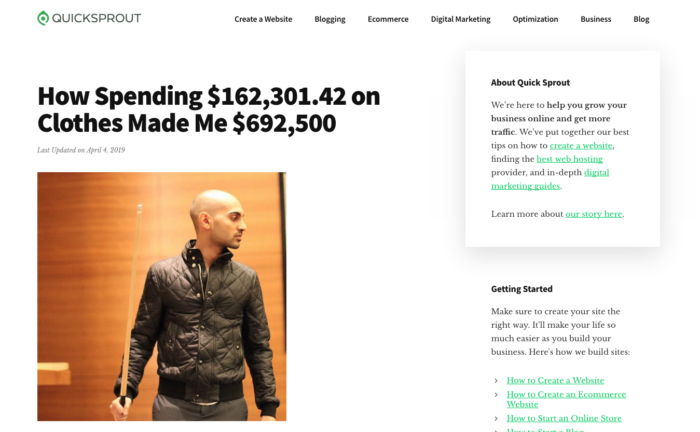
Personality: The Norwegian author Rune Belsvik once said that the concept of story was “one of the first things that came to the world.”
Our personality is born out of stories. We’re created to share and listen to stories, to fall in love with visual stories. So, storytelling is a natural tool to help grow your audience and increase your conversions.
In the same way, storytelling gives your content new flavor and amplify its benefits, because it’s coming from a “personality” – a set of characteristics that makes you special and appealing to others.
In the beginning of your content, open strong, and establish your story. In the middle, build interest in the message.
Highlight the benefits of the topic and close with a call-to-action that’s persuasive, not pushy.
David Siteman Garland, founder of The Rise To The Top, uses this strategy to write his copy. He starts out his story on a strong note, gradually evokes interest by showing the results in the middle, then calls his readers to action at the end.
Here’s the beginning:
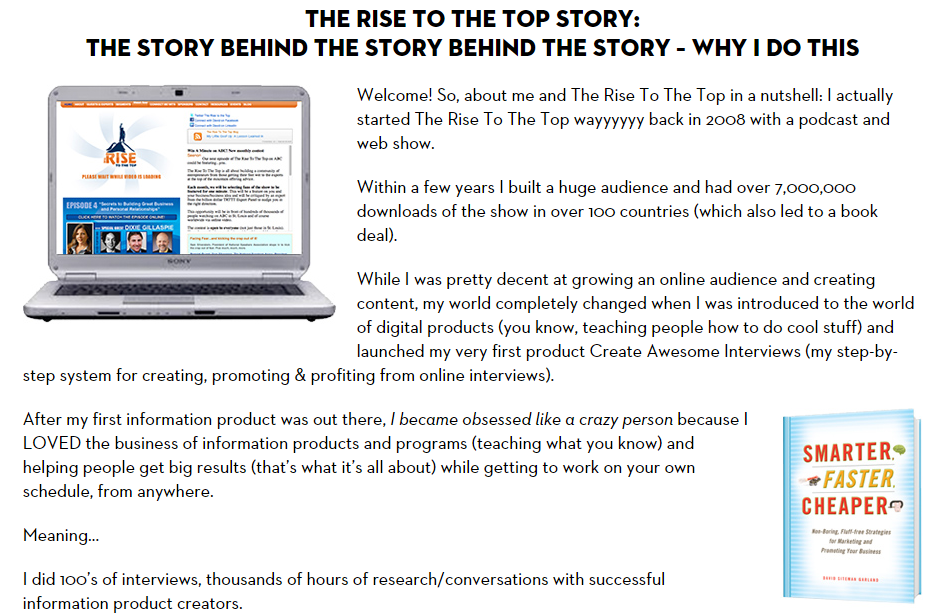
Here’s the middle of his copy, where David builds interest through success stories:

And finally, the call-to-action at the end:

Note: Established bloggers and internet marketers who have built solid businesses use content segmentation to improve their conversion rate. And, because they’re creative at storytelling, they’re able to experience greater levels of success.
The sooner you master the art of storytelling, the better for your brand and online business. Social media is redefining storytelling in a significant way. Know your audience and be authentic in your written and visual stories.
You’ve already gone through a lot in life and have endless stories to share.
I don’t believe that you should make up stories; instead, you should tap into the wealth of stories from family, friends, customers, entrepreneurs, and brands.
Then, align those stories to the audience you’ve come to know like the back of your hand.
Step #2: Learn the Elements of Storytelling
When you’re telling or sharing a story with your potential customers, you want to achieve a specific outcome.
You want enough general knowledge to take your content marketing efforts to the next level. Then, make sure to include the following elements of storytelling.
A Defined Target Audience
Have you defined your audience yet? Before you can successfully tell a story, there must be a qualified audience to enjoy it. Most people get it backwards, if they do it at all.
But, you have to define your target audience first, because they’ll, in turn, define your product both in and out of social media marketing.
As time goes by and you build relationships and engage with your potential customers and target audience, they’ll send you great feedback that will help define and improve your product.
So, how do you define your target audience and your potential customers clearly? There are several ways to go about it, but I’ve personally found that demographics are the first step.
If I can truly understand who my target audience is and where they’re browsing my site from, I can align my content and tell a better story.
Your audience demographic is just a market segment, but it will give you a great understanding of their complete persona or profile.
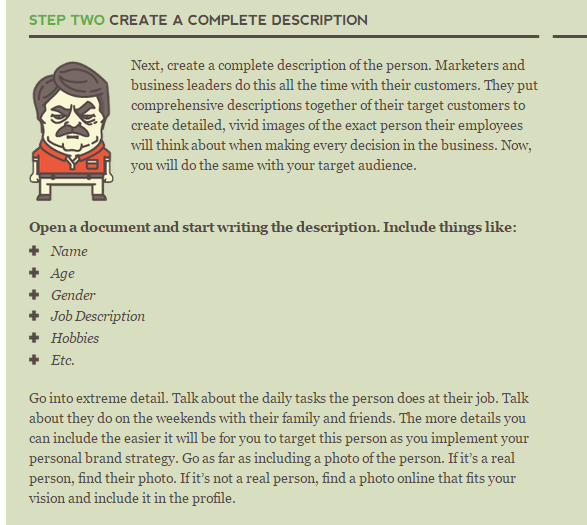
Here are the four simple steps to define your audience, based on demographics:
Go to Alexa.com. Type in your site URL (e.g., lewishowes.com) and click “Go.”
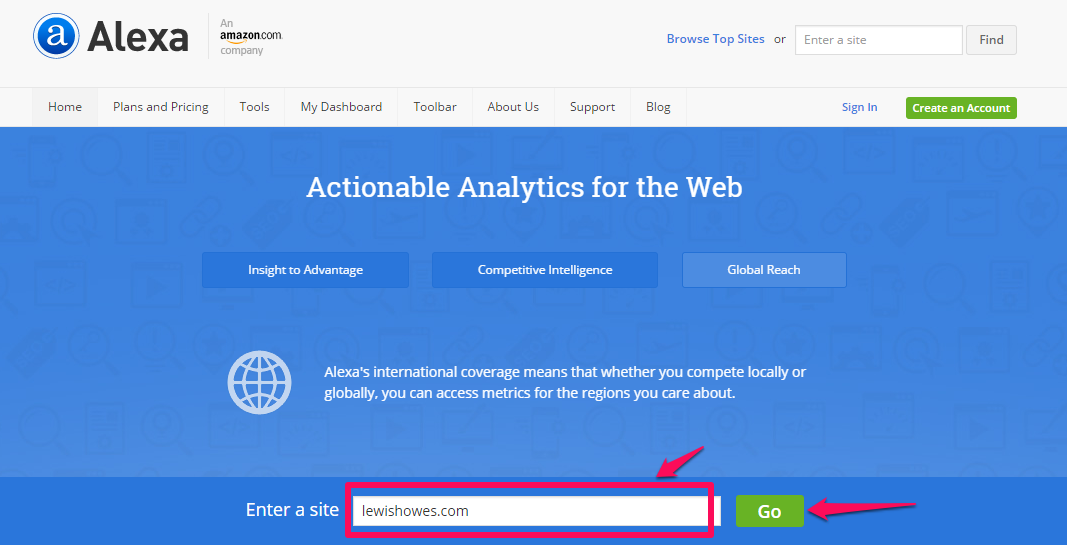
To find your results, scroll down the Alexa result page and you’ll find this:
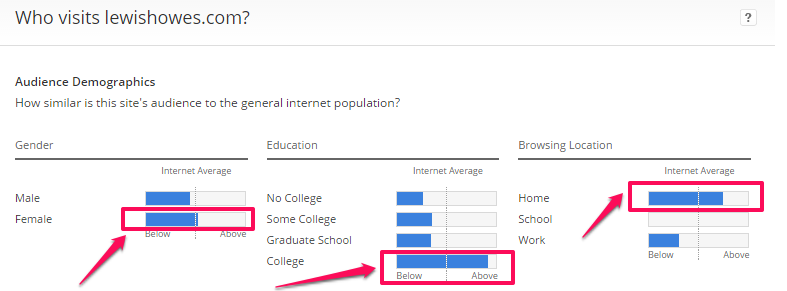
From the screenshot above, you’ll notice that LewisHowes.com visitors are mostly female, are college graduates, and browse the site from home.
If I were Lewis, now that I know my audience is predominantly female, I would align my content with storytelling nuggets that will appeal to both males and females, but weighted towards the females. I might not do anything further on the education aspect, because college graduates can effectively read and live their dream lifestyle.
But, since the majority of this target audience browses from home, I’d also try to give them worksheets or actionable tips that they can implement right away since they would have no boss around to audit what they are doing.
Armed with your audience demographics, you’ll want to dig deeper. Knowing your audience’s interests is a critical step in unearthing their biggest challenges and using storytelling to solve their problems.
The suggestions below paint a clearer picture of how you can best utilize each social media channel:
- If you deal in fast-moving consumer goods (i.e., not luxury goods), Facebook is your ideal social media channel for attracting an audience, because the users are mostly young people.
- Twitter is a microblogging platform for news-like updates. Use the social media channel Twitter to keep your target audience abreast of what’s happening with your site, business or community. It’s not for selling.
- Besides clothing and decorative arts, Pinterest favors food and drink-related products. Family and relationship-related products also tend to receive more likes and repins.
- Clothing, accessories and entertainment-related products do extremely well on Instagram because the users are primarily female.
Finally, LinkedIn is the platform of choice for business-related communications. So, if you’re looking to acquire business-minded customers, LinkedIn will out-perform Twitter and Instagram, by a long shot.

Measurable Goals
The second most important element of storytelling is a measurable goal.
Anybody can set a goal, but how many people can effectively measure it?
Smart marketers want to track their progress.
When you set a goal that you can’t measure, you’ll miss out on the potential of expansion. For example, you won’t know what other factors are required, when you set a bigger goal.
Here are some tips for setting measurable goals:
Start small: I believe in thinking big, but you should also keep your goals realistic. When you start on a smaller note, you’ll certainly hit the target and know exactly where you’re going.

“10,000 visitors in a month” isn’t realistic in the beginning.
But, you can set a smaller, specific, and measurable goal, such as “Generate 1000 blog visitors per week, by targeting 25 long-tail keywords and spending an hour every day at relationship-building on discussion boards and social media platforms.”
This latter goal is measurable because you can check your Google Analytics to determine which keyword phrases are performing well in the search engines. You can also track your social media marketing activities and understand the best times to tweet.
You also want to measure your progress when using storytelling to meet marketing goals. Otherwise, you won’t be able to know whether or how your conversion rate is growing.
Set a schedule: For your goals to be measurable, you have to set a schedule. What will you do daily to achieve your goal?
A schedule gets you organized and increases your productivity.

Your schedule should match your deadline and help you focus on the most important tasks.
For example, if you’ve set a measurable goal to generate 1,000 search visitors per week by targeting 25 long-tail search queries, your daily schedule could be:
- Research and select five longer tail key phrases: If I were in the weight loss/fitness niche, I could select these easier-to-target key phrases: how to lose 20 pounds, I want to lose weight, best weight loss exercise that works, top 10 fat loss programs and help me lose weight fast.
- Read books, blogs, watch videos, etc.: I want to learn about the topic as much as I can before writing. There are helpful resources that I can easily access with a quick Google search.
- Write my headlines: This is critical if you want people to click, read, and share your content. Spend 20 minutes to an hour on your headline, because if you don’t nail the headline, you’ll waste a lot of potential. In order to save time on headline writing, find a headline in any industry that catches your attention, then use it as a model to create a better one that’s relevant to your own industry.
- Write the content: First, create an outline for your content, then expand on it to create your content or video.
- Set a deadline: According to Nolan Bushnell, “the ultimate inspiration is the deadline.” Without a deadline, you aren’t inspired to act now to achieve a significant result, because the clock isn’t ticking.

In leveraging storytelling to increase your conversions, every piece of content that you write and every landing page that you create should have a measurable goal with a schedule and a deadline.
Relatable data: The grudge match between storytelling and statistics rages on. But instead of choosing one or the other, why not combine both when creating your content?
I rarely write content without using data to back up my claims. Personal opinions have a limited ability to engender trust in your target audience. But, if you can prove what you say with statistics, then you win loyal customers.
Take a look at my recent post, to see how I positioned myself as an authority, by referencing something that Google said:
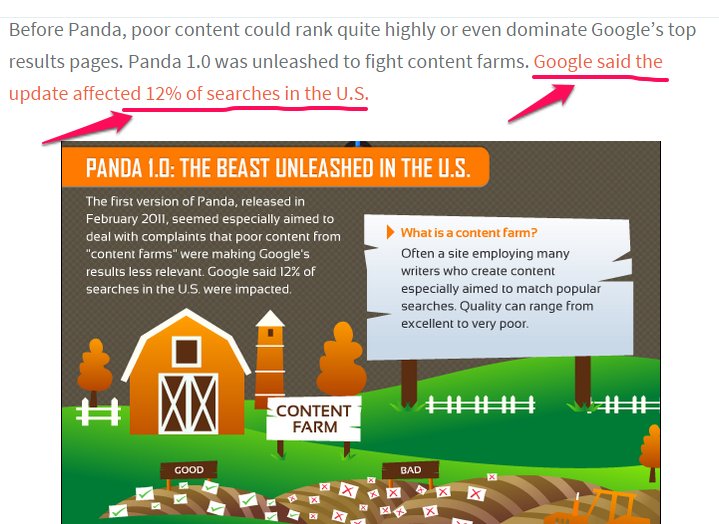
Sharing a story on how you went from being broke to being a millionaire may not do much for your customers unless you use data to prove it.
If there’s no data or case study relating to the story that you’re sharing, you can share your own data.
Go ahead and create charts and make it plain that this is what you found after a series of experiments.
Persuasion
The fourth element of effective storytelling is persuasion. You can’t influence people if you can’t persuade them.
In his bestselling book, Influence, Dr. Robert B. Cialdini noted that reciprocity, commitment, social proof, authority, liking, and scarcity are the strongest factors in the psychology of persuasion.
The focal point is this: these six factors move people to change behavior, follow the course that you’ve set, subscribe to your email list, and buy your product, even if they don’t necessarily need it right now.
Let’s see an example of how social proof can increase sales.
Cialdini defined social proof as “the art of doing something because you see others who do the same thing.” You simply follow the crowd.
Here’s an example of how social proof increases conversion: Modcloth is a clothing commerce site.
It’s a great community, where shoppers vote on the styles that they believe the site should sell more of in the future. Such styles have a “Top-Rated” badge.

The evidence of this unique form of social proof is that products with this badge sell twice as well as products without it.
Here are other examples of top brands using social proof:
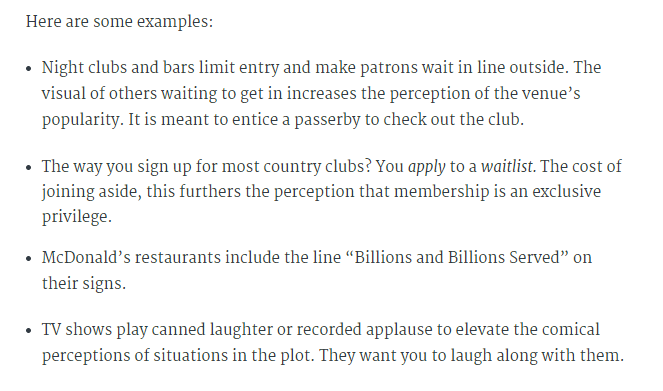
To learn how the other five principles of persuasion increase conversions, see Peep Laja’s resourceful post, how to use Cialdini’s 6 principles of persuasion to boost conversions.
Use Storytelling to Increase Conversions
I’m amazed at how Huggies used storytelling to increase their conversion rate. Huggies and Ogilvy had a definite and measurable goal – to connect with and deepen a relationship with expectant moms. They wanted to build engagement even before the baby is born.
To accomplish that goal, Ogilvy decided to get expectant moms involved. Through their campaign, “Delivery Hugs,” they created a powerful video that triggered a strong emotional response from people – especially mothers and moms-to-be
The video was viewed by millions of people. When those people shared the video and the story behind it, people were moved to tears.
Here are actionable ways to increase conversions through storytelling:
Develop a Content Strategy
Your content strategy simply refers to a structured plan by which you create content, promote it, test your campaigns, and track your progress.
The content structure gives you ample opportunity to boost the effectiveness of your content strategy.
And, you can easily achieve that by leveraging social media. Taking inventory of the leads that you acquire, the sales that you get, and the underlying trends in your industry is critical, when you’re developing a content strategy.
Leverage a Story People Already Know
You don’t have to reinvent the wheel. You could leverage other people’s stories to create a powerful, high-quality, evergreen piece of content. Stories are the secret recipe for other people’s success.
In All Marketers Tell Stories, Seth Godin poses three essential questions to every marketer:
- Do you have a story?
- When the right people hear the story, will they believe it?
- Is the story true?
The harsh reality is that if your story is great, but you can’t tell it well, no one will believe you. All marketers tell stories, but only those who have mastered the art of storytelling catch our attention.
Millions of other people’s stories are available online. All you have to do is find one or more, create tailored content around the stories and reference original content.
This has nothing to do with duplicate content, plagiarism, or content curation. You’ll be creating unique content based on other people’s stories.

For example, I’ll be creating an in-depth article on how Shopify tripled their sales. I’ll give all due credit and appreciation to Shopify, but the content will increase my search traffic and probably bring in clients.
You can read people’s stories on blogs or by listening to their presentations, reading their books, or engaging them in one-on-one conversations.
There should be a beginning, a narrative to show what happened and the lessons learned, then a conclusion that shows exactly how the same story can change the reader’s life for the better.
Lead With Dialogue
Storytelling that focuses on two-way communication will yield faster growth.
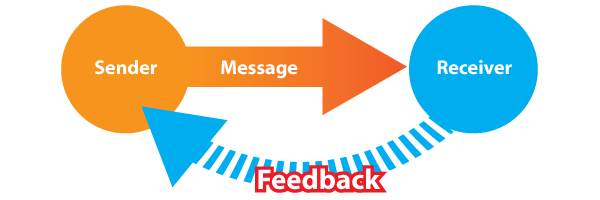
Seth Godin says that “fast growth comes from overwhelming the smallest possible audience with a product or service that so delights them that they insist that their friends and colleagues use it.”
I have to agree because when your product isn’t worth talking about, no amount of marketing will help. Both the content and the product have to be highly useful first, then everything else follows. It’s all about getting feedback from your target audience.
Vanessa Van Edwards, the founder of The Science of Things, uses dialogue in storytelling.

Vanessa understands that when her audience gives honest feedback by taking a quiz, she can use the data pertaining to body language from 5,000 readers and create high-quality information products for them.

She even goes the extra mile by accepting research studies from readers. This single act gives the readers a sense of belonging. They’ll look forward to getting Vanessa’s newsletters and participate in anything related to body language because they’re a part of the community.
QuickSprout provides an interactive tool, as well. It literally talks to you, when you plug your URL into the search box.
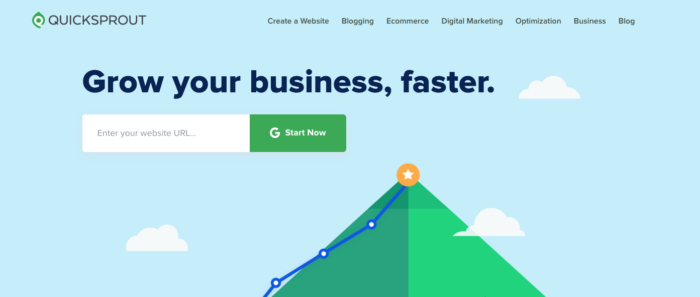
Sonia Simone tells thought-provoking stories by leading with dialogue. A few years ago, she posted a simple question that got my neurons fired up:

If you already have an audience via social media networks, an email list, or a mastermind group, you can get feedback from them by sending questionnaires through SurveyMonkey.
Focus on Emotions
Our brains respond to stories more than anything else. Robert Plutchik’s “wheel of emotions” reveals some of the underlying emotions that influence your customers, which – when leveraged – can boost your conversions.

Lisa Feldman noted, in her book The Science of Emotion, that for the most part, people have little control over their emotions. Often, they’re automatic responses to our experiences. What we like or hate and what we perceive as pain or pleasure are just two kinds of emotional triggers, among many.
Happiness is one emotion that makes us want to share. Psychoanalyst Donald Winnicott noted that our response to our mom’s smile with a smile of our own is usually the first emotional response we make in life.
When your content drives people to a state of happiness or joy, they will automatically respond to your offers, feel obliged to share your content, and will stop at nothing to tell others about you.

This is because happiness is hard-wired into the human brain. When experienced, it’s found in the left prefrontal cortex of the brain.
It literally functions from there. But, it may remain dormant until something – such as a story – triggers it.
A baby’s social smile further tells us that when happiness is shared, it ultimately increases and creates an atmosphere that encourages more happiness. What you share will actually come back to you multiplied.
Speak to your customer’s mind, but appeal to both logic and emotions.
Measure the Impact of Your Story
If you’ve ever wondered why most brands get media publicity with ease, while others stay on the sidelines, it’s because they were able to use storytelling to its full potential. You have to measure your success – because it’s critical to making smarter content marketing decisions.

Planning, execution, and consistent learning are key factors that will help you increase your conversions. But, you have to measure the impact of your brand story.
Measuring social media activities is easy. But, measuring the impact of storytelling is a little more difficult, because it has so much to do with emotional communication.
Step #4: Build Authority Through Storytelling
Social networks influence nearly 50% of all IT decision makers. Truly, the world as we know it is changing.
It was all about mass media in the past. But today, social media is taking over. We’re living in the age of authority. Traditional media might still be popular, but it lacks effectiveness because it’s a one-way communication channel.
Social media is different. When you send a tweet, you can get a retweet or comment from a follower and, over time, build trust.
When it comes to building authority through storytelling, you need a level of influence in your business, family, society, and spheres of contact, before people can trust you.
What you believe in can be amplified if you’re able to convince a select group of people.
So, how do you start building your own authority? Here’s a simple three-step game plan that’s proven to work:
- Affirm that you’re an authority in your industry
- Focus on your creative voice
- Share stories that pull people instead of pushing them
Affirm You’re an Authority in Your Industry
There is power in affirmations. When you affirm to yourself what you want to happen in your life or business, you can see it come to pass when coupled with smart action. Of course, you can’t just fold your arms and expect miracles to happen.
But, if you think you’re not qualified, competent, or decisive enough to influence people, it’ll show in your conversation.
Affirmations are positive statements that describe or convey a strong desire to achieve a specific goal or state of being, which is then repeated consistently until it’s imprinted on the subconscious mind.
For example, you can wake up every day and affirm, “Today will be an awesome day.” And, it most likely will be for YOU (though maybe not for EVERYONE).

Affirmations work because when you continually repeat a statement verbally, it influences your thoughts and actions.
For example, repeating to yourself, “I’m increasing my sales this month,” plants the thought into your subconscious mind, which then begins to imagine the amount of money that you’ll make.
Repeat to yourself, “I’m telling better stories” and again, your mind will call you to order and nudge you to search out a powerful story for your next blog post or product.
In his bestselling book, You Are A Writer (So Start Acting Like One), Jeff Goins said that “becoming a writer starts with a simple, but important belief: you’re a writer and you’ve got to start writing.”

And today, Jeff Goins runs a successful online self-publishing business. Even if no one ever believed in him, he affirmed it to himself repeatedly and it became so.
Jeff’s latest book, The Art of Work: A Proven Path to Discovering What You Were Meant to Do, is also full of affirmations. Goins’ work has been endorsed by the biggest names in the internet marketing world.
If you want to truly become good at something, you first have to believe in it.
Focus on Your Creative Voice
Storytelling is an art and therefore requires uniqueness and creativity. Your creative voice is what sets you apart from the crowd, just like your Unique Selling Point.
A post on Oprah’s website suggests that you find a quiet place to meditate and assimilate all of the information that you’ve accessed during the day.
When everything else fails, your creative voice will give your story a rhythm. It’ll alleviate boredom and take people on a journey of experience.
I love how the creative Gary Vaynerchuk builds authority through social media and blogging. He even advocates growing your brand by leveraging someone else’s.
In summary, here are a few ways to discover your creative voice and focus on it:
- Heed Oprah’s advice. Set aside quiet time to meditate.
- Learn from other people. Position your brand to benefit from their own.
- Know your target audience inside and out.
- Use storytelling to express your worldview, not to impress anybody.
Share Stories That Pull People, Instead of Pushing Them
Storytelling is meant to pull people in, not push or repel them. It’s about helping people become better.
Your story shouldn’t just be about you. Instead, it should relate to your audience and customers. It should pull them in and retain them.
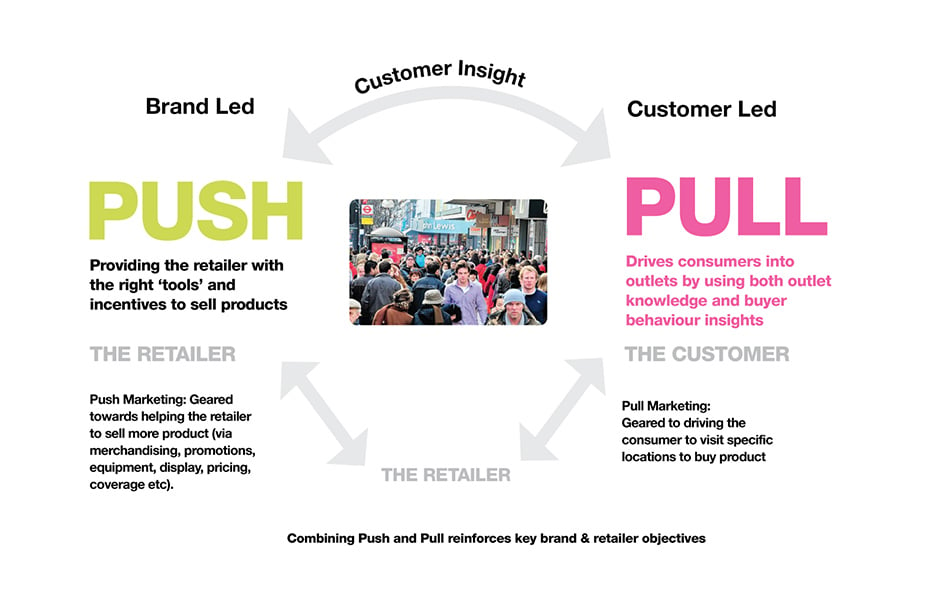
When using stories to capture an audience, keep in mind that they may not necessarily want to know every detail – the outcome is what counts. Many people don’t want to know how painful giving birth to a child is, but we all want to hear the cry of a baby, right?
Seth Godin has authored over 20 books. His style of writing, which incorporates storytelling, pulls people in. Godin has many brand associates, who regularly refer clients to him. Take a look at this opening in a post:
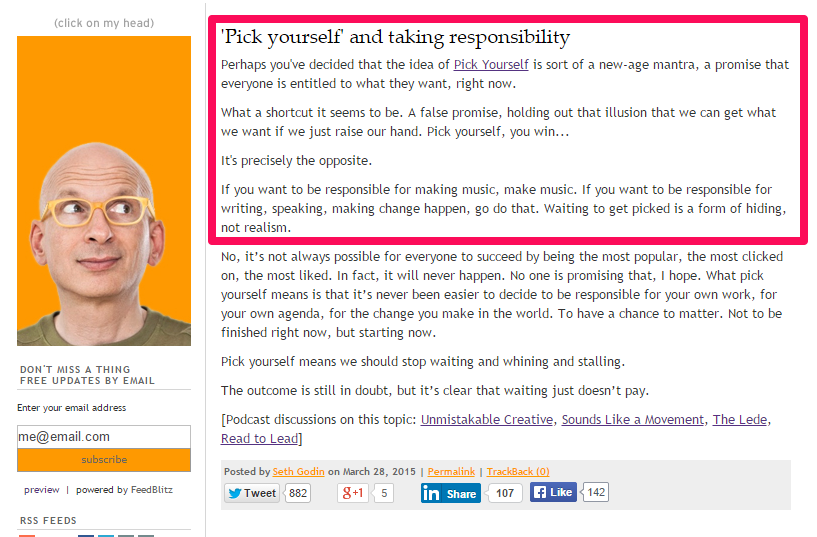
As a content creator, writer, and business owner, you’re in this world to make a difference.
It’s not all about the money that you’ll make, but the joy of seeing your target audience and customers improve their lives, meet their goals, and smile again.
Step #5: Learn from Storytelling Success Stories
I’ve shared several success stories of how brand distinguished their products, customer service, and relationships with customers, all by telling real stories.
But, there are more storytelling success stories left to tell.
ITV’s Storytelling Launch
ITV had plans to create a new multi-screen ad format, which could be synced into other platforms. Their audience was mostly composed of smartphone and tablet users.

When ITV combined this innovation with visual storytelling, they were able to merge the benefits of broadcast TV advertising with modern tablets and smartphones.

During the X-Factor finale last year, the ad format was launched and it resulted in over 1,300,650 page views, with an average click-through rate of 8.75%
Jon Morrow
Jon Morrow is one of the bloggers that I deeply respect.

He once shared a powerful guest post on Problogger, telling the story of how he was hit by a car in April 2006.
His leg was broken in 14 places. For the next three months, he endured significant pain and misery.
Then, he got brave and quit his job. He sold everything he owned and stopped paying most of the usual bills. The story got even more interesting, when he recounted how he moved to paradise to get paid to change the world.
In that post, Jon persuaded readers so strongly that it generated over 72,000 visitors.
Today, Jon runs a very profitable online business and his flagship blog, Boost Blog Traffic, gets over 100,000 monthly visitors. In fact, he earns over $100,000 per month.
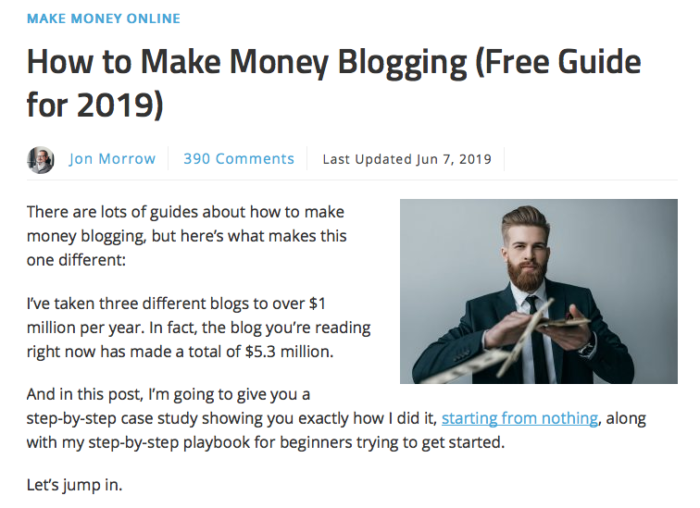
Dallas Morning News
Dallas Morning News, a regional media company in the U.S., wanted to expand its reach through social media. They understood that traditional media is fast becoming tiring for viewers and fans unless it’s integrated into their social lifestyle.

Using Hootsuite, they were able to control their social activities from one portal, streamlining their endeavors.
They empowered and persuaded their team to cultivate the habit of sharing news and updates on social media platforms. This strategy increased the company’s engagement with a growing local readership.
And, they succeeded. Here’s the result of their social media integration:

Conclusion
The human brain is wired to remember memorable and visual stories.
The sooner you start using storytelling in your content creation and marketing, the easier you’ll find it to increase your conversions.
There is no shortcut to improving your ROI as a content marketer and blogger. You have to consistently feed Google and your target audience with fresh, high-quality content.
As you do that, you’ll get more organic traffic and improve your long-tail keyword rankings significantly.
Have you leveraged storytelling to increase your conversions? What is your experience and how do you respond to other people’s stories?
The post How to Leverage Storytelling to Increase Your Conversions appeared first on Neil Patel.
source https://neilpatel.com/blog/how-to-leverage-storytelling-to-increase-your-conversions/
How to Leverage Storytelling to Increase Your Conversions

In the not so distant past, I embarked on a journey to grow NeilPatel.com to 100,000 blog readers. At the end of every month, I shared my traffic stats and the changes I’d made. That storytelling strategy went on to help my blog reach over 100,000 views a month — in only about eight months.
As marketers, we use storytelling to help make our ideas stick. We create stories to help prospects understand our products, use company stories to build trust and transparency with consumers, and include stories in sales pitches to help persuade.
Why does it work?
Competition in native advertising and social media marketing is fierce. And, the rate at which great content is being produced and published on the web and across the media channels is expanding. Our readership is drowning.
Most people scan web content, looking for something that stands out. If they don’t find it, they’ll leave.
Visual stories and corporate storytelling can connect the dots and get people to ACTUALLY read your great content and take action. This is the essence of successful media marketing.
If you want to increase your potential customer conversions, then start captivating your target market by making emotional connections through storytelling.
Storytelling is like a vitamin. When it gets into your readers, it permeates their whole being and fights every objection that might otherwise stop them from becoming loyal customers.
In short, it’s an amazing secret weapon when it comes to your marketing strategy.
In this article, I’ll explain the five simple steps you can improve your potential customer conversion rate by combining storytelling and data.
The breakdown of what you’ll learn is:
- What Storytelling Is
- The Elements of Storytelling
- How to Use Storytelling to Increase Conversions
- Build Authority Through Storytelling
- Storytelling Success Stories
Step #1: What is Storytelling?
Storytelling is the art of communicating your idea, message or event, by creatively weaving words, images, and sounds into a narrative. Visual stories, written stories, and verbal stories – this is the content we love.
When you tell a true story, your message is perceived as authentic. In the same way that live events get more retweets than general tweets on social media channels, your content will impact the lives of your target market, and improve your credibility.

Why should you use corporate storytelling in content marketing? We breathe visual stories. Even in the Stone Age, humans understood how to tell stories that evoked interest and made that emotional connection.
And, it’s one of the most effective ways to engage and persuade your audience.

Humans are born storytellers and adore visual communication. Storytelling gives life or meaning to a scenario and makes that emotional connection, provoking feelings of ecstasy, sorrow, or peace, and captivating your audience. This is exactly what you need when it comes to your digital marketing strategy.
It is little wonder that posts with visual stories and visual communication generate more Facebook and media channel shares than any other content type.
As it turns out, visual stories and communication (e.g., infographics, videos, memes, screenshots) get widely shared on major social media channels.

Your potential customers aren’t looking for another sales pitch or a proposal that sounds too good to be true. They’ve heard enough of those.
For example, when you write, use relevant images and great visual stories that pique people’s interest.
Or, if you’re recording a podcast, you could use emotion-triggering music and sounds. For video creation, you can use words, images, visual stories, and sounds at the same time.
A study conducted by Forrester Research found that 88% of executives and organizational decision-makers long to have conversations, not pushy sales presentations.
With visual stories, you can create and promote infographics, which have collectively generated over 2,500,000 million visitors and 41,142 backlinks for me, over a two-year span.
I usually publish new infographics every Friday, and the results have been amazing.

You can also create visual stories and content and submit it to authoritative media sites and platforms, such as Slideshare, Vimeo, and Animoto. This helps you gain a new target market and potential customers for your business.

Corporate Storytelling in Persuasion
Persuasion is the master key that will unlock your conversion vault with your potential customers. Robert Mckee was right when he said that “Storytelling with persuasion trumps statistics.”
Marketing is for people, and people are emotional beings.
Our brains are wired to respond to emotional connections and triggers. Storytelling is the most natural source of those triggers.

When you understand how to persuade others, you’ll no longer struggle to get more traffic. Instead, you’ll focus on improving conversions, because that’s what matters.
So, how do stories persuade a targeted group of readers or potential customers to take action? That’s the goal of setting up a content marketing strategy and writing in-depth content.
Moment of truth: What potential customers perceive to be true will ultimately guide their actions and decision-making processes. Consumer perceptions may or may not be accurate, but they’ll live by them, nevertheless.
When people visit your website or your media sites, what truth do you instill in them? Do you give visitors the hard sell, when they’re still trying to get to know you?
Instead of starting with “once upon a time,” or some variation of it, weave your story into your content. Stories can even appear on your headline, introduction, and, most importantly, on your landing page.
Add experiences, case studies, research studies, and significant results that you’ve helped your customers achieve. These are the foundation of your story.
I’ve used storytelling in the past to engage my readers, as well. For example, I shared a story on how spending $162,301.42 on clothes made me $692,500.

Personality: The Norwegian author Rune Belsvik once said that the concept of story was “one of the first things that came to the world.”
Our personality is born out of stories. We’re created to share and listen to stories, to fall in love with visual stories. So, storytelling is a natural tool to help grow your audience and increase your conversions.
In the same way, storytelling gives your content new flavor and amplify its benefits, because it’s coming from a “personality” – a set of characteristics that makes you special and appealing to others.
In the beginning of your content, open strong, and establish your story. In the middle, build interest in the message.
Highlight the benefits of the topic and close with a call-to-action that’s persuasive, not pushy.
David Siteman Garland, founder of The Rise To The Top, uses this strategy to write his copy. He starts out his story on a strong note, gradually evokes interest by showing the results in the middle, then calls his readers to action at the end.
Here’s the beginning:

Here’s the middle of his copy, where David builds interest through success stories:

And finally, the call-to-action at the end:

Note: Established bloggers and internet marketers who have built solid businesses use content segmentation to improve their conversion rate. And, because they’re creative at storytelling, they’re able to experience greater levels of success.
The sooner you master the art of storytelling, the better for your brand and online business. Social media is redefining storytelling in a significant way. Know your audience and be authentic in your written and visual stories.
You’ve already gone through a lot in life and have endless stories to share.
I don’t believe that you should make up stories; instead, you should tap into the wealth of stories from family, friends, customers, entrepreneurs, and brands.
Then, align those stories to the audience you’ve come to know like the back of your hand.
Step #2: Learn the Elements of Storytelling
When you’re telling or sharing a story with your potential customers, you want to achieve a specific outcome.
You want enough general knowledge to take your content marketing efforts to the next level. Then, make sure to include the following elements of storytelling.
A Defined Target Audience
Have you defined your audience yet? Before you can successfully tell a story, there must be a qualified audience to enjoy it. Most people get it backwards, if they do it at all.
But, you have to define your target audience first, because they’ll, in turn, define your product both in and out of social media marketing.
As time goes by and you build relationships and engage with your potential customers and target audience, they’ll send you great feedback that will help define and improve your product.
So, how do you define your target audience and your potential customers clearly? There are several ways to go about it, but I’ve personally found that demographics are the first step.
If I can truly understand who my target audience is and where they’re browsing my site from, I can align my content and tell a better story.
Your audience demographic is just a market segment, but it will give you a great understanding of their complete persona or profile.

Here are the four simple steps to define your audience, based on demographics:
Go to Alexa.com. Type in your site URL (e.g., lewishowes.com) and click “Go.”

To find your results, scroll down the Alexa result page and you’ll find this:

From the screenshot above, you’ll notice that LewisHowes.com visitors are mostly female, are college graduates, and browse the site from home.
If I were Lewis, now that I know my audience is predominantly female, I would align my content with storytelling nuggets that will appeal to both males and females, but weighted towards the females. I might not do anything further on the education aspect, because college graduates can effectively read and live their dream lifestyle.
But, since the majority of this target audience browses from home, I’d also try to give them worksheets or actionable tips that they can implement right away since they would have no boss around to audit what they are doing.
Armed with your audience demographics, you’ll want to dig deeper. Knowing your audience’s interests is a critical step in unearthing their biggest challenges and using storytelling to solve their problems.
The suggestions below paint a clearer picture of how you can best utilize each social media channel:
- If you deal in fast-moving consumer goods (i.e., not luxury goods), Facebook is your ideal social media channel for attracting an audience, because the users are mostly young people.
- Twitter is a microblogging platform for news-like updates. Use the social media channel Twitter to keep your target audience abreast of what’s happening with your site, business or community. It’s not for selling.
- Besides clothing and decorative arts, Pinterest favors food and drink-related products. Family and relationship-related products also tend to receive more likes and repins.
- Clothing, accessories and entertainment-related products do extremely well on Instagram because the users are primarily female.
Finally, LinkedIn is the platform of choice for business-related communications. So, if you’re looking to acquire business-minded customers, LinkedIn will out-perform Twitter and Instagram, by a long shot.

Measurable Goals
The second most important element of storytelling is a measurable goal.
Anybody can set a goal, but how many people can effectively measure it?
Smart marketers want to track their progress.
When you set a goal that you can’t measure, you’ll miss out on the potential of expansion. For example, you won’t know what other factors are required, when you set a bigger goal.
Here are some tips for setting measurable goals:
Start small: I believe in thinking big, but you should also keep your goals realistic. When you start on a smaller note, you’ll certainly hit the target and know exactly where you’re going.

“10,000 visitors in a month” isn’t realistic in the beginning.
But, you can set a smaller, specific, and measurable goal, such as “Generate 1000 blog visitors per week, by targeting 25 long-tail keywords and spending an hour every day at relationship-building on discussion boards and social media platforms.”
This latter goal is measurable because you can check your Google Analytics to determine which keyword phrases are performing well in the search engines. You can also track your social media marketing activities and understand the best times to tweet.
You also want to measure your progress when using storytelling to meet marketing goals. Otherwise, you won’t be able to know whether or how your conversion rate is growing.
Set a schedule: For your goals to be measurable, you have to set a schedule. What will you do daily to achieve your goal?
A schedule gets you organized and increases your productivity.

Your schedule should match your deadline and help you focus on the most important tasks.
For example, if you’ve set a measurable goal to generate 1,000 search visitors per week by targeting 25 long-tail search queries, your daily schedule could be:
- Research and select five longer tail key phrases: If I were in the weight loss/fitness niche, I could select these easier-to-target key phrases: how to lose 20 pounds, I want to lose weight, best weight loss exercise that works, top 10 fat loss programs and help me lose weight fast.
- Read books, blogs, watch videos, etc.: I want to learn about the topic as much as I can before writing. There are helpful resources that I can easily access with a quick Google search.
- Write my headlines: This is critical if you want people to click, read, and share your content. Spend 20 minutes to an hour on your headline, because if you don’t nail the headline, you’ll waste a lot of potential. In order to save time on headline writing, find a headline in any industry that catches your attention, then use it as a model to create a better one that’s relevant to your own industry.
- Write the content: First, create an outline for your content, then expand on it to create your content or video.
- Set a deadline: According to Nolan Bushnell, “the ultimate inspiration is the deadline.” Without a deadline, you aren’t inspired to act now to achieve a significant result, because the clock isn’t ticking.

In leveraging storytelling to increase your conversions, every piece of content that you write and every landing page that you create should have a measurable goal with a schedule and a deadline.
Relatable data: The grudge match between storytelling and statistics rages on. But instead of choosing one or the other, why not combine both when creating your content?
I rarely write content without using data to back up my claims. Personal opinions have a limited ability to engender trust in your target audience. But, if you can prove what you say with statistics, then you win loyal customers.
Take a look at my recent post, to see how I positioned myself as an authority, by referencing something that Google said:

Sharing a story on how you went from being broke to being a millionaire may not do much for your customers unless you use data to prove it.
If there’s no data or case study relating to the story that you’re sharing, you can share your own data.
Go ahead and create charts and make it plain that this is what you found after a series of experiments.
Persuasion
The fourth element of effective storytelling is persuasion. You can’t influence people if you can’t persuade them.
In his bestselling book, Influence, Dr. Robert B. Cialdini noted that reciprocity, commitment, social proof, authority, liking, and scarcity are the strongest factors in the psychology of persuasion.
The focal point is this: these six factors move people to change behavior, follow the course that you’ve set, subscribe to your email list, and buy your product, even if they don’t necessarily need it right now.
Let’s see an example of how social proof can increase sales.
Cialdini defined social proof as “the art of doing something because you see others who do the same thing.” You simply follow the crowd.
Here’s an example of how social proof increases conversion: Modcloth is a clothing commerce site.
It’s a great community, where shoppers vote on the styles that they believe the site should sell more of in the future. Such styles have a “Top-Rated” badge.

The evidence of this unique form of social proof is that products with this badge sell twice as well as products without it.
Here are other examples of top brands using social proof:

To learn how the other five principles of persuasion increase conversions, see Peep Laja’s resourceful post, how to use Cialdini’s 6 principles of persuasion to boost conversions.
Use Storytelling to Increase Conversions
I’m amazed at how Huggies used storytelling to increase their conversion rate. Huggies and Ogilvy had a definite and measurable goal – to connect with and deepen a relationship with expectant moms. They wanted to build engagement even before the baby is born.
To accomplish that goal, Ogilvy decided to get expectant moms involved. Through their campaign, “Delivery Hugs,” they created a powerful video that triggered a strong emotional response from people – especially mothers and moms-to-be
The video was viewed by millions of people. When those people shared the video and the story behind it, people were moved to tears.
Here are actionable ways to increase conversions through storytelling:
Develop a Content Strategy
Your content strategy simply refers to a structured plan by which you create content, promote it, test your campaigns, and track your progress.
The content structure gives you ample opportunity to boost the effectiveness of your content strategy.
And, you can easily achieve that by leveraging social media. Taking inventory of the leads that you acquire, the sales that you get, and the underlying trends in your industry is critical, when you’re developing a content strategy.
Leverage a Story People Already Know
You don’t have to reinvent the wheel. You could leverage other people’s stories to create a powerful, high-quality, evergreen piece of content. Stories are the secret recipe for other people’s success.
In All Marketers Tell Stories, Seth Godin poses three essential questions to every marketer:
- Do you have a story?
- When the right people hear the story, will they believe it?
- Is the story true?
The harsh reality is that if your story is great, but you can’t tell it well, no one will believe you. All marketers tell stories, but only those who have mastered the art of storytelling catch our attention.
Millions of other people’s stories are available online. All you have to do is find one or more, create tailored content around the stories and reference original content.
This has nothing to do with duplicate content, plagiarism, or content curation. You’ll be creating unique content based on other people’s stories.

For example, I’ll be creating an in-depth article on how Shopify tripled their sales. I’ll give all due credit and appreciation to Shopify, but the content will increase my search traffic and probably bring in clients.
You can read people’s stories on blogs or by listening to their presentations, reading their books, or engaging them in one-on-one conversations.
There should be a beginning, a narrative to show what happened and the lessons learned, then a conclusion that shows exactly how the same story can change the reader’s life for the better.
Lead With Dialogue
Storytelling that focuses on two-way communication will yield faster growth.

Seth Godin says that “fast growth comes from overwhelming the smallest possible audience with a product or service that so delights them that they insist that their friends and colleagues use it.”
I have to agree because when your product isn’t worth talking about, no amount of marketing will help. Both the content and the product have to be highly useful first, then everything else follows. It’s all about getting feedback from your target audience.
Vanessa Van Edwards, the founder of The Science of Things, uses dialogue in storytelling.

Vanessa understands that when her audience gives honest feedback by taking a quiz, she can use the data pertaining to body language from 5,000 readers and create high-quality information products for them.

She even goes the extra mile by accepting research studies from readers. This single act gives the readers a sense of belonging. They’ll look forward to getting Vanessa’s newsletters and participate in anything related to body language because they’re a part of the community.
QuickSprout provides an interactive tool, as well. It literally talks to you, when you plug your URL into the search box.

Sonia Simone tells thought-provoking stories by leading with dialogue. A few years ago, she posted a simple question that got my neurons fired up:

If you already have an audience via social media networks, an email list, or a mastermind group, you can get feedback from them by sending questionnaires through SurveyMonkey.
Focus on Emotions
Our brains respond to stories more than anything else. Robert Plutchik’s “wheel of emotions” reveals some of the underlying emotions that influence your customers, which – when leveraged – can boost your conversions.

Lisa Feldman noted, in her book The Science of Emotion, that for the most part, people have little control over their emotions. Often, they’re automatic responses to our experiences. What we like or hate and what we perceive as pain or pleasure are just two kinds of emotional triggers, among many.
Happiness is one emotion that makes us want to share. Psychoanalyst Donald Winnicott noted that our response to our mom’s smile with a smile of our own is usually the first emotional response we make in life.
When your content drives people to a state of happiness or joy, they will automatically respond to your offers, feel obliged to share your content, and will stop at nothing to tell others about you.

This is because happiness is hard-wired into the human brain. When experienced, it’s found in the left prefrontal cortex of the brain.
It literally functions from there. But, it may remain dormant until something – such as a story – triggers it.
A baby’s social smile further tells us that when happiness is shared, it ultimately increases and creates an atmosphere that encourages more happiness. What you share will actually come back to you multiplied.
Speak to your customer’s mind, but appeal to both logic and emotions.
Measure the Impact of Your Story
If you’ve ever wondered why most brands get media publicity with ease, while others stay on the sidelines, it’s because they were able to use storytelling to its full potential. You have to measure your success – because it’s critical to making smarter content marketing decisions.

Planning, execution, and consistent learning are key factors that will help you increase your conversions. But, you have to measure the impact of your brand story.
Measuring social media activities is easy. But, measuring the impact of storytelling is a little more difficult, because it has so much to do with emotional communication.
Step #4: Build Authority Through Storytelling
Social networks influence nearly 50% of all IT decision makers. Truly, the world as we know it is changing.
It was all about mass media in the past. But today, social media is taking over. We’re living in the age of authority. Traditional media might still be popular, but it lacks effectiveness because it’s a one-way communication channel.
Social media is different. When you send a tweet, you can get a retweet or comment from a follower and, over time, build trust.
When it comes to building authority through storytelling, you need a level of influence in your business, family, society, and spheres of contact, before people can trust you.
What you believe in can be amplified if you’re able to convince a select group of people.
So, how do you start building your own authority? Here’s a simple three-step game plan that’s proven to work:
- Affirm that you’re an authority in your industry
- Focus on your creative voice
- Share stories that pull people instead of pushing them
Affirm You’re an Authority in Your Industry
There is power in affirmations. When you affirm to yourself what you want to happen in your life or business, you can see it come to pass when coupled with smart action. Of course, you can’t just fold your arms and expect miracles to happen.
But, if you think you’re not qualified, competent, or decisive enough to influence people, it’ll show in your conversation.
Affirmations are positive statements that describe or convey a strong desire to achieve a specific goal or state of being, which is then repeated consistently until it’s imprinted on the subconscious mind.
For example, you can wake up every day and affirm, “Today will be an awesome day.” And, it most likely will be for YOU (though maybe not for EVERYONE).

Affirmations work because when you continually repeat a statement verbally, it influences your thoughts and actions.
For example, repeating to yourself, “I’m increasing my sales this month,” plants the thought into your subconscious mind, which then begins to imagine the amount of money that you’ll make.
Repeat to yourself, “I’m telling better stories” and again, your mind will call you to order and nudge you to search out a powerful story for your next blog post or product.
In his bestselling book, You Are A Writer (So Start Acting Like One), Jeff Goins said that “becoming a writer starts with a simple, but important belief: you’re a writer and you’ve got to start writing.”

And today, Jeff Goins runs a successful online self-publishing business. Even if no one ever believed in him, he affirmed it to himself repeatedly and it became so.
Jeff’s latest book, The Art of Work: A Proven Path to Discovering What You Were Meant to Do, is also full of affirmations. Goins’ work has been endorsed by the biggest names in the internet marketing world.
If you want to truly become good at something, you first have to believe in it.
Focus on Your Creative Voice
Storytelling is an art and therefore requires uniqueness and creativity. Your creative voice is what sets you apart from the crowd, just like your Unique Selling Point.
A post on Oprah’s website suggests that you find a quiet place to meditate and assimilate all of the information that you’ve accessed during the day.
When everything else fails, your creative voice will give your story a rhythm. It’ll alleviate boredom and take people on a journey of experience.
I love how the creative Gary Vaynerchuk builds authority through social media and blogging. He even advocates growing your brand by leveraging someone else’s.
In summary, here are a few ways to discover your creative voice and focus on it:
- Heed Oprah’s advice. Set aside quiet time to meditate.
- Learn from other people. Position your brand to benefit from their own.
- Know your target audience inside and out.
- Use storytelling to express your worldview, not to impress anybody.
Share Stories That Pull People, Instead of Pushing Them
Storytelling is meant to pull people in, not push or repel them. It’s about helping people become better.
Your story shouldn’t just be about you. Instead, it should relate to your audience and customers. It should pull them in and retain them.

When using stories to capture an audience, keep in mind that they may not necessarily want to know every detail – the outcome is what counts. Many people don’t want to know how painful giving birth to a child is, but we all want to hear the cry of a baby, right?
Seth Godin has authored over 20 books. His style of writing, which incorporates storytelling, pulls people in. Godin has many brand associates, who regularly refer clients to him. Take a look at this opening in a post:

As a content creator, writer, and business owner, you’re in this world to make a difference.
It’s not all about the money that you’ll make, but the joy of seeing your target audience and customers improve their lives, meet their goals, and smile again.
Step #5: Learn from Storytelling Success Stories
I’ve shared several success stories of how brand distinguished their products, customer service, and relationships with customers, all by telling real stories.
But, there are more storytelling success stories left to tell.
ITV’s Storytelling Launch
ITV had plans to create a new multi-screen ad format, which could be synced into other platforms. Their audience was mostly composed of smartphone and tablet users.

When ITV combined this innovation with visual storytelling, they were able to merge the benefits of broadcast TV advertising with modern tablets and smartphones.

During the X-Factor finale last year, the ad format was launched and it resulted in over 1,300,650 page views, with an average click-through rate of 8.75%
Jon Morrow
Jon Morrow is one of the bloggers that I deeply respect.

He once shared a powerful guest post on Problogger, telling the story of how he was hit by a car in April 2006.
His leg was broken in 14 places. For the next three months, he endured significant pain and misery.
Then, he got brave and quit his job. He sold everything he owned and stopped paying most of the usual bills. The story got even more interesting, when he recounted how he moved to paradise to get paid to change the world.
In that post, Jon persuaded readers so strongly that it generated over 72,000 visitors.
Today, Jon runs a very profitable online business and his flagship blog, Boost Blog Traffic, gets over 100,000 monthly visitors. In fact, he earns over $100,000 per month.

Dallas Morning News
Dallas Morning News, a regional media company in the U.S., wanted to expand its reach through social media. They understood that traditional media is fast becoming tiring for viewers and fans unless it’s integrated into their social lifestyle.

Using Hootsuite, they were able to control their social activities from one portal, streamlining their endeavors.
They empowered and persuaded their team to cultivate the habit of sharing news and updates on social media platforms. This strategy increased the company’s engagement with a growing local readership.
And, they succeeded. Here’s the result of their social media integration:

Conclusion
The human brain is wired to remember memorable and visual stories.
The sooner you start using storytelling in your content creation and marketing, the easier you’ll find it to increase your conversions.
There is no shortcut to improving your ROI as a content marketer and blogger. You have to consistently feed Google and your target audience with fresh, high-quality content.
As you do that, you’ll get more organic traffic and improve your long-tail keyword rankings significantly.
Have you leveraged storytelling to increase your conversions? What is your experience and how do you respond to other people’s stories?
The post How to Leverage Storytelling to Increase Your Conversions appeared first on Neil Patel.
source https://neilpatel.com/blog/how-to-leverage-storytelling-to-increase-your-conversions/





